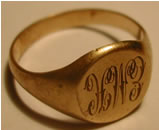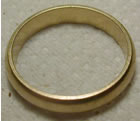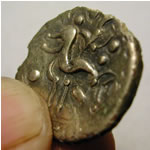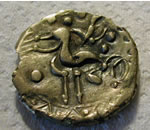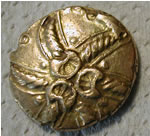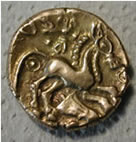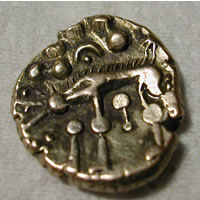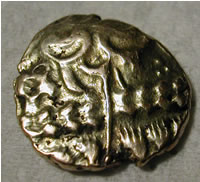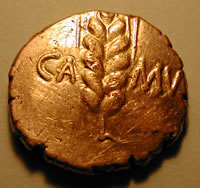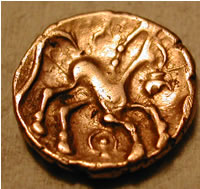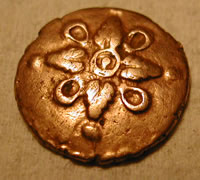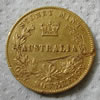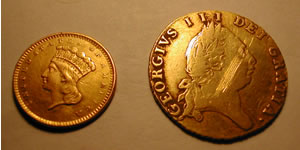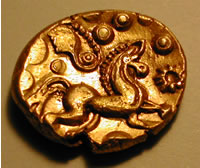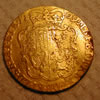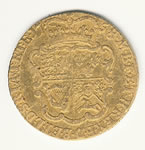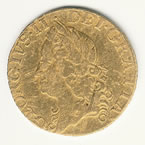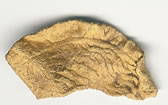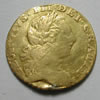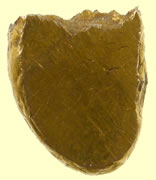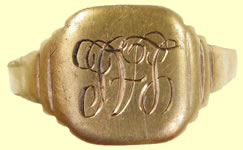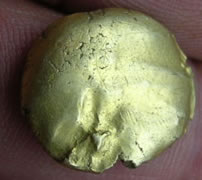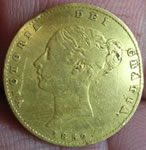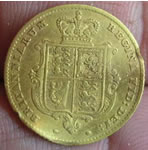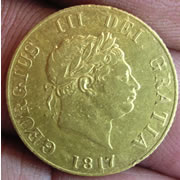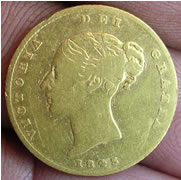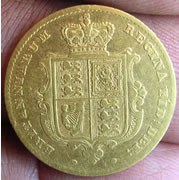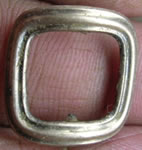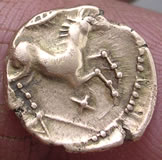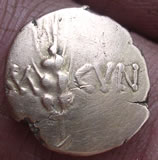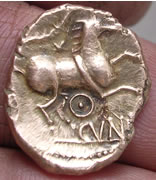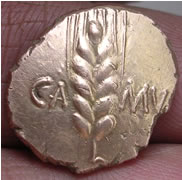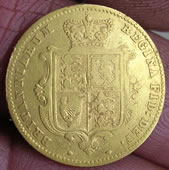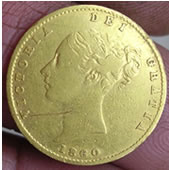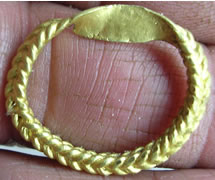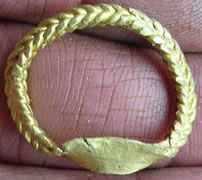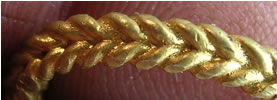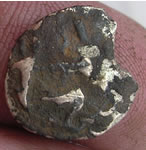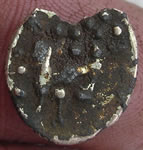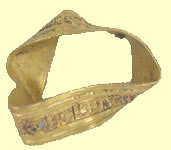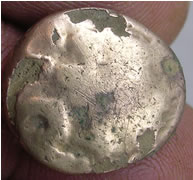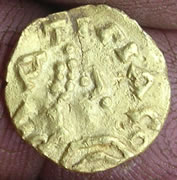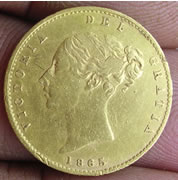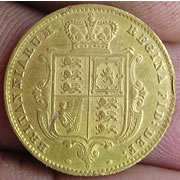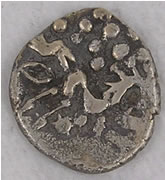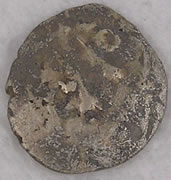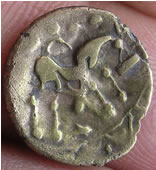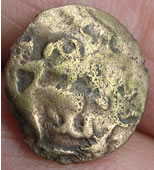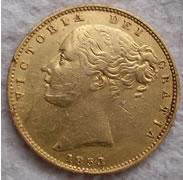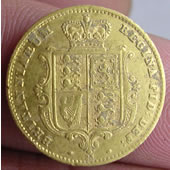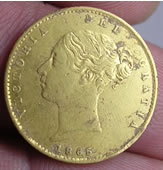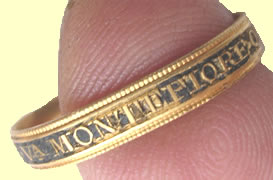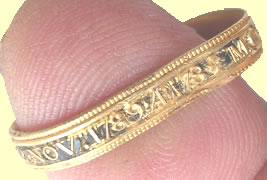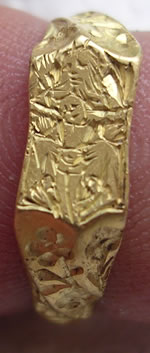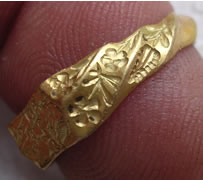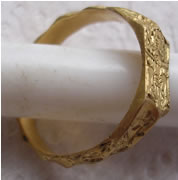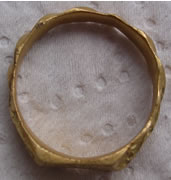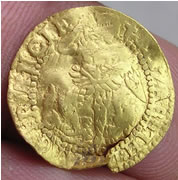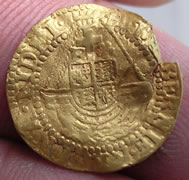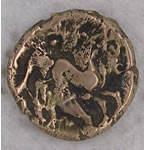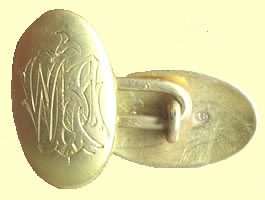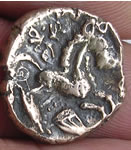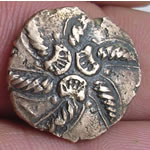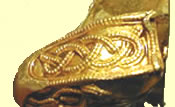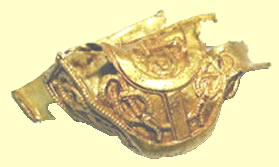|
All Celtic
gold finds are unique and registered with the Celtic coin index and
given an individual CCI number, comments against each coin are from
John Stills the expert that maintains this database.
Celtic
Coin index
Saxon gold
and silver finds are logged with the Fitzmuseum Cambridge
Fitzmuseum
Cambridge - coin database
Comments
and ID's against early Medieval coins are from Dr Martin Allen who runs
the National database at the Fitzmuseum
Hammered gold
is registered with the Medieval Corpus
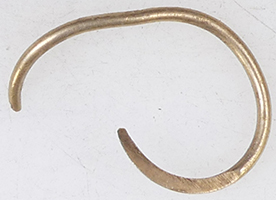 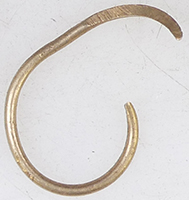
Interesting looking gold band
0.79g, 23.5mm L
 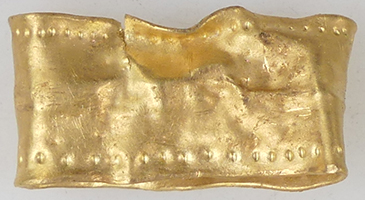
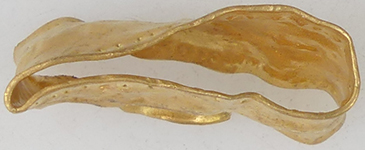 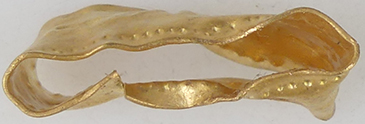
Ancient gold band - Bronze Age design c 1300 BC
3.8g, 28.6 mm L x 14.34 mm H x 0.6mm T
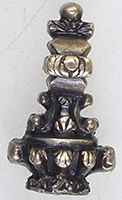 
Victorian gold fob seal holder top
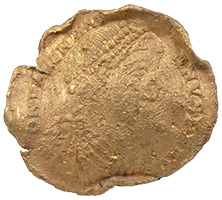 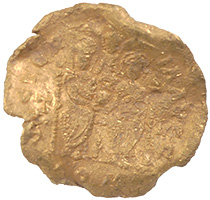
4.4g, 20.6mm
Great Find!
too bad it's so banged up, but I have seen jewelers' restorations of waffled and folded dug gold that look like they were never damaged.
Valentinian I, 364-365 AD
Obverse: D N VALENTINI-ANVS P F AVG / Reverse: VICTOR-IA AVGG
Valentinian I and Valens seated facing.
I can't make sense of the exergual mintmark which should be something like TR • OB if it's from the mint at Trier, as is likely for a British find - what I can see looks like COM [.]. There does appear to be T - R in the fields to left and right of the emperors, so maybe the exergue is actually COM • OB ("good gold")
If it were CON we'd have Constantinople, but according to my references, Valentinian I didn't strike this type of solidus at Constantinople (only at Trier, Siscia and Thessalonica)- so it's a little puzzling. Of course, I really don't see all that much Roman gold so I don't know all the ins and outs of the series.
A totally off-the-wall mint mark can sometimes be a marker for a contemporary copy (I hate saying ancient "counterfeit" or "forgery"), but it's a possibility.
Insofar as I can tell from the visible details, it looks like official Imperial workmanship. Also, gold typically comes out of the ground a bit cleaner than this since pure gold is non-reactive and doesn't accumulate the deposits you find on silver or bronze, so who knows?
If it gets cleaned up (I'd recommend mild detergent in warm water and gentle scrubbing with nothing stiffer than a cut-down toothbrush) send me new photos and I'll try to dial in the attribution more closely.
Cheers!
Mark
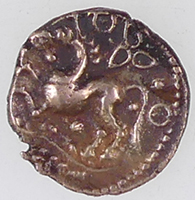 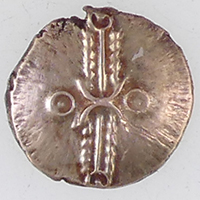
Dubnovellaunos 25 BC to 5 AD CCeltic gold qtr stater- reported to museum
1.36g, 12.34mm
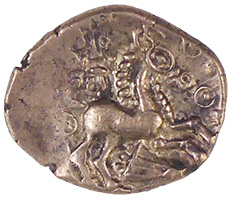 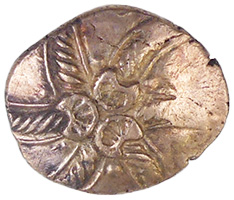
45 BC to 25BC Addedomarus Celtic gold full stater - Trinovantian tribe- reported to museum
5.45g, 20mm
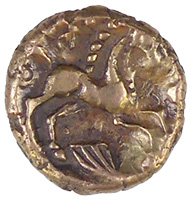 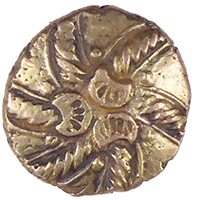
45 BC to 25BC Addedomarus Celtic gold full stater - Trinovantian tribe - reported to museum
5.48g, 15.9mm
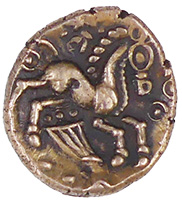 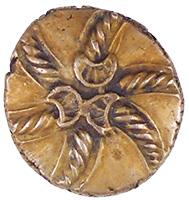
45 BC to 25BC Addedomarus Celtic gold full stater - Trinovantian tribe- reported to museum
5.48, 18.33mm
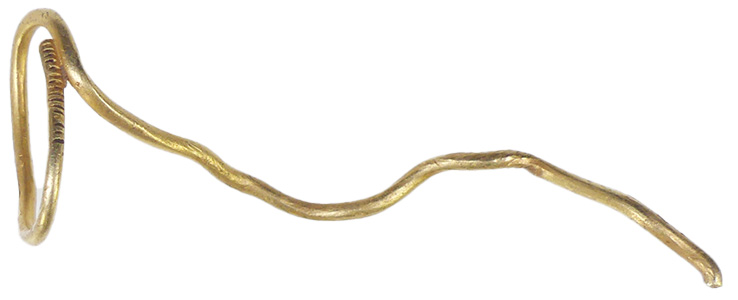
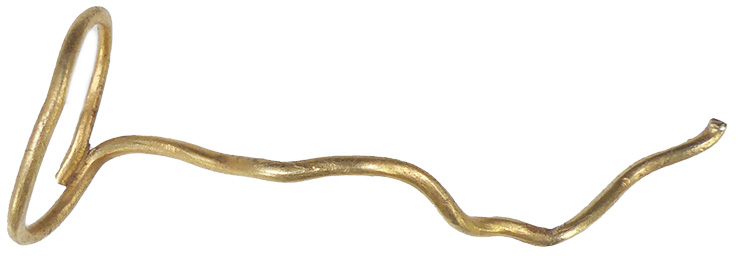
Anacient gold ring - reported as treasure to museum - possible viking
Top part of ring is soldered
5.2g, 68.2mm L
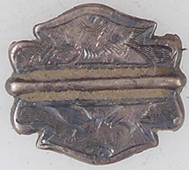 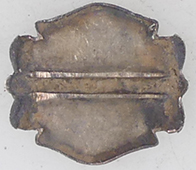
Victorian rose gold mount
 
1803 Gold ring - London date letter H -duty paid bust of George
1.0g, 22.3 mm L
Maker SG - Could be Saml. &
George but missing the W
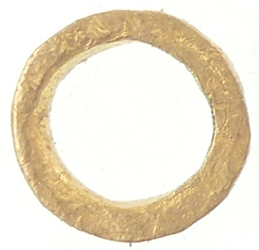 
Tiny 1300 BC gold ring - reported as treasure
0.36g, 6.7mm dia
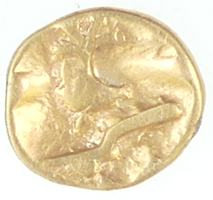 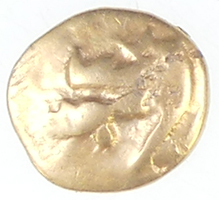
70BC Morini 'boat tree' Celtic gold qtr stater - reported to museum
1.42g, 10.21mm
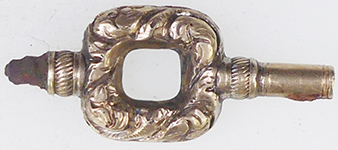 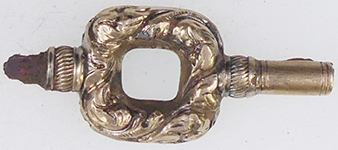
Victorian gold watch winder
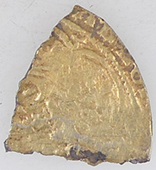 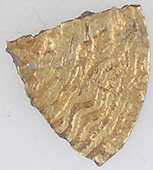
1351-1352 Edward III hammered gold noble fragment
Obv EDWARD DEI GRA REX ANGL Z FRANC D hYB
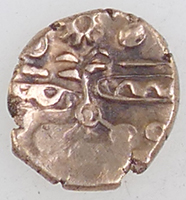 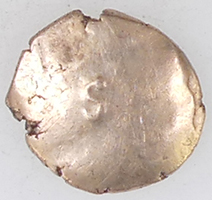
c50BC Celtic gold qtr stater
1.38g, 11.56mm
Latest views from the experts from previous coin we found
"it's an early (perhaps c. 50-40 BC) quarter stater, possibly produced in Essex.
It seems to have developed out of the Gallo-Belgic D quarter stater (Van Arsdell
69), imported in large quantities into Britain from Belgic Gaul, possibly with
some influence from the so-called 'Kentish trophy type' (Van Arsdell 147) of a
very similar period.
This particular type is unpublished in any major catalogue,
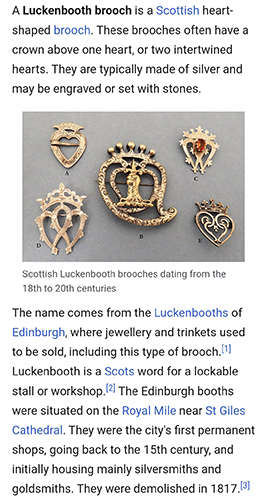 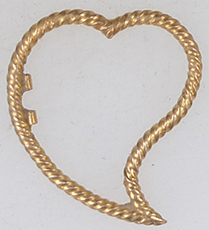 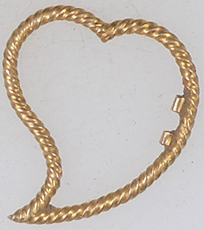
Gold Luckenbooth brooch - reported as treasure to museum
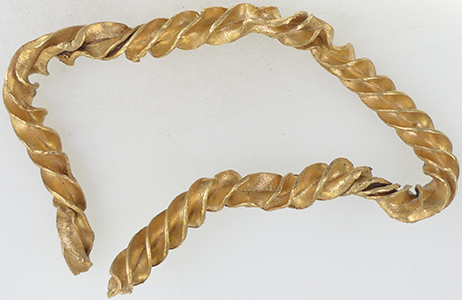 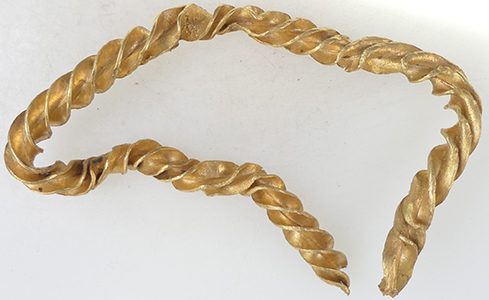
2nd - 1300 BC gold Torc - reported as treasure to museum
27.8g, 82.3 mm x 7.7 mm dia
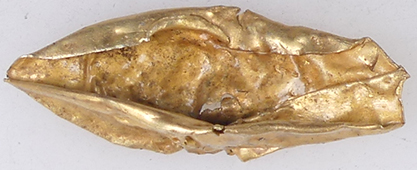 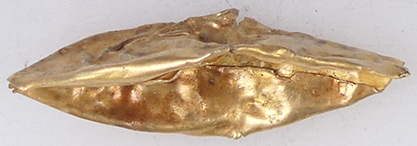
Ancient gold spoil - tested as over 14K - reported as potential treasure
1.93g, 31.05mm L x 1.25 mm T

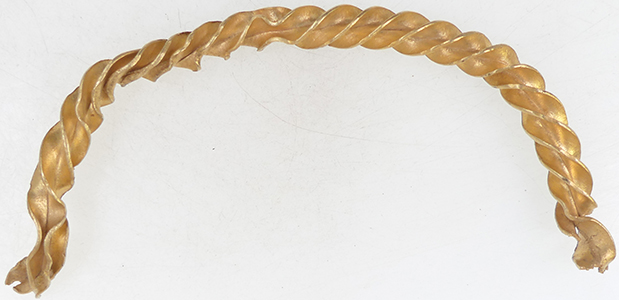
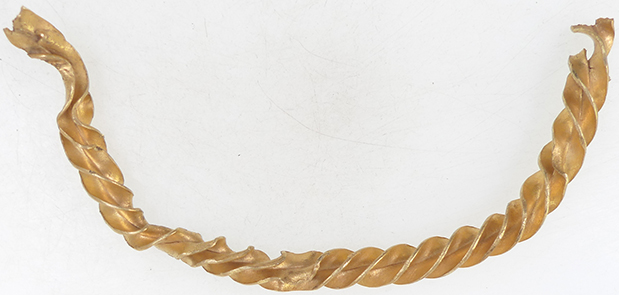
1300 BC gold Torc - reported as treasure to museum
0.7 oz, 20g
100mm x 7.7 mm dia
 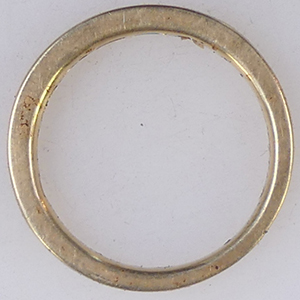
Interesting foreign 18k gold ring
Marked - ILIANA - 18K TJC 750*
4.31g, 22.1mm dia
Iliana Rings
Iliana is a TJC exclusive that hosts an impressive grade of rings, earrings, necklaces, and many such more jewellery pieces. Known for the exquisite styling and fancy moulding,
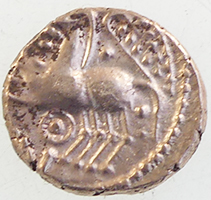 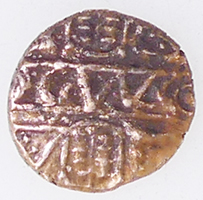
10-40 AD Cunobelin Celtic gold qtr stater - Biga type
1.28g,10.78mm
CELTIC, Trinovantes & Catuvellauni. Cunobelin. Circa AD 10-43. AV Quarter Stater Biga type (Trinovantian T) . Camulodunum (Colchester) mint. C(AMV)L in tablet, flanked by pellet-in-annulets, joined to vertical wreaths; alternating flower motifs and heart-shaped faces in quarters / Two horses galloping left, pellets above back and below tail; leaf above; four-spoked wheel below. CCI 20. 0297 (this coin); Kretz, Biga Early type A2, dies B/3; ABC 2807 var. (rev. pellets, style) Van Arsdell 1913-1 var. (same); SCBC 290. Usual tight flan.
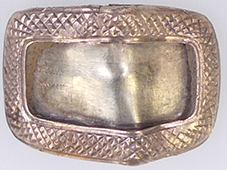 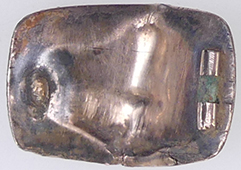
Georgian rose gold brooch
 
Ancient gold ring - reported as treasure
2.38g, 15.5mm W, 2.23g
 
Dubnovellaunos 25 BC to 5 AD Celtic gold stater
5.44g, 17.77 mm
 
1911 George milled gold half sovereign
4.0g, 19.3mm dia
The George V gold half sovereign coin, made from 22-carat gold by the Royal Mint. Sovereigns are a long-standing British coin used since the early 1800s and widely regarded as one of the most popular and reliable gold coins in existence.
These days the coins are no longer circulated currency, but offer a strong commemorative and historical value, and they are especially popular as gift items for anniversaries or christenings.
The obverse side of this coin bears the portrait of the King, facing left, with the usual latin written around George's head, while the reverse features Pistrucci's artwork of St George slaying a dragon.
These Half Sovereigns were produced between 1910 and 1926, but several years saw no production. These were:
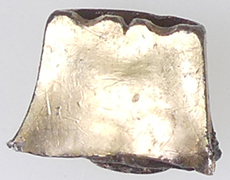 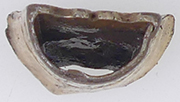 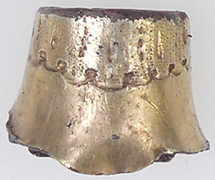
Victorian gold trim
 
25-35 AD Cunobelin Celtic gold stater
'plastic A' series, VA 2010-3. Believed to have preceded the classic type, so perhaps from c. 25 - 35 AD.
5.44g, 16.92mm
 
Georgian gold button
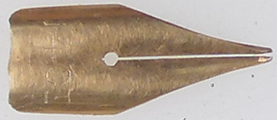 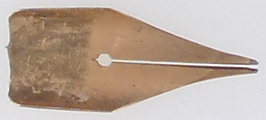
Gold pen nib
 
1829 gold ring - George IV duty paid symbol - London mint date letter O
Makers mark - A
2.65g, 21.9 mm
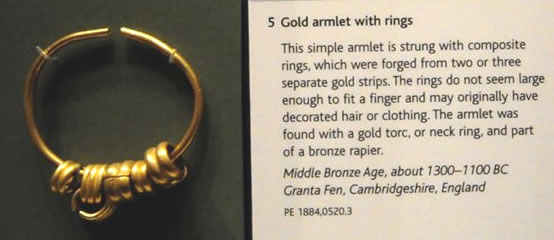
Complete item at British museum
  
1300 BC gold armlet ring- reported as treasure
2.0g, 12.68 mm x 1.61mm T x 7.4 mm H
2024-25
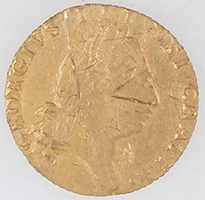 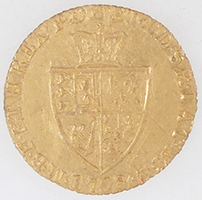
1798 George III milled gold half guinea - 4.143g, 2.044mm
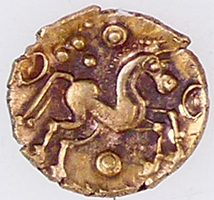 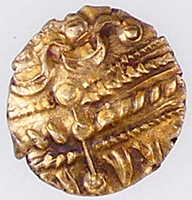
Heybridge Horse type Celtic gold qtr stater - Trinovantes tribe c50-BC - reported to museum
Wreath between two pellet lines,stylised locks of hair above, crescents and pellet ring motifs below
Horse r,large rump,various pellets around, pellet boss below ABC 2359
1.25g, 11.2mm
 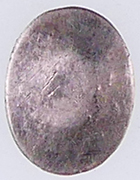
Victorian rose gold cufflink
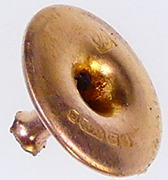 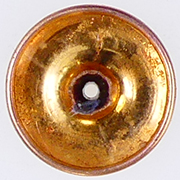
1871 Gold stud - Marked - 9 carat Birmingham Date letter W sideways anchor
Maker OP
Owen Powell
 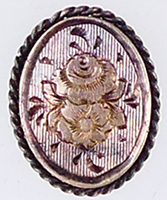
Georgian rose gold cuff link
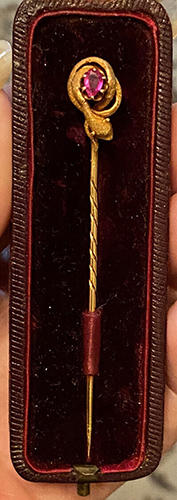 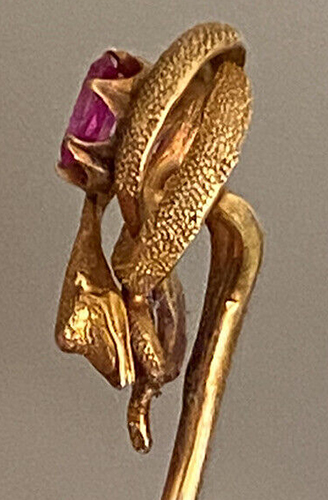
Cal Tony found this complete example on the web
Beautiful Antique Victorian Nouveau 18k Gold Natural Ruby Snake Stick Pin Box
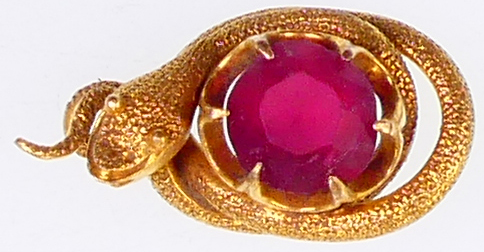 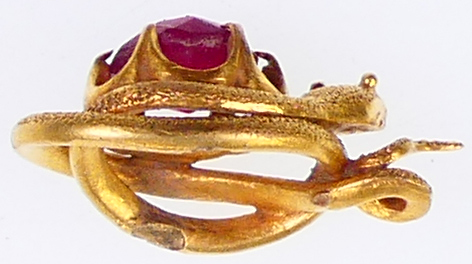
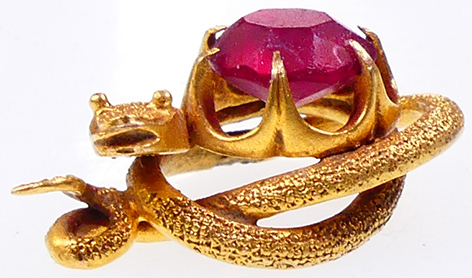
Stunning 1890 Victorian gold pin mount - natural ruby stone
2.54g, 19.45mm L
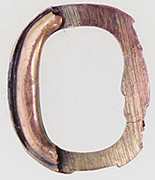 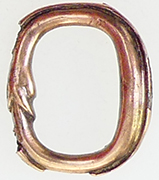
Victorian gold buckle
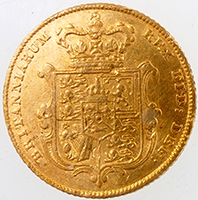 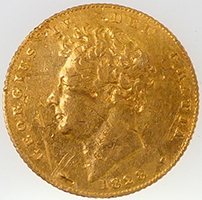
1828 George IV milled gold half sovereign
4 g, 19.36g
 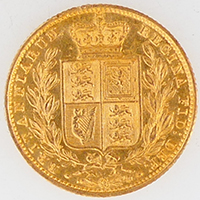
1854 Victoria milled gold sovereign
8g, 22.05mm
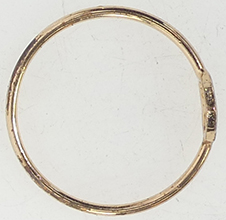 
Gold ring - no hall marks - 0.57g, 20mm
 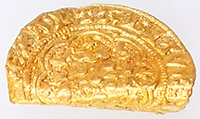
1361- 69 Edward III hammered gold qtr nobel - Treaty period, Large pellet at centre of reverse cross
Obv EDWAR DEI GRAC ANGL D
1.93g, 18.95mm
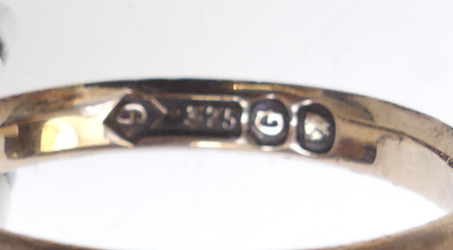 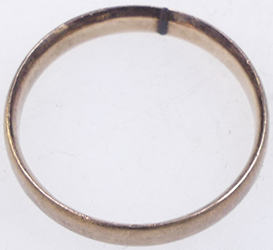

1882 - 9 Carat gold ring - London date letter G
1.76g, 19.5mm
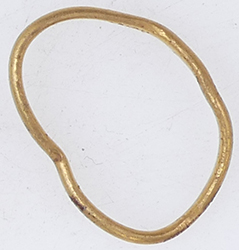 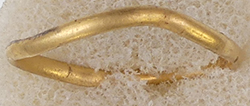 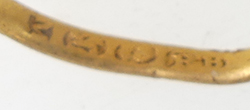
1807 - 22 carat gold ring - 1.51g, 21.5mm - London date letter M
Maker PB
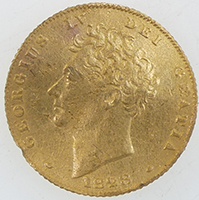 
1828 George IV milled gold half sovereign
3.96g, 19.31g
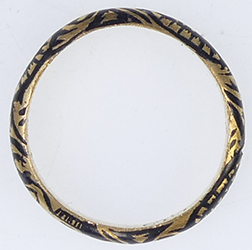 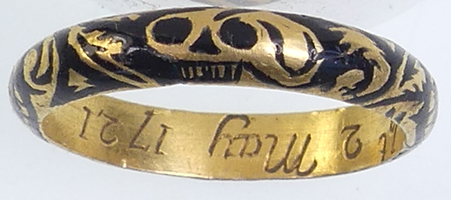
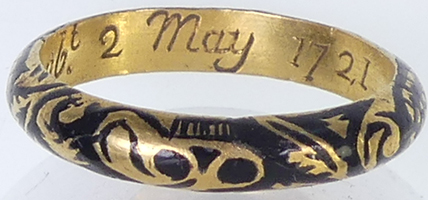 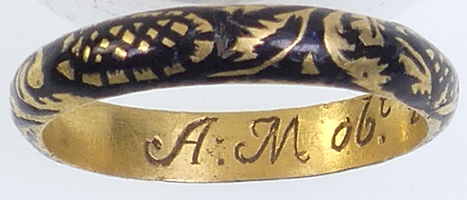
 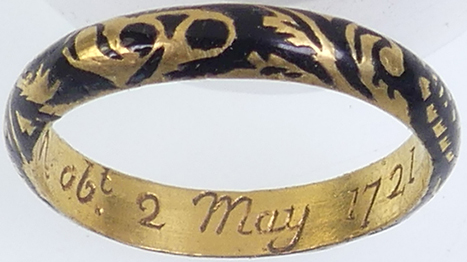
1721 Gold and black enamel mourning ring - reported as treasure
A.M obt 2 May 1721
Maker RD
5g, 22.13mm
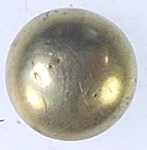 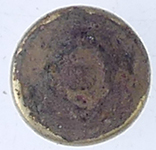
Georgian gold button
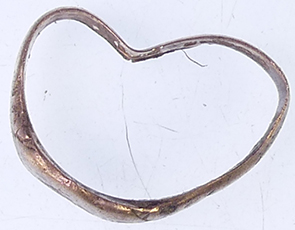 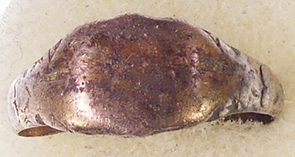
1863 Rose gold signet ring - Birmingam mint - date letter O - 9.375 (9 carat)
2.3g, 19.9mm
Maker CY BS
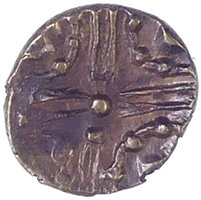 
25 BC Clacton Cross type, ABC 2356, the companion quarter to British F, the Late Clacton stater, ABC 2332. In ABC it's illustrated as a 'three men in a boat' design but the obverse is probably a degraded boar ; at the moment there are around 30 known, mostly from Essex and Suffolk so it's a definite Trinovantian type.
1.37g, 12.7mm


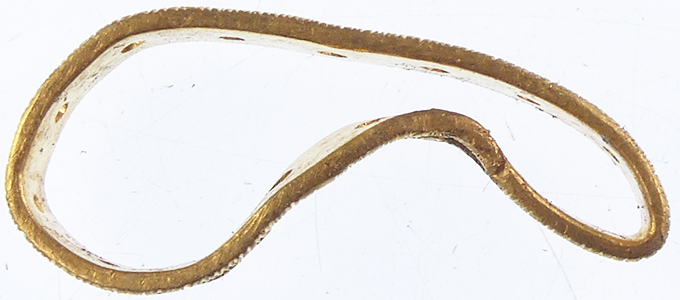
Early hand eteched and punched pure gold ring - reported to museum as treasure
1.69g,22.9mm L x 0.95mm T
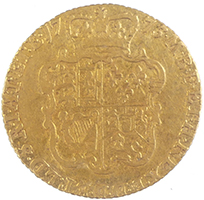 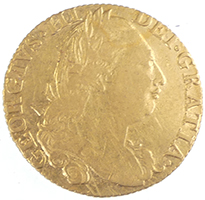
1775 George III milled gold guinea
8.29g, 24.5mm
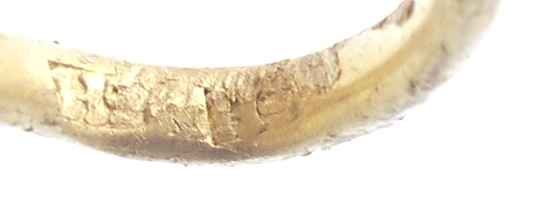
Makers mark damaged - - HS***HS or SH***SH - no hall marks
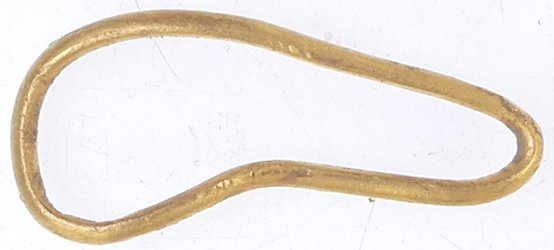
High carat gold ring - reported as potential treasure to museum
2.05g, 27.17mm -

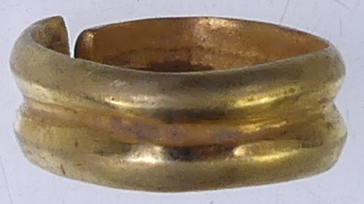 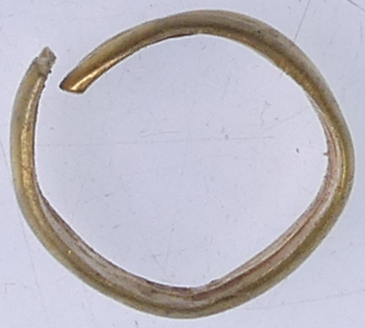
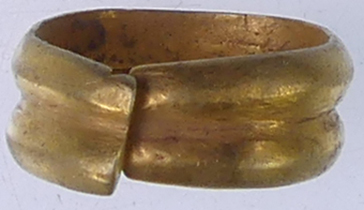
1300BC gold armlett ring
1.85g, 13.56mm dia x 5.04mm W
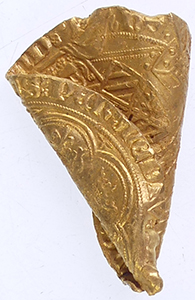 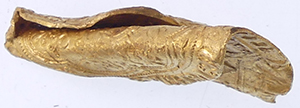 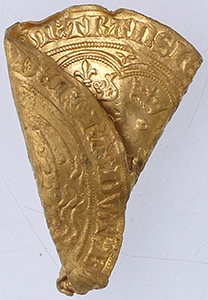
Flanders, Philip 'de Stoute' (The Bold), 1384-1404, Gold Noble,
Monster sized gold noble - almost an exact match as one above but it has a half rose on top of crown, two pellets left, one pellet right to ship front castle - similar legend with double satire stops.
Needs more research to get exact type
7.9 grams, 31mm

Flanders, Philip 'de Stoute' (The Bold), 1384-1404, Gold Noble, (Noble d'Or), in the style of the English Coinage
Brugge, Gand or Mechelen mint
.
Obverse: The Count standing facing in ship holding upright sword and quartered shield bearing the French and Burgundian arms, ship rigging with two ropes to left, and one rope to right, with Latin legend surrounding: P | HS | DEI : GRA : DVX : BVRG : COMES . Z . DNS : FLAND
Reverse: Large P at centre of ornamental floriated cross with lis terminals, crowned leopards in angles, trefoils in spandrels, all within a beaded and linear tressure, with Latin legend surrounding: + IhC .' AVTEM : TRANSIENS : PER : MEDIV : ILLORVM : IBAT
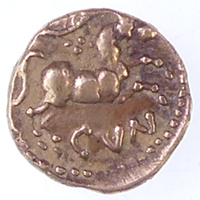 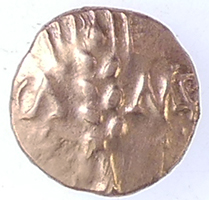
10-40 AD Cunobelin Celtic gold qtr stater - Plastic type - reported to museum
1.22g, 11.04mm
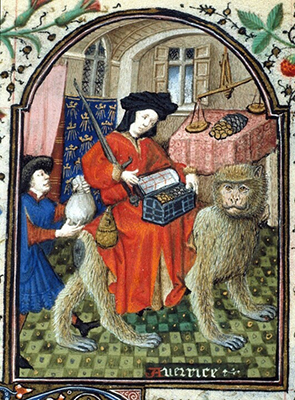
Medieval monkey picture
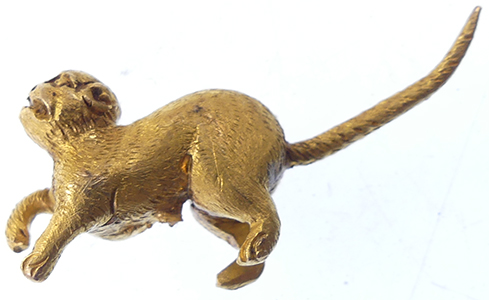 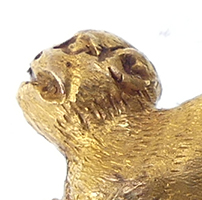 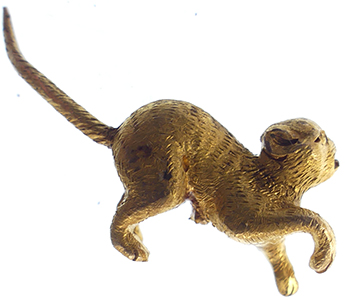
Stunning detailed high carat gold animal figurine - reported to museum as potential treasure
This was on a site with 1300 BC items found, Roman and Celtic gold finds so impossible to date - I will go for medieval
3.0g, 24.4 mm L x 3.9mm W
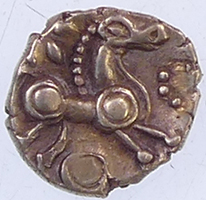 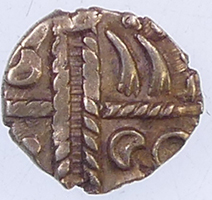
45- 40 BC
Raunds Wing type gold stater ABC 2466.
Wreath across corded line- Annulate horse r, sunburst above - pellet in ring below - Chrid Rudd 30.67 Extremely rare
Reported to museum
1.152g, 11.32mm
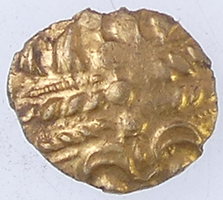 
Very rare Heybridge Horse type Celtic gold qtr stater - Trinovantes tribe c50-BC
Wreath between two pellet lines,stylised locks of hair above, crescents and pellet ring motifs below
Horse r,large rump,various pellets around, pellet boss below ABC 2359 Extemely rare
1.25g, 12.88mm
Reported to museum
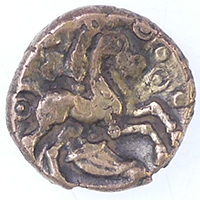 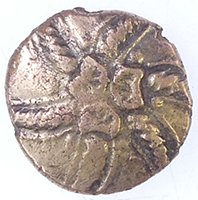
5 BC to 25BC Addedomarus - Trinovantian tribe
5.44g,16.96mm
Reported as hoard addendum coin to museum
Addedomarus (sometimes written A??edomarus on coins) was a king of south-eastern Britain in the late 1st century BC. His name is known only from his inscribed coins, the distribution of which seem to indicate that he was the ruler of the Trinovantes.
He was the first king to produce inscribed coins north of the Thames, perhaps as early as 45 BC, although some estimates are as late as 15 BC. He seems to have moved the Trinovantian capital from Braughing in Hertfordshire to Camulodunum (Colchester, Essex). For a brief period (ca. 15-10 BC) he seems to have been supplanted by Tasciovanus of the Catuvellauni, who issued coins from Camulodunum at that time. Addedomarus then appears to have regained power and reigned until 10-5 BC, when he was succeeded by Dubnovellaunus.
 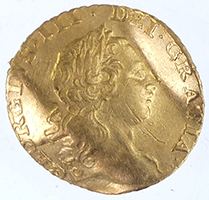
1762 George III milled gold qtr guinea - love token
2.07g, 15.63mm
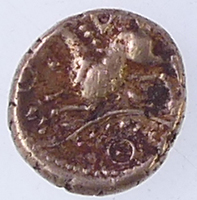 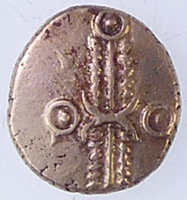
25BC Dubnovellaunus Celtic gold qtr stater
1.307g, 10.32mm
Dubnovellaunos 25 BC to 5 AD
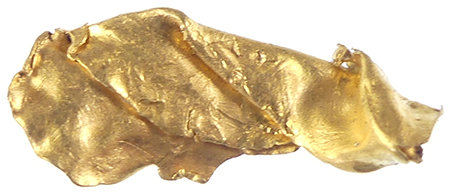 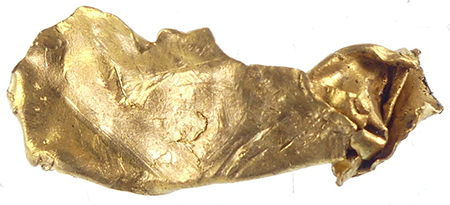

Ancient gold sheet - 0.65g, 17.5mm L
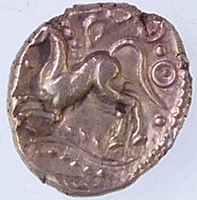 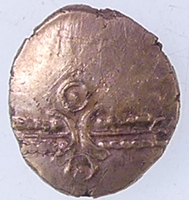
25BC Dubnovellaunus Celtic gold qtr stater - reported to museum
1.37g, 12.52 mm
Dubnovellaunos 25 BC to 5 AD
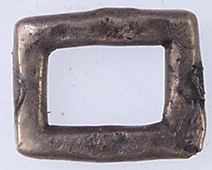 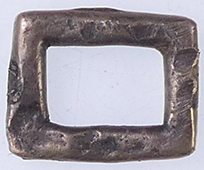
Victorian rose gold buckle
| |
2023/24
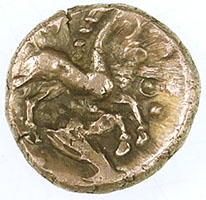 
45BC Addedomaros Celtic gold stater - disclaimed and returned to finder
5.52g, 16.82mm
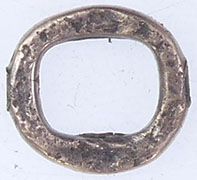 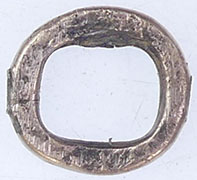
Rose gold jewelry item
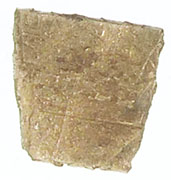 
Ancient gold sheet - 0.5g, 9.28mm L x 073mm T



Spectacularly crafted multi stranded BC gold band - reported to museum as treasure
1.19g, 21.6mm L x 5.83mm W x 1.1 mm T
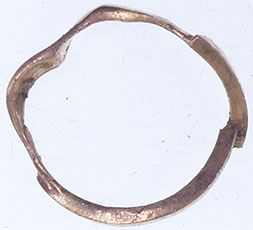  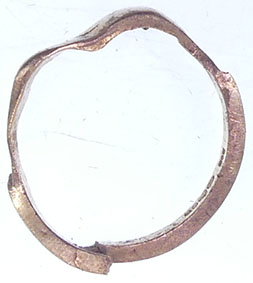
1999 - 9 carat Gold ring -1.394g, 21.93mm - Birmingham hall mark - 0.375 - date letter Z
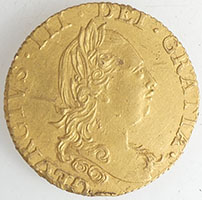 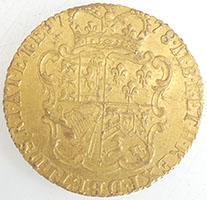
1778 George III milled gold half guinea 4.2 g, 20.5mm
 
Pure gold finger ring - 0.77g, 23.16mm- no hall marks
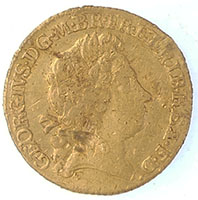 
1717 George 1st milled gold half guinea
4.16g, 20.84mm
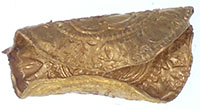 
1422 - 61 Henry VI hammered gold qtr noble - London - Lis mint mark
Obv hENRIC DEI GRA REX ANGL
Rev **REX A ** IV
1.735g, 19.83mm
 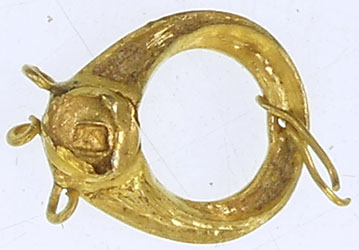
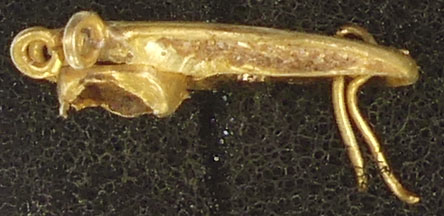
Facinationg medieval gold find - reported to museum as treasure
1.38g, 16.17mm L x 12.58 W
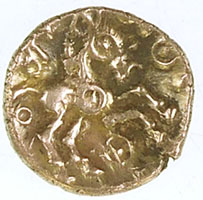 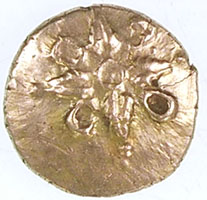
45 BC to 25BC Addedomarus - Trinovantian tribe Celtic gold qtr stater - floral type
1.352g, 12.3mm dia
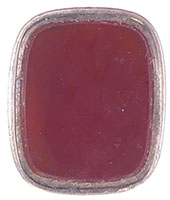 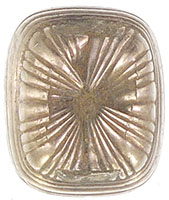
Georgian gold fob seal chain decoration
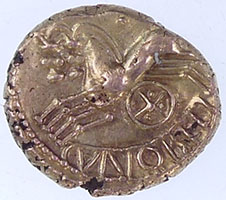 
10-40 AD Cunobelin Celtic gold stater - biga type - reported to museum
camvl in garnished tablet on vertical wreath, heart-shaped symbols in quarters, rev. biga left, leaf above, wheel and [cvnobelin] below (ABC 2771;
5.44g, 19.03mm
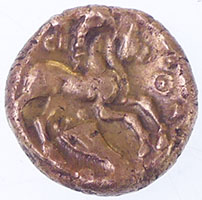 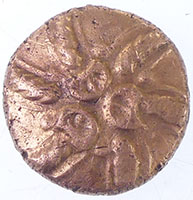
45 BC to 25BC Addedomarus - Trinovantian tribe - reported to museum Addedomarus (sometimes written Aθθedomarus on coins) was a king of south-eastern Britain in the late 1st century BC. His name is known only from his inscribed coins, the distribution of which seem to indicate that he was the ruler of the Trinovantes. 5.52g, 16.87mm
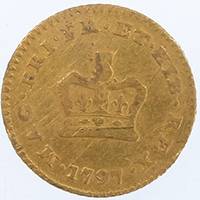 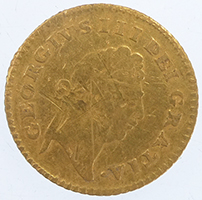
1797 George III milled gold third guinea
2.76g, 16.85mm
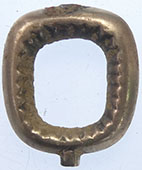 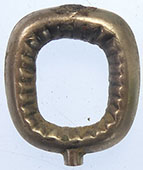
Georgian watch winder
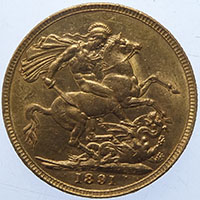 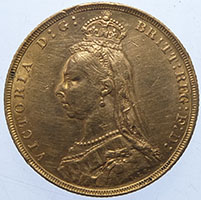
1891 Victoria milled gold full sovereign
8.0g, 21.92mm
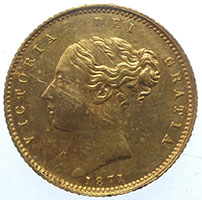 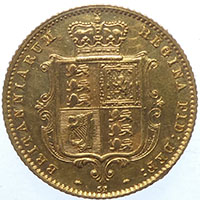
1871 Victoria milled gold half sovereign
3.99g, 19.37mm
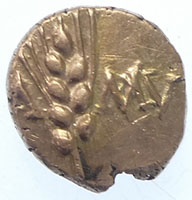 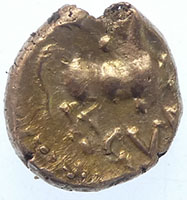
10-40 AD Cunobelin Celtic gold qtr stater - reported to museum
1.33g, 10.76mm
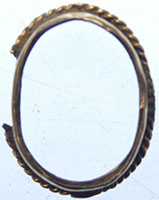 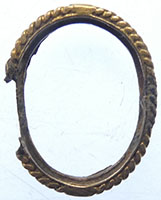
Georgian gold bezel




Ancient gold strip - reported to museum
3.01g, 62.4mm L x 4.6mm W x 0.85mm T
 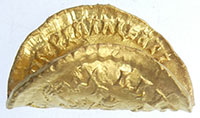 
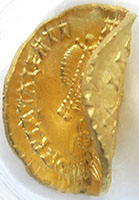 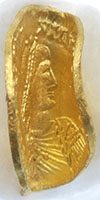 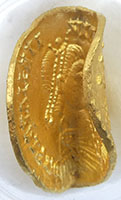
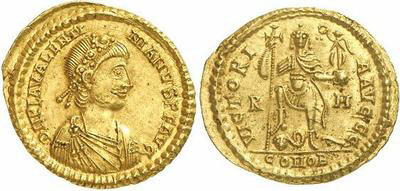
5thC Roman gold coin - 4.36g, 21.03mm
- sent for ID
Valentinian III, 425-455 AD.
AV solidus (your metrology goes here)
Mint of Rome, 425-6 AD. or 440-455 AD.
Obv: D N PLA VALENTINIANVS P F AVG diademed, draped and cuirassed bust of Valentinian III right
Rev: VICTORIA AVGGG valentinian in military garb standing facing, holding long cross and Victory on globe; R - M in fields // COM OB (in exergue)
Cf. RIC X 2005-6 or 2014-2015
Mark
 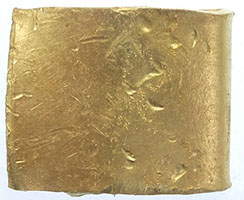 
Gold spoil probably 6th C - reported as treasure to museum
13.7g, 16.09 mm L x 1.39 mm T
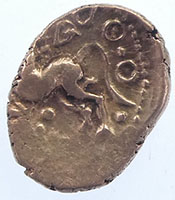 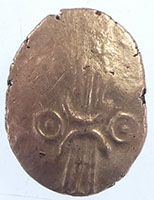
Dubnovellaunos 25 BC to 5 AD Celtic gold qtr stater
1.35g, 13.19 mm
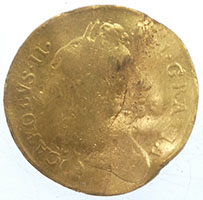 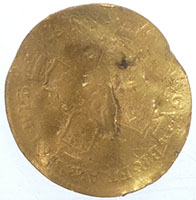
1672-84 Charles II milled gold half guinea- 2nd bust - 3.72g, 21.38mm
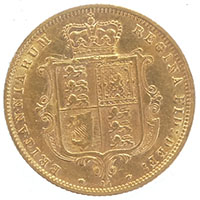 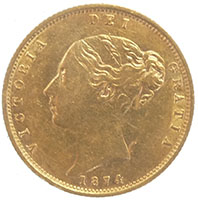
1874 Victoria milled gold half sovereign 3.99g, 19.42mm
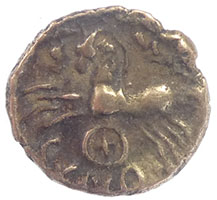 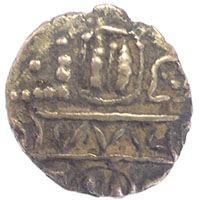
8-13 AD Cunobelin biga type qtr gold stater
1.32g, 12.01mm
 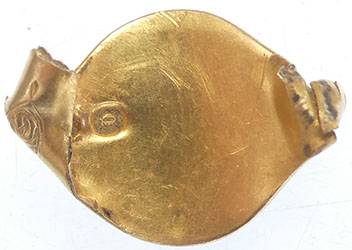
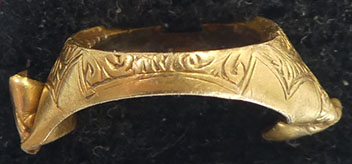
1865 Gold ring - date letter Q matches Birmingham
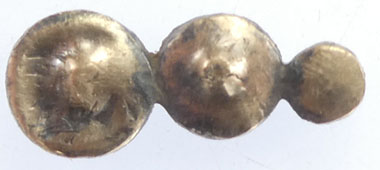 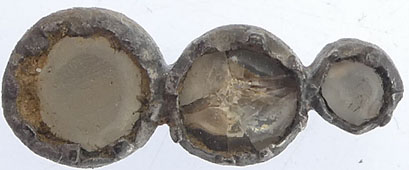
Victorian Rose gold jewellry fragment
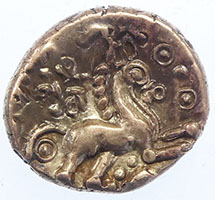 
5.56g, 18.62mm
45 BC to 25BCAddedomarus - Trinovantian tribe
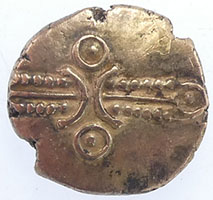 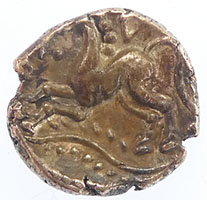
1.33g, 10.57mm
Dubnovellaunos 25 BC to 5 AD Celtic gold qtr
 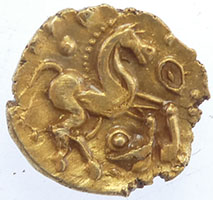
1.26g,12..33mm
70BC uninscribed 'Q' Gold - 'Remi 'Type Celtic gold qtr stater
The Remi were a Belgic people of north-eastern Gaul (Gallia Belgica). The Romans regarded them as a civitas, a major and influential polity of Gaul,The Remi occupied the northern Champagne plain, on the southern fringes of the Forest of Ardennes, between the rivers Mosa (Meuse) and Matrona (Marne), and along the river valleys of the Aisne and its tributaries the Aire and the Vesle.
 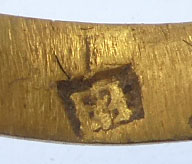
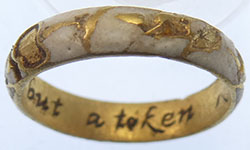 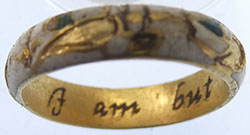
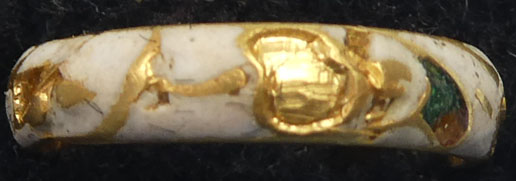



17thC enamelled gold posy ring-reported as treasure to museum
'I am but a token'
1.73g, 15mm
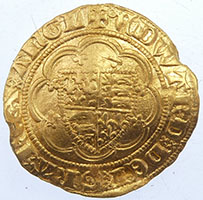 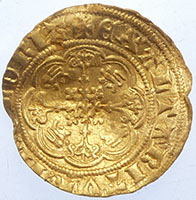
Quarter-noble, fourth coinage 1351-77, Treaty period 1361-1369, Tower mint, mintmark cross potent, annulet before Edward-Lis in centre, double satire stops
Obv shield quartered with the arms of England and France within a treassure of eight arches
Obv +oEDWARD xx DEI xx GRAxxREX xxANGL
Rev +EXALTABITAR IN GLORIA
1.92g, 19.6mm
 
Early bevelled plain gold ring - no hallmarks - reported to museum as treasure
1.81g, 18.96mm
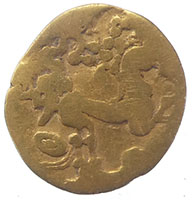 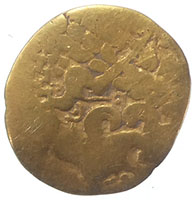
Mid 2nd C BC Gallo- Belgic A type 175 BC Celtic gold qtr stater - 1.68g, 14.85mm

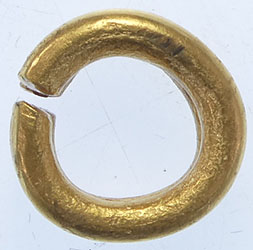 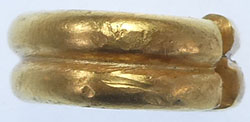 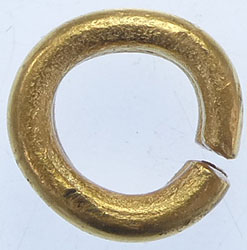
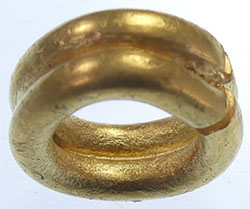 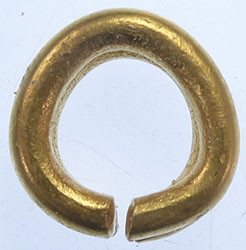
1300 BC gold armlet ring - reported to museum as treasure
6.42g, 14.22mm dia, 5.66mm T
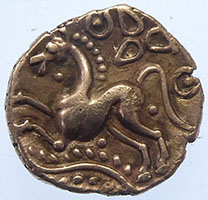 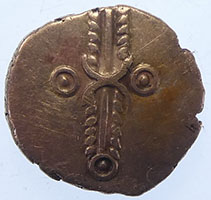
Dubnovellaunos 25 BC to 5 AD Celtic gold qtr stater
1.24g, 12.38mm
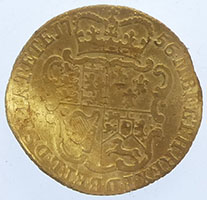 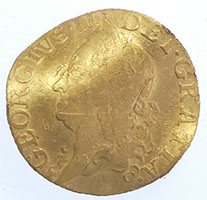
1756 George II milled gold half guinea - love token 4.077g ,20.64mm
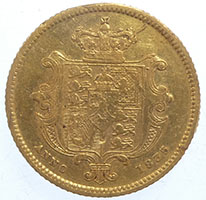 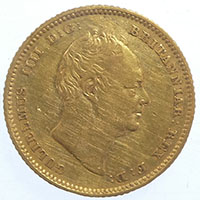
1835 William IV milled gold half sovereign
3.96g, 19.27mm
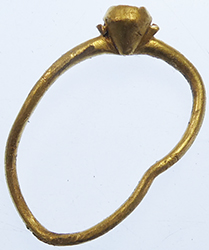 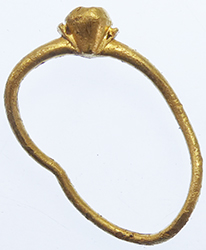 
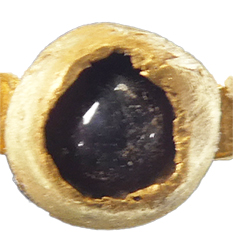
Medieval gold ring with ruby - reported as treasure to museum
1.835g, 24.29mm
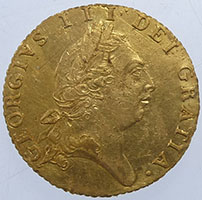 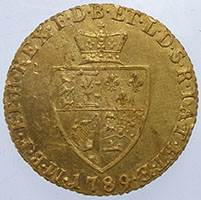
1789 George III milled gold half guinea
4.2g, 20.7mm
|
2022/23 Total so far 39
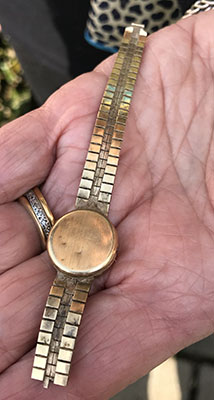 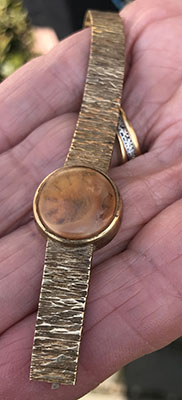
Solid gold watch
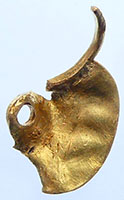 
19thC gold tooth plate
0.6g, 19.1 mm
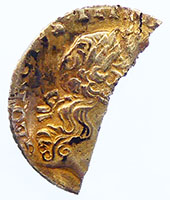 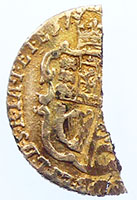
18thC George III milled gold qtr guinea
0.79g, 15.1mm
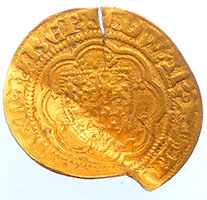 
1.81g, 20.1mm
This coin is a mule with two dies series B&E Edward III (1351-61), Quarter-Noble, 1, fourth coinage, Pre-Treaty period, series B/E mule, mm. cross 1, edwar’ r[ ] angl’ z franc’ d hyber, royal arms on shield, pellet below, rev. + exaltabitvr in ghloria, annulet stops, floriate cross,, trefoil and lion in each angle, eight-arc double tressure Mint mark Cross 1 Obv +EDWAR o R oANGL Z FRANC o D o hYB ER
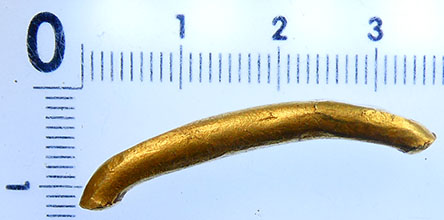 

Gold wrist Torc fragment ? reported as treasure to museum 8.1g, 35mm L x 4.9mm dia
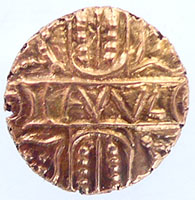 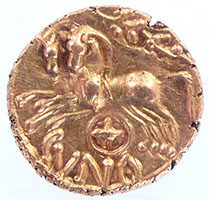
1.35g, 11.49mm
8-13 AD Celtic gold Cunobelin qtr stater- Bigga type- reported to museum
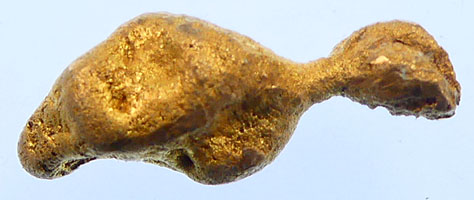 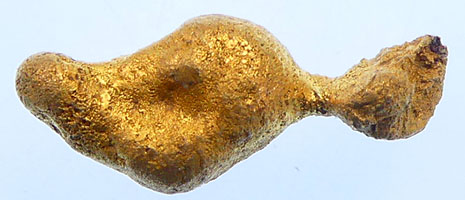
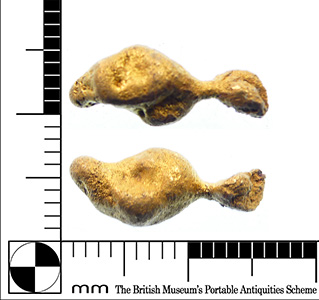
Ancient gold nugget - 16.01mm L x 6 mm T
2.94g
  
1850 Birmingham mint - 22 carat gold ring - star mark
 
Georgian gold watch winder
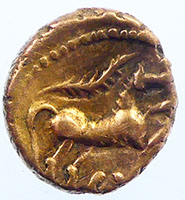 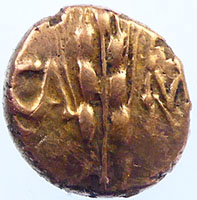
10-40 AD Cunobelin Celtic gold qtr stater- reported to museum
1.424g, 11.04mm
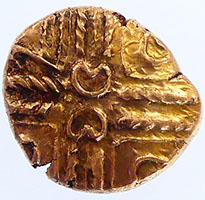 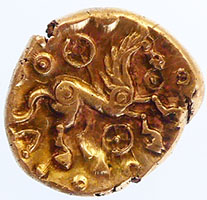
5.47g,18.21mm
Pictures from the field |
50 BC Middle Whaddon Chase stater Celtic gold full stater Obv cross of 3 plain & 2 pellet lines with 2 opposed crescents b in centre
Rev horse r ., above pellet in ring, pellet in wheel below
Middle Whaddon Chase stater, VA 1491, BMC 343, ABC 2240. An extremely rare type, only 7 others known, very nice to see another one. This one seems to be from the same obverse die as 95.2630, same rev as CR 116, 2011, no. 32. Reverse similar to early staters of Addedomaros but an uninscribed type, much rarer.
John Sills |
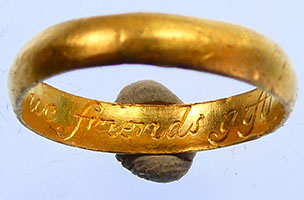 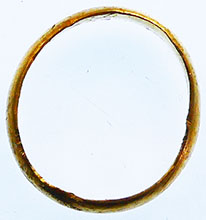
C17thC - reported as potential treasure
'A true friends gift'
No hallmark - marker mark ?EM
2.87g, 17.53mm

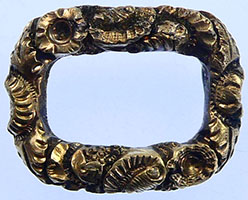 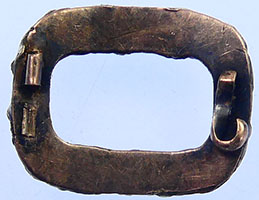
Georgian gold shoe buckle
 
Gold earing marked 9 carat gold Italy
4.06g, 51.56mm L

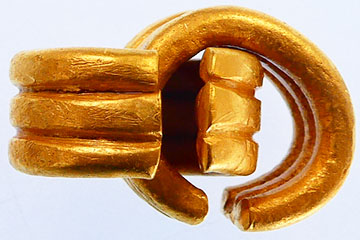 
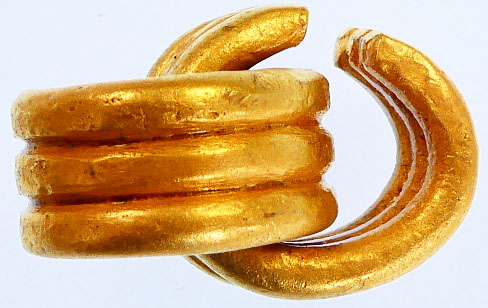
Stunning pair of solid gold 1300 BC armlet rings - reported to museum as treasure
16.42g - 16mm dia
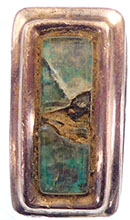 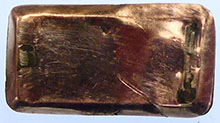
Victorian rose gold brooch
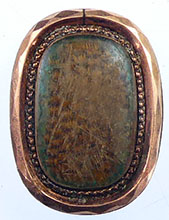 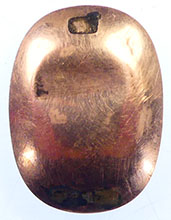
Victorian rose gold brooch
 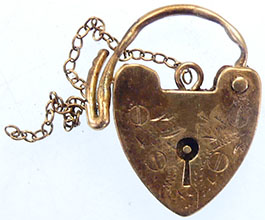
Victorian gold jewelry padlock
Marked 9 carat gold
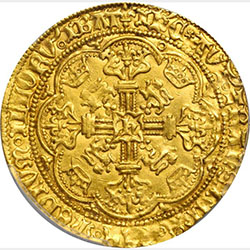 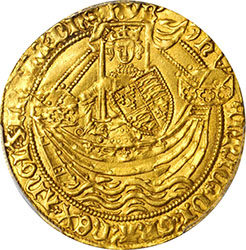
 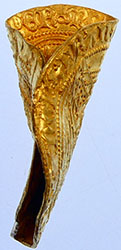 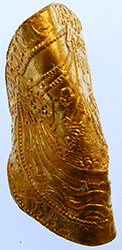 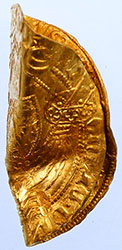
Henry VI (First reign, 1422-1461), Annulet issue, Noble, London, mm. lis on rev. only, annulet by wrist
Medieval hammered gold noble
6.999g,32.91mm
Gold noble - annulet issue - trefoil stops
Obv hENRIC DI GRA REX ANGL Z FRANC DNS *hYB
Rev PERo MEDIVM o ILLORV o IBAT + *** BAAo
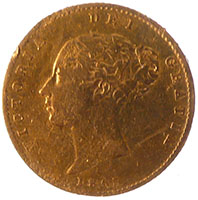 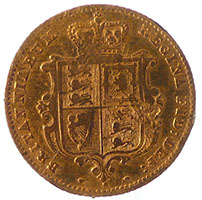
1865 Victoria milled gold half sovereign
3.9g,19.3mm
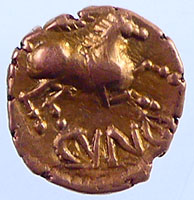 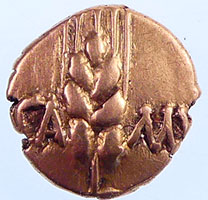
10-40 AD Cunobelin Celtic gold qtr stater - sent to museum for recording
1.3g,11.12mm
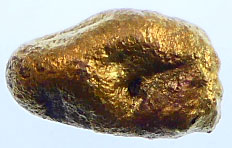 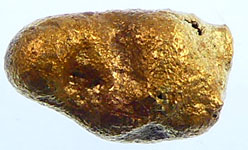
Ancient gold nugget - reported as treasure to museum
0.61g, 7.70 mm L
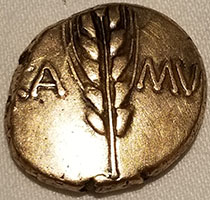 
10-40 AD Cunobelin Celtic gold stater - reported to museum
5.5g, 17.97mm
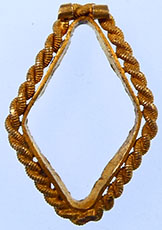 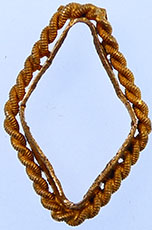 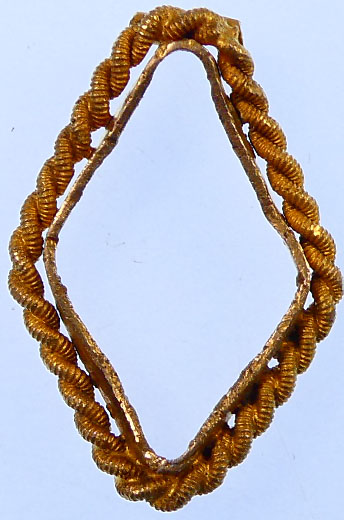
Facinating gold find - what looked initially like a Georgian bezel when blown up looks a lot earlier in date - sent to museum for their views
1.2g, 20.82mm
 

Ancient gold sheet - reported as treasure to museum
8.65g, 30.47mm L x 20.93mm W x 1.39mm T
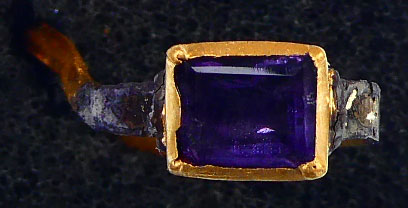 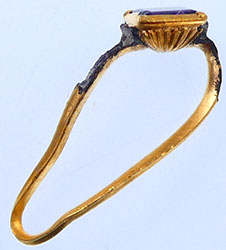 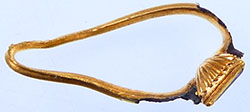
Medieval gold ring with amethyst - contemporary crudely repaired - reported as treasure to museum 1.33g,29mm
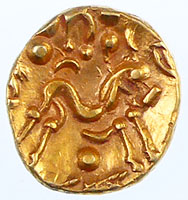 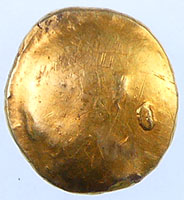
50 BC Gallo Belgic Celtic gold stater - reported to museum
6.11g,18.0 mm
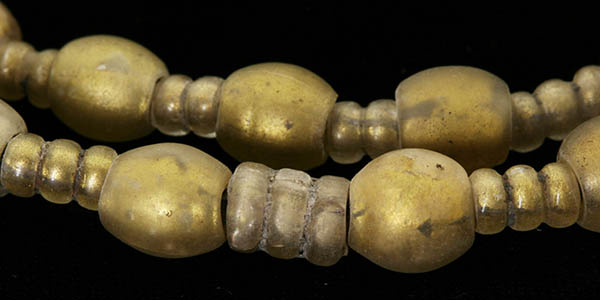
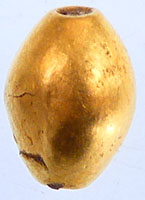 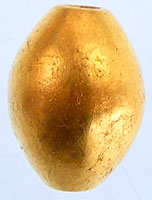 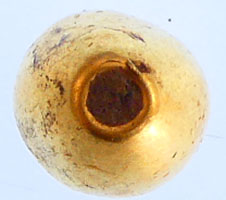
Gold bead - museum feedback is Roman 1stC - reported as treasure
1.1g,10mm L
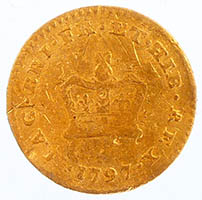 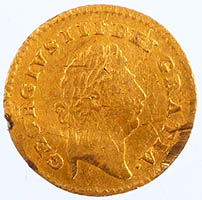
1797 George III milled gold third guinea
2.72g, 16.3mm
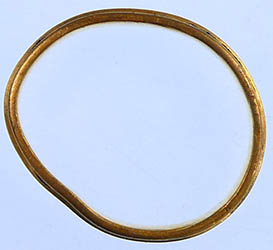 

Closer inspection shows the construction as an of ancient origin - reminds me of the 1300 BC gold ring type
Enamel inlay ? no hall marks - reported as treasure to museum
2.08g, 21mm dia
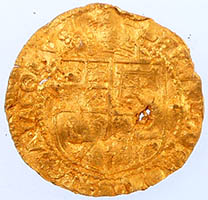 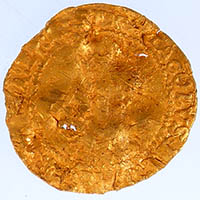
1604-5 James 1st hammered gold Britain crown - Lis mint mark
2.43g, 20.85mm
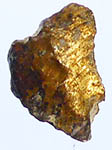 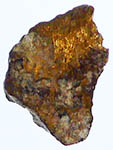
Gold nugget
0.302g, 10mm L
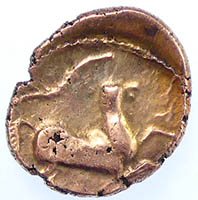 
10-40 AD Cunobelin Celtic gold stater - reported to museum
5.36g, 19mm
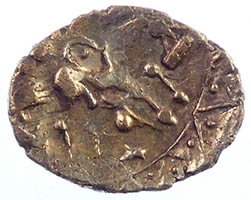 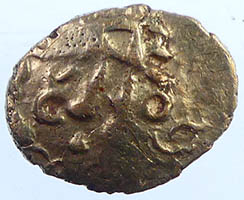
Trinovantes British G “Clacton” quarter, Hobbs 192 Celtic gold 1/4 stater 50BC - reported to museum
Chris Rudd 23.41 Clacton de Jersey - Classed as scarce
1.34g,15.1mm
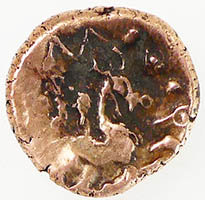 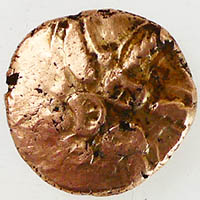
50 BC Addedomarus Celtic gold stater - reported to museum
Addedomarus (sometimes written Aθθedomarus on coins) was a king of south-eastern Britain in the late 1st century BC.
5.52g,16.65mm
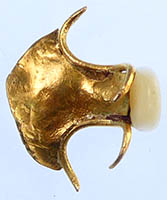 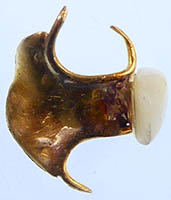 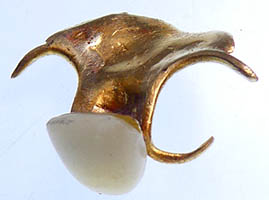
20thC gold denture plate and single tooth
 
Georgian plated gold cuff link
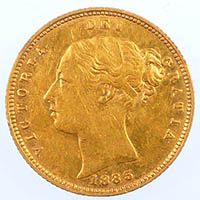 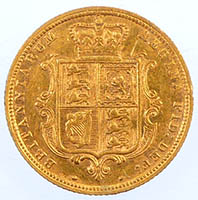
1885 Victoria milled gold half sovereign
3.99g,19.2mm
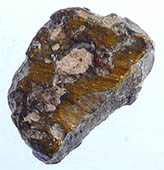 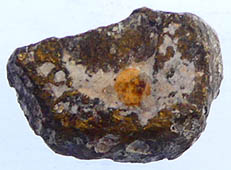
Gold nugget
2021/22 Total 22 pieces
 
20th C Gold ring with diamonds ? Marked 375
  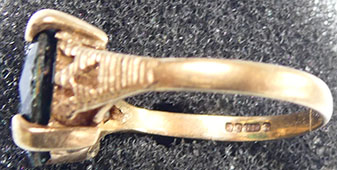
1977 gold ring with stone - London hall mark 0.375
Maker JWF
2.0g, 17.4mm
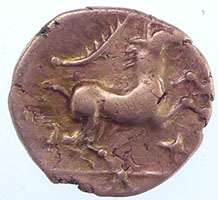 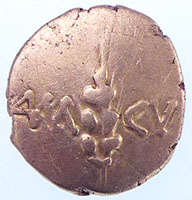
Agr- AD 35-43 Celtic gold qtr stater.
Corn ear without central stalk, CAM to L,CVN to R, , Horse rearing r, dashes to main, branch above, cross below, A in ex.
Extremely rare ref ABC 2999 Rudd 17.28
Suggested AGR is a Roman name like Agrippa or Agrippina.
12.36mm, 1.245g
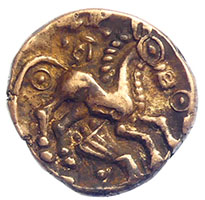 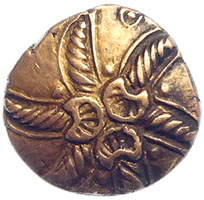
45BC Addedomaros Celtic gold stater - reported to museum
4.84G,17.38mm
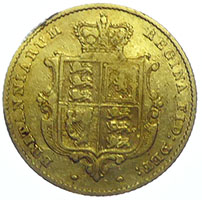 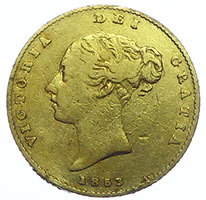
1853 Victoria milled gold half sovereign
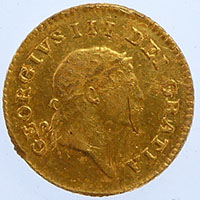 
1808 George III milled gold 1/3 guinea
2.81g, 16.99mm
 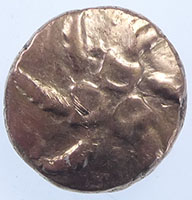
45BC Addedomaros Celtic gold stater - reported to museum
5.5g, 16.67mm
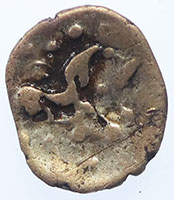 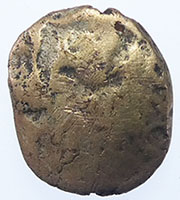
Trinovantes British G “Clacton” quarter, Hobbs 192 Celtic gold 1/4 stater 50BC - reported to museum
Chris Rudd 23.41 Clacton de Jersey - Classed as scarce
1.053g,13.75mm
 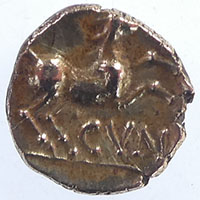
10-40 AD Cunobelin Celtic gold qtr stater - reported to museum
Wild type - Corn ear without cental stork CA to l, MV to r.
Horse r, dashes for mane, branch above, CVN below VA2015 Classed as Scarce
1.366g, 10.89mm
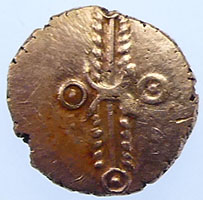 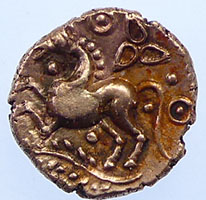
c. 20 BC-AD 10 Eastern uninscribed Celtic gold qtr stater of Dubnovellaunos
12.19mm,1.34g
Dubnovellaunos in Essex quarter, VA 1660, BMC 2442, ABC 2395
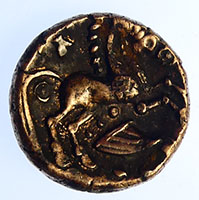 
45 BC to 25BC Addedomarus Celtic gold stater - Trinovantian tribe
5.55g, 17mm dia
Addedomarus (sometimes written Aθθedomarus on coins) was a king of south-eastern Britain in the late 1st century BC.
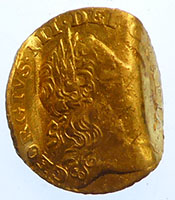 
1762 George III milled gold qtr quinea
16mm, 2.04g
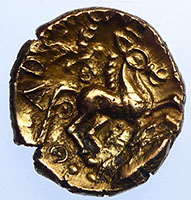 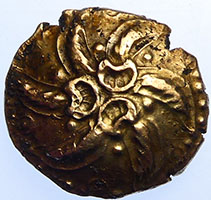
45 BC to 25BC Addedomarus Celtic gold stater - Trinovantian tribe -Sent to museum for recording
5.43g, 19mm dia
Addedomarus (sometimes written Aθθedomarus on coins) was a king of south-eastern Britain in the late 1st century BC.
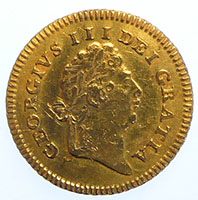 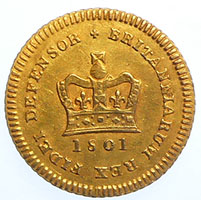
1801 George III milled gold 1/3rd guinea
2.80g,17mm
- Laureate Bust - Legend "FIDEI DEFENSOR + BRITANIARUM REX"
- Gold
- Laureate Bust - Legend "·MAG·BRI·FR·ET·HIB·REX·"
- Gold
 
Celtic gold qtr stater - 9.45 mm,1.26g - Sent to museum for recording
Cunobelin wild type quarter, VA 1935, ABC 2813
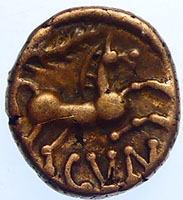 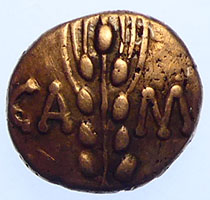
Celtic gold qtr stater - 11.11 mm,1.32g - Sent to museum for recording
looks like a
Northern Gold 'Linear type' - pellet over M
Obv corn ear,to 1 CA, to r.MV
Rev horse r ., pellet, leaf q & pellet, below CVN, pellet boarder va
  
C1351 Edward III hammered gold qtr noble ?? - totally taco'd
1.78g, 23mm
  

21st June - 28th May 1837 - London hall mark - Victoria duty paid bust , maker S.S (Samuel Strahan)
0.6g, 16mm dia
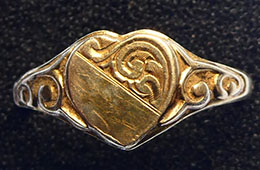 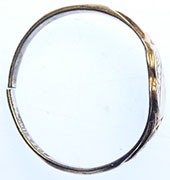
20thC gold signet ring
 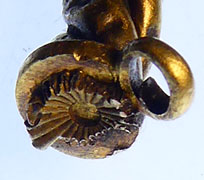
Victorian twisted rope gold brooch
3.54g, 42 mm L
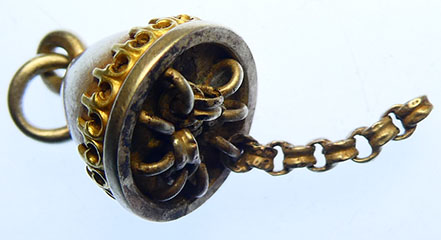 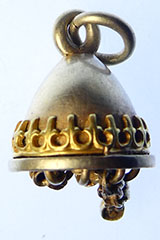 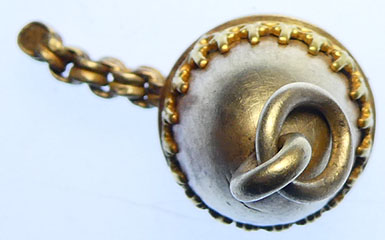
Victorian silver and gold pendant
2.72g, 12mm dia
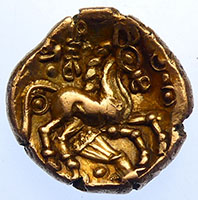 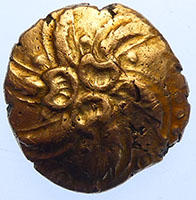
45 BC to 25BC Addedomarus Celtic gold stater - Trinovantian tribe
5.52g, 18.37mm
Addedomarus (sometimes written Aθθedomarus on coins) was a king of south-eastern Britain in the late 1st century BC.
|
2019/20 - 41 total
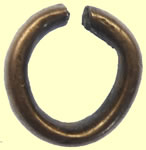 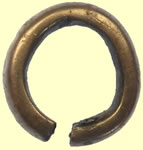
Gold link
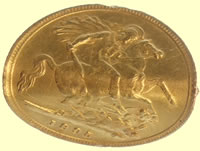 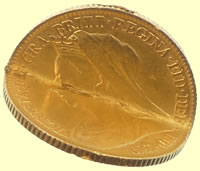
1895 Victoria milled gold half sovereign - Old bust George and Dragon type
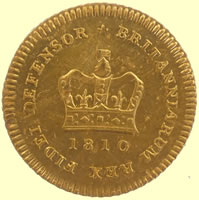 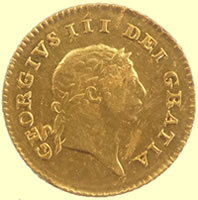
1810 George III milled gold third guinea
2.82g,17.02mm
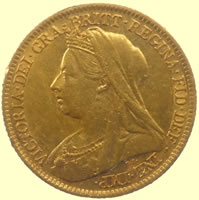 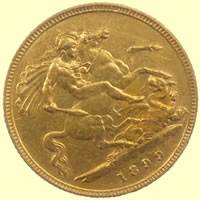
1899 Victoria milled gold half sovereign -- Old bust George and Dragon type
3.99g, 19.30mm



Ancient bright yellow gold band - very interesting concave inner to the ring and the pointed end - reported to museum as treasure
It came from the field where we aslo found a 1300 BC Bronze Age tress gold ring treasure
2.94g,28mmL
 
10 AD AD Cunobelin Celtic gold qtr stater - reported to museum and CCI for recording
plastic A' series, VA 2010-3. Believed to have preceded the classic type, so perhaps from c. 25 - 35 AD.
1.33g,10.50mm
It's an early Classic quarter, class 7a, DK 588, with a Classic type design but dies cut by an engraver who had previously worked on the Plastic series, which is why it has the 'look' of a Plastic type.
If you could let me know which parish it was found in I'll add it to the card,
All the best
John
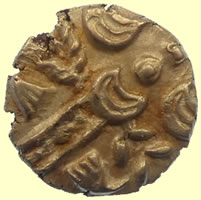 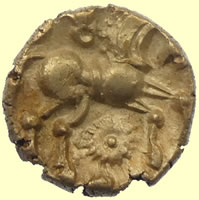
70BC Remi Celtic gold qtr stater - reported to museum and CCI for recording
1.13g,10.00mm
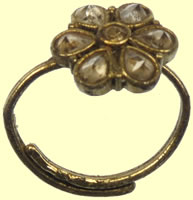 
20thC gold ring
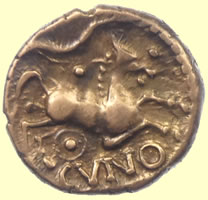 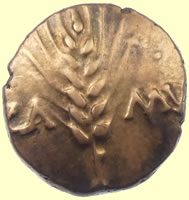
10-40 AB Cunobelin Celtic gold stater - sent to museum and CCI for recording
17mm,5.38g
A standard Plastic type Cuno stater, no unusual features as far as I can see, I've recorded it as 19.3908.
Best Wishes
John



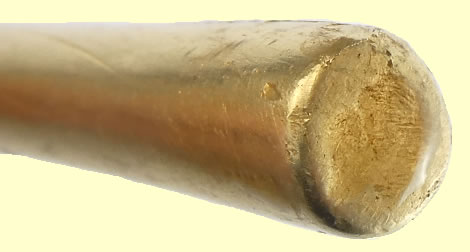
1300BC gold Torc
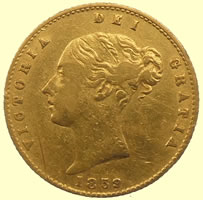 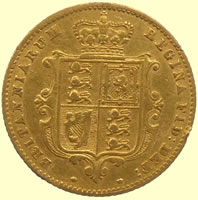
1859 Victoria milled gold half sovereign
3.97g, 19.3mm
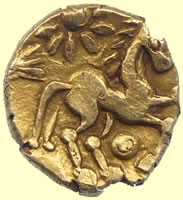 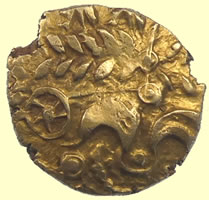
Early 70BC uninscribed 'Q' Gold - 'Remi 'Type Celtic gold qtr stater
Possible Maldon wheel - reported to museum and CCI
1.33g,11.61mm
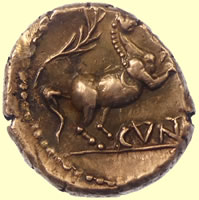 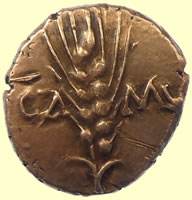
10-40 AB Cunobelin Celtic gold stater - sent to museum and CCI for recording
18.25g,5.42g
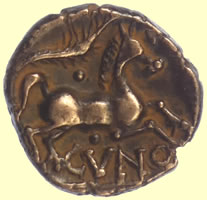 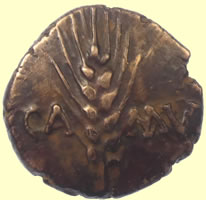
10-40 AB Cunobelin Celtic gold stater - sent to museum and CCI for recording
17.33,5.41g
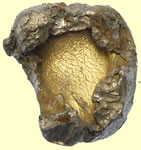 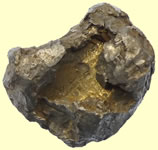
Gold tooth
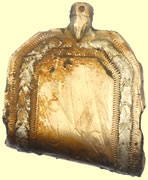 
Inlaid Georgian gold watch winder
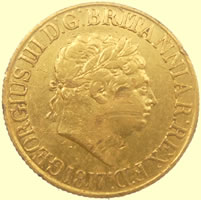 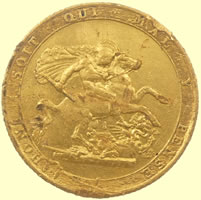
1817 George III milled gold full sovereign
8.02g,22.17mm
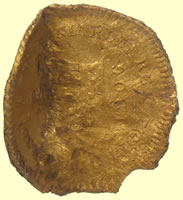 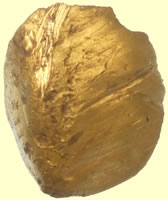
1806 George III milled gold third guinea
2.58g,17,8mm
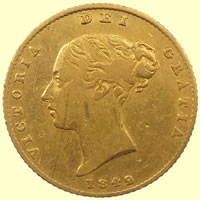 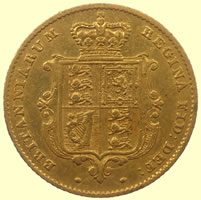
1842 Victoria milled gold half sovereign
3.99g,19.30mm
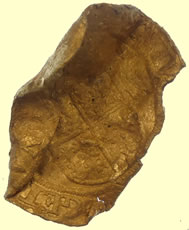 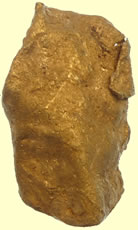 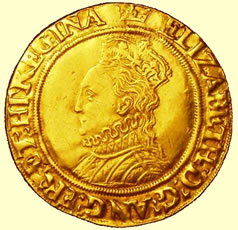 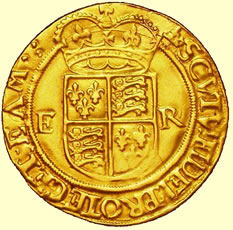
1560-1 Elizabeth 1st hammered gold half pound coin - (10 shillings, 120 pence) - Crown mint mark
28.8mm,5.11g
5.06g
Spink ref S2520
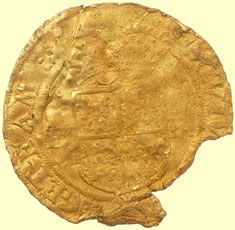 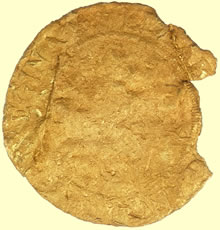
Fixed Elizabth 1st hammered gold half pound coin
 
1984 gold ring - Birmingham hall mark 0.375 - date letter K
LLIP markers mark
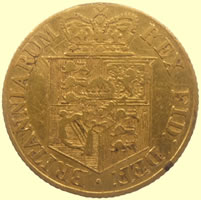 
1820 George III milled gold half sovereign
3.94g,19.36mm
 
25BC Eastern uninscribed Celtic gold qtr stater of Dubnovellaunos
Reported to museum and CCI
1.32g,11.75mm
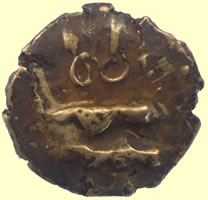 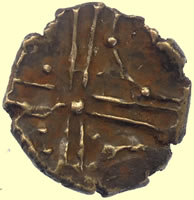
25 BC Clacton Cross type, ABC 2356, the companion quarter to British F, the Late Clacton stater, ABC 2332. In ABC it's illustrated as a 'three men in a boat' design but the obverse is probably a degraded boar ; at the moment there are around 30 known, mostly from Essex and Suffolk so it's a definite Trinovantian type.
Martin
Reported to museum and CCI
1.41g,13.88mm
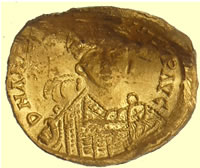 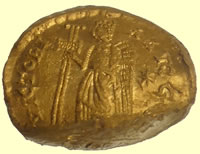 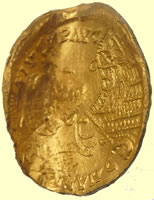 
5thC Roman gold sent for ID- my quick guess below
Anastasius AV Solidus. 491-518 AD. 4.41 g. Constantinople. DN ANASTA-SIVS PP AVG, helmeted and cuirassed bust three-quarter face to right, holding spear over right shoulder and shield on left arm / VICTORI-A AVGGG and officina letter, Victory standing left, holding long jewelled cross, star to right (rarely: a cross). Mintmark CONOB. Sear Byz. 3; DO 3-5; MIB 3-5.
Byzantine currency, money used in the Eastern Roman Empire after the fall of the West, consisted of mainly two types of coins: the gold solidus and a variety of clearly valued bronze coins. By the end of the empire the currency was issued only in silver stavrata and minor copper coins with no gold issue.
4.46g, 20.23mm
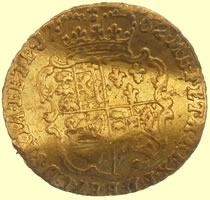 
1762 George III milled gold quarter guinea
2.07g, 16mm
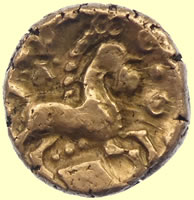 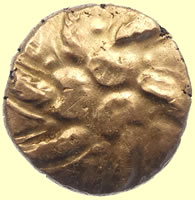
45 BC Addedomarus Celtic gold full stater - reported as hoard addendum coin to museum
5.54g,17mm
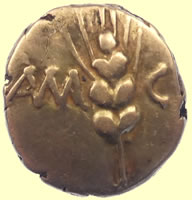 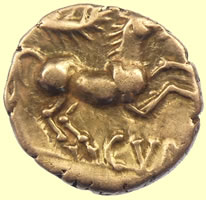
10- 40 AD Cunobelin Celtic gold qtr stater -reported as hoard addendum coin to museum
1.35g,11mm
 
Victorian gold jewelry chain ring - Lion hall marked London
1.05,12mm dia
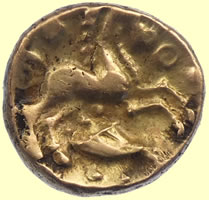 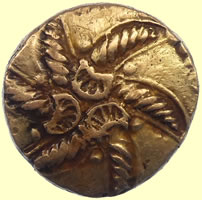
45 BC Addedomarus Celtic gold full stater - reported as hoard addendum coin to museum
5.44g, 17mm
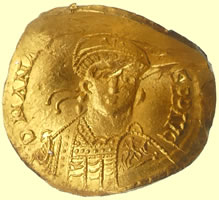 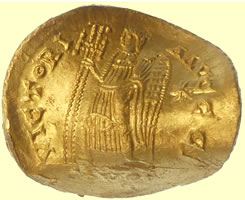
5thC Roman gold ID'd by Mark Lehman
Very cool! I’m always impressed by the gold you folks find – it looks like it won’t be too terribly hard a job to straighten it out.
Anastasius, 491-518 AD.
AV solidus (your metrology here)
Mint of Constantinople
Obv: D N ANASTA-SIVS PP AVG
helmeted and cuirassed bust of Anastasius three-quarter face to right, holding spear and shield
Rx: VICTORI-A AVGGG (I?) <– officina designation character
Victory standing left holding voided cross; to right, star // CONOB
SBCV 2; DOC 3-5
It’s easy (to the extent that it is easy) because gold doesn’t get encrusted or corroded. However, I get to work on so little gold that it’s hardly like the “in my sleep” identification of things like common LRB’s. But you’re right, not too much of a challenge. I wish I could tell you it was a rare type, but this is among the most common (and is the earliest) “Byzantine” solidus. This general type, however, the facing armored bust and Victory holding voided cross solidi, goes back well into the late Roman tradition, beginning probably at least a century prior to Anastasius “hybrid” reign (he’s considered both the final “Roman” emperor and the first Byzantine emperor in the numismatic community as it was he who introduced the typical Byzantine large Æ coinage with M, K, I, E etc, marks of value on the reverses in ca 498 and so has both Roman-style and Byzantine-style Æ coinages.
Mark
4.51g, 19.5mm
 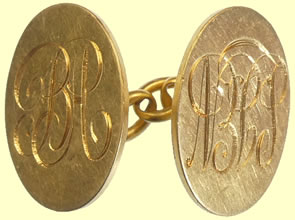
Stunning 18 carat gold monogrammed cuff links - Dated June 1899
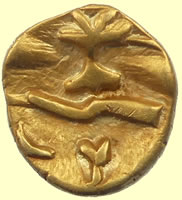 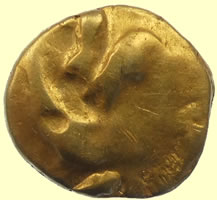
70BC Morini Celtic gold qtr stater - sent to museum for recording
11mm,1.48g
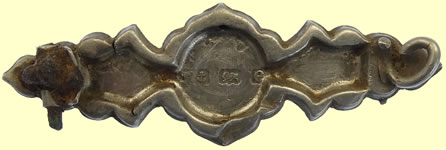 
1904 Birmingham mint - Rose gold brooch
 
1344-51 Edward III hammered gold qtr nobel - Standard C type
Obv +EDWAR D G R EX ANGL Z *** hYB - E at centre on obverse -satire stops
Rev: + EXALTABITUR IN GLORIA I
Obv shield quartered with the arms of England and France within a tressure of six arches (early coin)
2.04g,20mm
 
Victorian gold ring - Maker KB & P
1.03g, 17mm
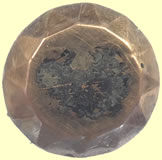 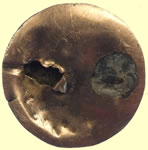
Victorian gold button
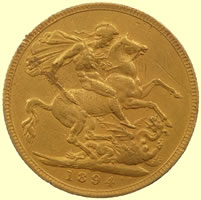 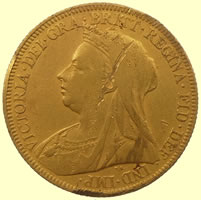
1894 Victoria milled gold sovereign
22mm,7.95g
 
Gold ring - 20mm,1.45g
Makers mark SC
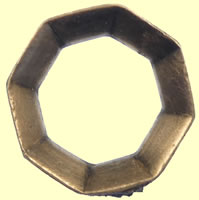 
Gold ring 1.46g,14mm
|
| 2018/19 season total 63 |
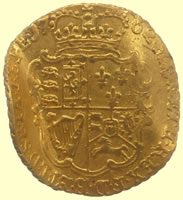 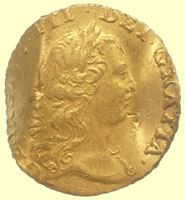
1762 George III milled gold half guinea - love token
2.08g,15.44mm |
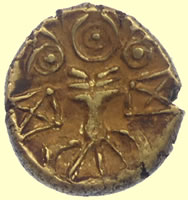 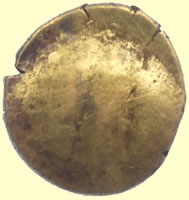
50 BC Uninscribed 'P' gold - 'Trophy' Type - 1/4 Celtic gold coin - 1.35g, 11.31mm - sent to CCI for recording
Beaded trophy quater, ABC 2243, BMC 435, not in VA. Extremely rare, 10 others known. An interesting Essex type because of its Kentish associations (derived from the Kentish trophy issue but a separate type), it may have been struck by an otherwise unknown offshoot of the Cantii. |
   
1560-1 Elizabeth 1st hammered gold half pound coin - (10 shillings, 120 pence)
28.8mm,5.11g
78gn
Spink ref S2520 |
  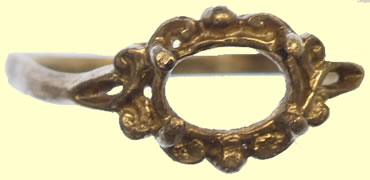
1982 gold ring - London mark- Crown 0.375 9 carat mark - date letter H
0.98g,23.8mm |
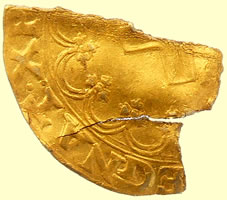 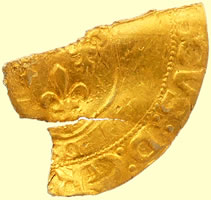
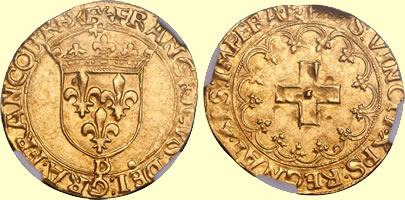
1 Ecu d'Or 1494-1547 France Ecu d'Or au Soleil, François Ier à la Croisette
Obverse legend : (SOLEIL) FRANCISCVS: D: GRA: FRANCOVM REX. (MM). (TRÈFLE).
Obverse description : Écu de France couronné ; lettre d'atelier à la pointe de l'écu.
Obverse translation : (François, par la grâce de Dieu, roi des Francs).
Reverse
Reverse legend : + XPS VINCIT. XPS. REGNAT. XPS IMPERAT (MM) (TRÈFLE).
Reverse description : Croix plaine alésée dans un double polylobe tréflé (11 lobes).
Reverse translation : (Le Christ vainc, le Christ règne, le Christ commande). |
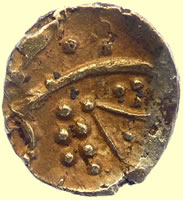 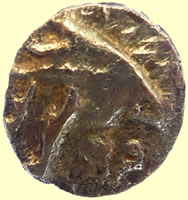
Celtic gold qtr stater - not certain of tribe yet- sent for recording and ID
50 BC Clacton Dragon type
Rev Traces of 'three men in a boat'design
Obv Central bar with appendages foring 'dragonesque' motif
1.38g, 13.42mm
Great find, it's a new reverse variant of the British F 'Dragon' type, ABC 2353 for an earlier version with open-mouthed beast clearly visible and DK 422 for a later, jumbled variant; all the known examples are from the same obverse die, here seen quite worn.
As with the Maldon quarter I'll send a CCI number as soon as I've finished the Iceni silvers.
Dragon quarter, DK 422 var, is 19.1960.
All the best
John |
 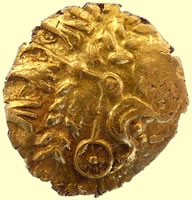
50 BC Maldon Wheel type sent for recording and ID from PAS
1.35g,13.66mm
CCI number of the Maldon Wheel quarter, ABC 2234, is 19.1959 |
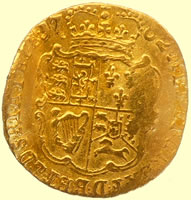 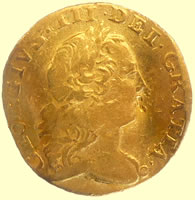
1762 George III milled gold qtr guinea love token
2.07g,15.35 |
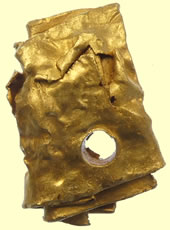 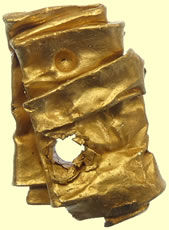 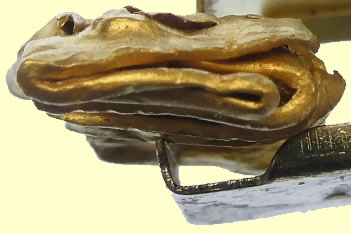
Ancient looking bright yellow rolled gold sheet reported as potential treasure to museum
3.11g,17.38mm L x 3.47mm T |
 
Trinovantes Clacton type Celtic gold 1/4 stater 50BC - reported as haord addendum
0.83g,12.35mm |
 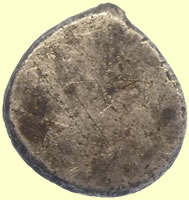
Wierd tiny debased gold coin - Celtic ?? sent to Fitzswilliam museum for their views
0.88g,9.07mm |
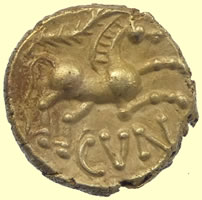 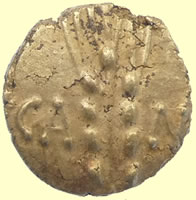
10-40 AD Cunobelin Celtic gold Linear type qtr stater - reported to PAS
Ladder main - branch above
11.36mm,1.28g
Ref ABC 2810 - Rare |
 
c25-35 AD Cunobelin Celtic gold full stater - reported to PAS
'plastic A' series, VA 2010-3. Believed to have preceded the classic type, so perhaps from c. 25 - 35 AD. About ninety of these are recorded including at least one coin in the British Museum (BMC 1819 in Hobbs's Catalogue of Iron Age coins in the BM).
5.45g, 16.88mm
Rudd 92-45 ABC 2789 Excessively rare |
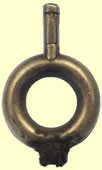
Georgian gold watch winder |
 
10-40 AD Cunobelin Celtic gold Linear type qtr stater - reported to PAS
Ladder main - branch above
11.19mm,1.34g
Ref ABC 2810 - Rare |
 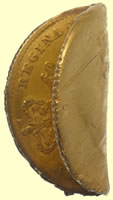
Taco'd 19thC Victorian milled gold half sovereign |
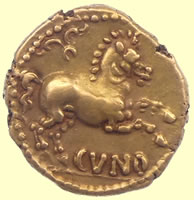 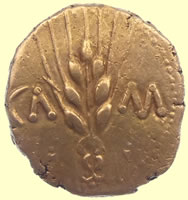
10-40 AD Cunobelin Celtic gold Classic Bow type qtr stater - reported to PAS
1.32g,11.38mm
Ref Rudd 75 57 - Excessively rare
ABC 2825
|
 
1.45g,11.96mm
It's a class 3 Great Waltham type quarter, no. 400 in Divided Kingdoms (same dies), essentially a slightly later and cruder version of the Ingoldisthorpe quarter, which is class 2 in the British Ab/Ac north-east Thames series. I list 14 other examples in DK but there are at least 15 now.
Hope this is of some help,
All the best
John |
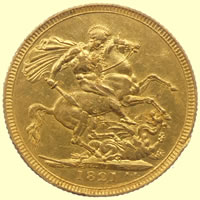 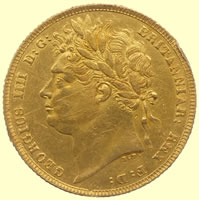
1821 George IV milled gold sovereign
8.01g,22.13mm |
 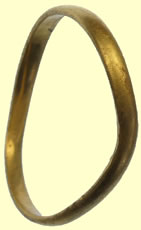
Early gold ring - no hallmarks
1.96g,22.3mm dia |
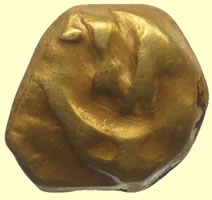 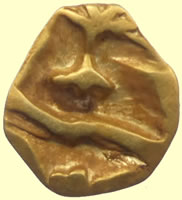
70 BC Morini Celtic gold qtr stater ? Is this one of those rare English types and not a Morini ? - reported as hoard addendum to museum
0.76g, 10.19mm
CCI 19.1419 |
 
70 BC Morini Celtic gold qtr stater- reported as hoard addendum to museum
1.47g,10.79g
CCI 19.1420. |
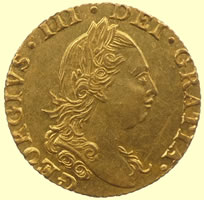 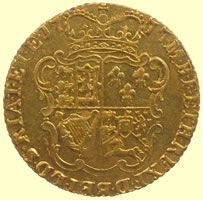
Stunning 1777 George III milled gold half guinea
4.20g,20.61mm |
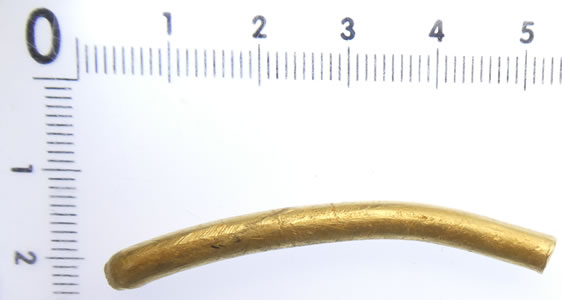
 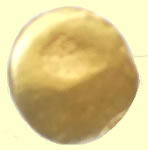
Ancient gold band - possible wrist torc fragment - reported as treasure to museum
11.16g, 4.33mm dia x 49.12mm L |
 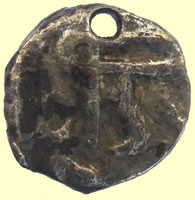
Saxon period continental coin - it has now been reported as treasure to the museum as it is a pendant. I have just supplied the find spot to the Fitzwilliam musuem so it is recorded on the Early Medieval Corpus database and we get an EMC unique number issued
Merovingian denier, debased gold coin dating to AD700 - 750,
Hi Chris,
This seems to be a Merovingian denier.
More information welcome.
Thanks,
Dr Martin Allen
Fascinating coin - initially thought is was Saxon silver sceat as the size matches. I do not recognise the markings and have sent it off to Fitzwilliam museum for ID and recording. Is it probably an Indian debased gold Fanim pendant?
1.08g,9.41mm |
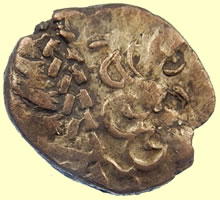 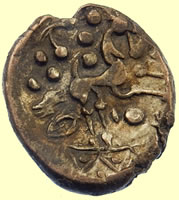
Coin from same hoard
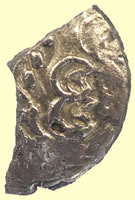 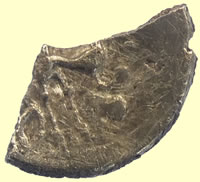
50 BC late British G 'Early Clacton' gold stater - reported to museum as hoard addendum |

Victorian gold bezel |
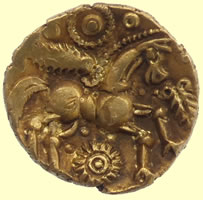 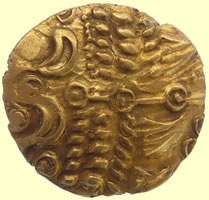
Very interesting 70 BC Tring Wheel looking Celtic gold stater , cogged sun type.
No exact die type in Hobbs or Rudd.Sent to PAS for recording
12.64mm,1.27g
40-30 BC Trinovantes Rowntree Fern leaf Celtic gold qtr stater
Wreath crossed by spike with 3 pellets,crescents below, stylised hair above
Annulate horse r,grooved tail, fern like motif above, cogwheel sun below
|
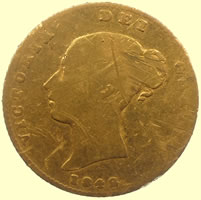 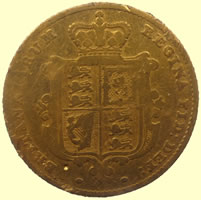
1842 Victoria milled gold half sovereign |
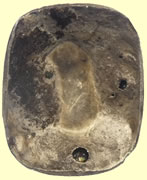 
Victorian rose gold ring top - missing stone |
 
Pure gold ancient ring
11.22g, 25.64mm -reported a streasure to museum |
 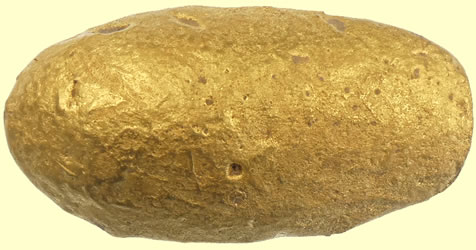
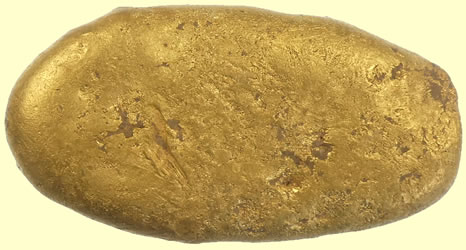 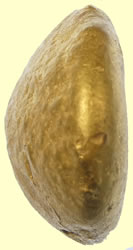
Monster ancient gold ingot - 81.54g,40.82mm L, 21.05mm W, 10.02mm T - reported a streasure to museum |
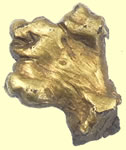 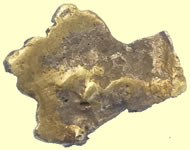
Undiagnostic gold ingot
9.7mm L, 0.68g |
 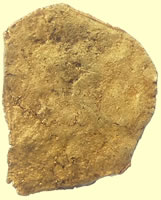
Undiagnostic pure gold sheet - reminds me of two beat to death Roman gold coins we have found
1.03g.15.05mm L x 0.80mm T |
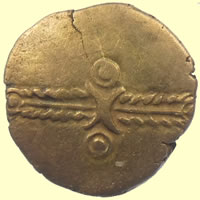 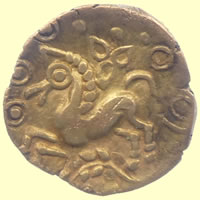
25BC Eastern uninscribed Celtic gold qtr stater of Dubnovellaunos - reported to museum
1.23g,13.27mm |
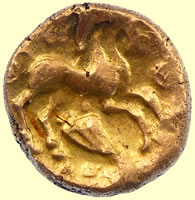 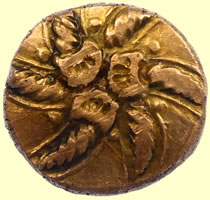
45 BC to 25BC Addedomarus - Trinovantian tribe- reported as hoard addendum to museum
5.58g.16.90mm |
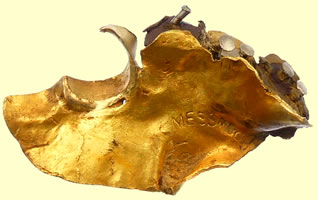 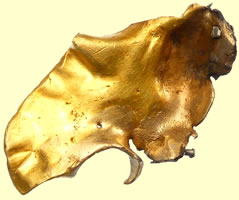 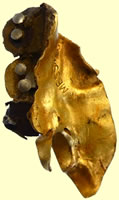
2.91g,28mm L
Gold dental implement. Sheet metal palette. This may have served to mount teeth retrieved from barber surgeons or graves - 'Waterloo Teeth' were collected from grave pits at many battlefields in Europe after the Napoleonic Wars (1803-1815). Gold remained a favoured material for dental work until its replacement with synthetic. |
 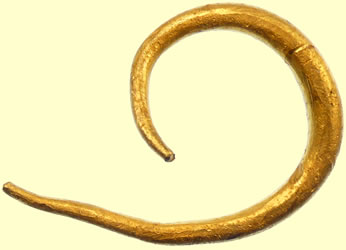
Celtic gold votive offering as ring money
Gold ring money- 1st C BC
Smooth ring with blunt ends Van Arsdell 1-3 Taylor pl33 Hobbs-- SCBS-- CE4244
6.86g, 32mm L |
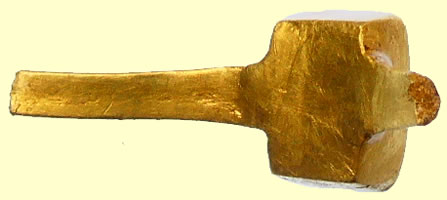 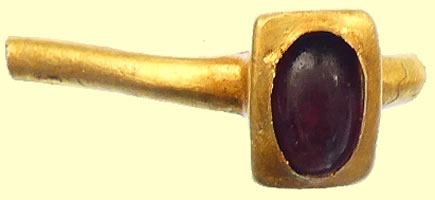
Pure gold medieval gold ring with red stone
Reported to museum as treasure
0.98g, 13.69mm L |
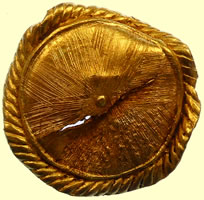 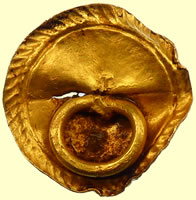
Very interesting hand scribed gold mount/button - sent off to museum for dating
15.32mm dia,0.97g |
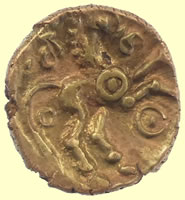 
45 BC - 25 BC Addedomarus Celtic gold qtr stater - Floral type - sent to PAS for recording
1.29g,12.46mm
Addedomarus (sometimes written Aθθedomarus on coins) was a king of south-eastern Britain in the late 1st century BC. His name is known only from his inscribed coins, the distribution of which seem to indicate that he was the ruler of the Trinovantes. |
 
1894 Victoria milled gold half sovereign
19.2mm,3.99g |
 
Undiagnostic plain gold ring
0.78g,22mm dia |
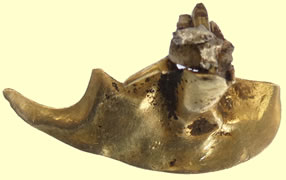 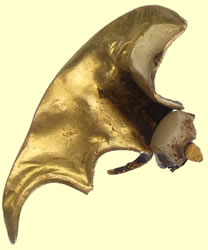
Gold dental plate |
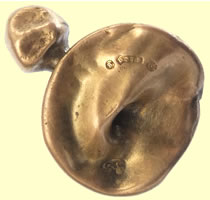 
1935 9 carat gold collar stud
Interesting Rose mint mark added to Sheffield in 1903 |
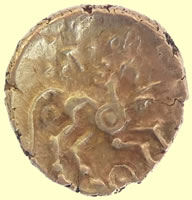 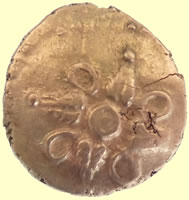
45 BC to 25BC Addedomarus - Trinovantian tribe Celtic gold qtr stater -
1.30g,13.12mm |
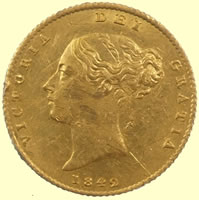 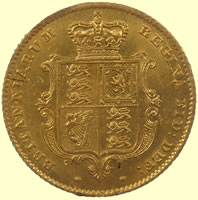
1843 Victoria milled gold half sovereign
4.03,19mm |
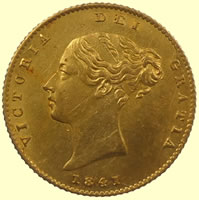 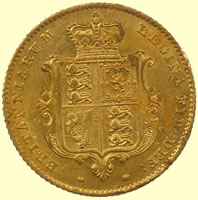
1841 Victoria milled gold half sovereign
4.02, 19mm |
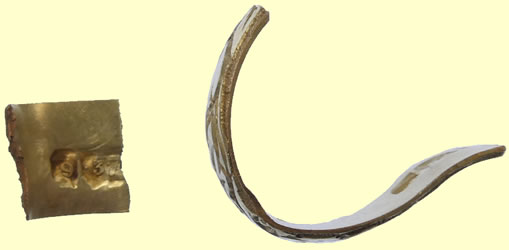

Pretty 1919 9 carat gold ring - Birmingham assay office date letter 'u' |
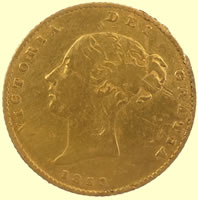 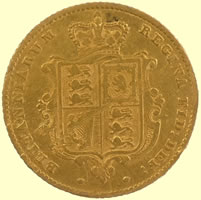
1853 Victoria milled gold half sovereign
3.89g,19mm |
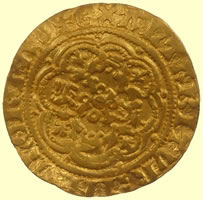 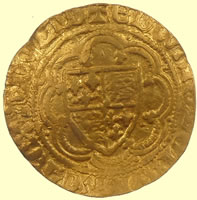
1361-1369 Edward III hammered gold qtr noble - Treaty period -I.m. Cross potent, Large pellet in panel with annulets at angles
Obv: EDWAR DEI GRAC ANGLI (D)
Rev: + EXALTABITUR IN GLORIA I
Obv shield quartered with the arms of England and France within a treassure of eight arches
1.66g,17mm |
 
Georgian brooch |
 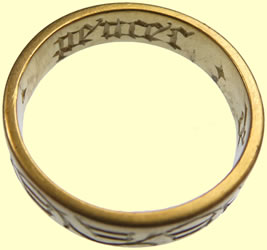
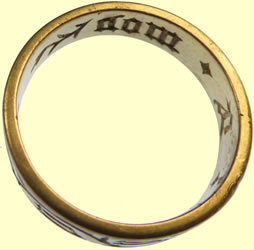 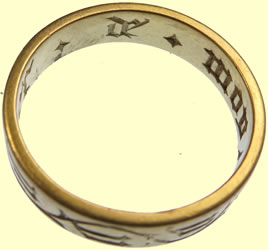
Stunning medeival gold ring - decorated outer band - full inner inscription in Lombardic script
Pencer De Moy ?
Working on deciphering lettering
3.77g.19mm dia
Note
"I found this expression, 'pencez de moy', which means 'think of me', engraved in a 14th century French ring at the National Museum in Stockholm. It is a precious gift to have someone thinking of you."
- Efva Attling
|
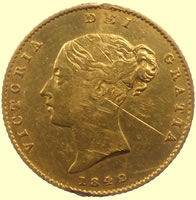 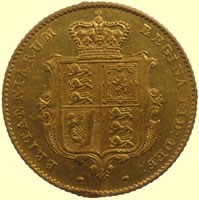
1842 Victorian milled gold half sovereign |
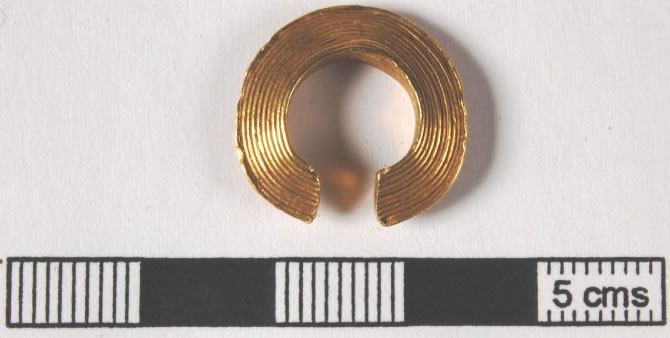
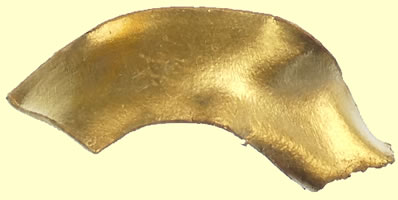
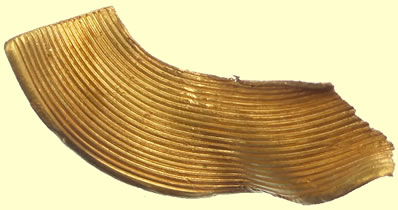
Bronze Age Tress Ring C1000BC
Lock-Rings
Ornaments, whose function is unknown, made from gold plates in triangular cross-section and secured by a binding strip, resulting in a hollow ring. The face plates can be decorated with repoussé decoration or with fine concentric incised lines imitating fine wire works. More rarely, lock-rings are made from face plates obtained from individual gold wires soldered together.
References
-
Eogan, G. 1969. 'Lock-rings' of the Late Bronze Age. Proceedings of the Royal Irish Academy, 67C, 93-148
3.12g,27.07mm long |
 
Post medieval gold stud - reported to museum
0.50g, 10mm |
 
10-40 AD Cunobelin Celtic gold stater - sent to PAS for recording
16mm,5.37g |
 
1842 Victoria milled gold half sovereign |
  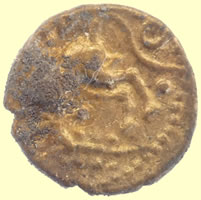 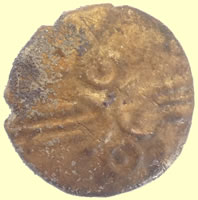
Using an ultrasonic cleaner to remove crud stuck to coin
25 BC Celtic gold qtr stater, reported to museum
Dubnovellaunus tribe Celtic gold qtr stater-11.0mm,1.35g
Linear wreath, with opposed crescents; Horse left with branch below and trefoil design above |
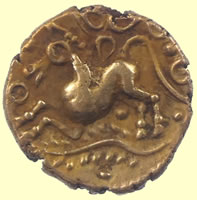 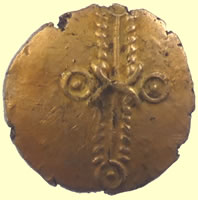
'Eastern uninscribed gold quarter stater of Dubnovellaunos, c 20 BC-AD 10. Van Arsdell VA1660 =BMC 2442.
12mm,1.28g- sent for recording on PAS |
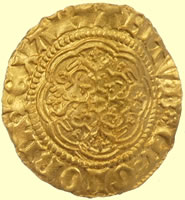 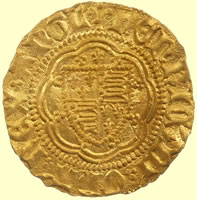
1412-13 Henry IV hammered gold qtr Nobel- Light coinage - Lis above shield, trefoils beside shield,Lis in centre of reverse.
Obv +hENRIC'DI; GRA;REX ANGL - mm Fleur de Lis
1.80g,18mm |
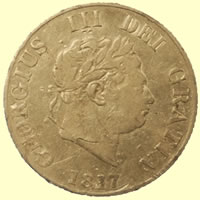 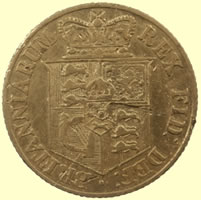
1817 George III milled gold half sovereign
3.95g,19.44mm |
| 2017/18 season total so far is 36 |
 
70BC Morini Celtic gold qtr - sent to PAS for recording
1.39g,11mm |
 
10-40 AD Cunobelin Celtic gold qtr stater - sent to museum for recording
1.32g,11mm |
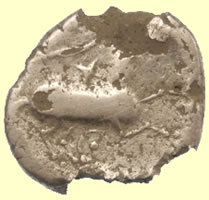 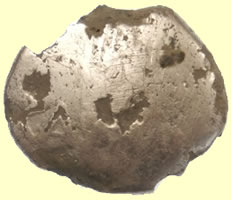
Cunobelin wild type gold contemporary forgery stater, VA 1933-1. VA 1933 type recorded although there are some minor variations in the size of the star over the horse (Van Arsdell splits them into small and large, but it's not always easy to decide where small ends and large begins!). Probably somewhere around the middle of his reign, perhaps c. 20 - 25 AD'. |
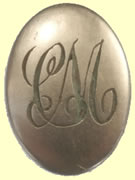
Victorian gold cufflink - Initials CM |
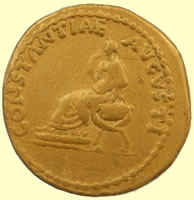 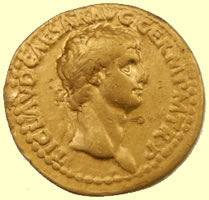
Roman gold coin send for ID
19mm,7.70g
Well, even though Roman gold is way out of the orbit in which I normally travel, I see absolutely no reason to question its authenticity. I presume you know this is an aureus of Claudius. It’s obviously clear enough overall that there should be no doubt about the legends, but for the sake of form:
Obv: TI CLAVD CAESAR AVG GERM P M TR P laureate head of Claudius right
Rx: CONSTANTIAE AVGVSTI Constantia seated left on curule chair
Mint of Lugdunum, 41/2 AD.
RIC I 2, BMC 1, CBN 19.
My congratulations to all involved – well found!
Mark |
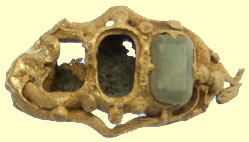 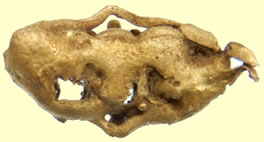 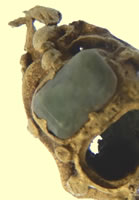
16thC Tudor gold ring top - reported as treasure to museum
12mm L, 1.58g |
 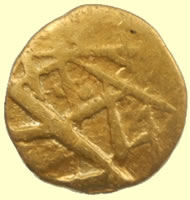
50 BC Celtic gold Gallic import qtr stater - sent to PAS for recording
Crossed lines with rider ABC 37, VA 37
Classed as scare
1.86g, 10.15mm
Caletes tribe, Normandy coast |
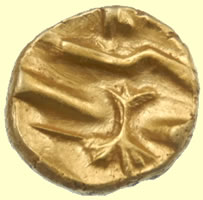 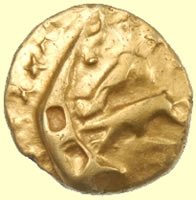
70BC Morini Boat Tree type Celtic gold qtr stater - hoard addendum coin reported to museum
1.50g, 10.00mm
|
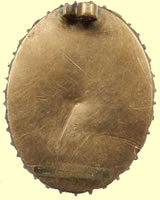 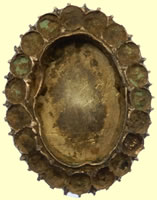
Victorian gold brooch |
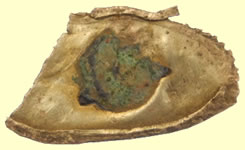 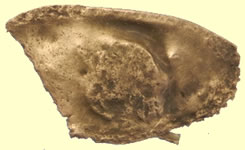
Victorian gold cuff link |
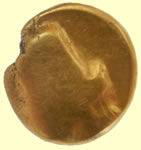 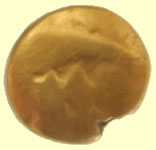
Smallest Celtic gold we have ever found
Continental Iron Age Gallo-Belgic DC uninscribed gold quarter state
This is a scarce variant of Gallo-Belgic D, the Face type, Scheers seies 14, my Gallo-Belgic Cd. On one side there's a very worn 'boat' design and on the other a large, kidney shaped blob, also very worn, that looks like an outline face on other coins. In 2003 I suggested they were struck by eastern neighbours of the Ambiani, perhaps by the Viromandui; there were 13 known at the time, perhaps 20-25 now including several from Britain, although I don't have the cards here. I'll give it a number later with the next batch if that's OK with you,
All the best
John
1.23g,8.82mm |
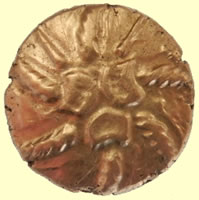 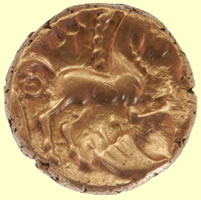
45 BC to 25BC Addedomarus - Trinovantian tribe- reported as hoard addendum to museum
5.45g,16.55mm |
 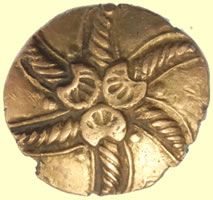
45 BC to 25BC Addedomarus - Trinovantian tribe- reported as hoard addendum to museum
5.59g,18.55mm |
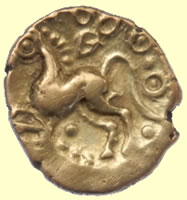 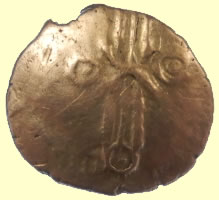
25BC Eastern uninscribed Celtic gold qtr stater of Dubnovellaunos - reported as hoard addendum to museum
1.27g,11mm |
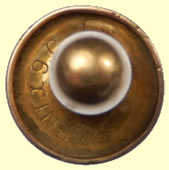 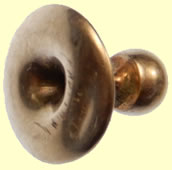
Victorian gold collar stud
0.98g
'PATENT 19 CT' |
  
Gold link with very interesting markings ? 1.02g
ME 117988 |
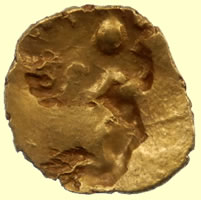 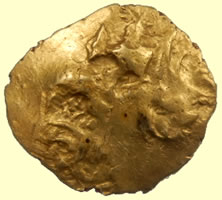
Interesting unknown tribe - researching it- hoard addendum coin
Celtic gold qtr stater
1.38g,14mm
50 - 20 BC Essex Wheels quarter, VA 260, BMC 485 and 496, ABC 2231 |
 
1797 George III milled gold third guinea
2.82g, 17.07mm |

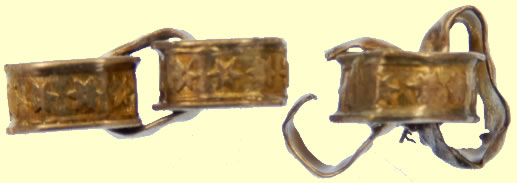
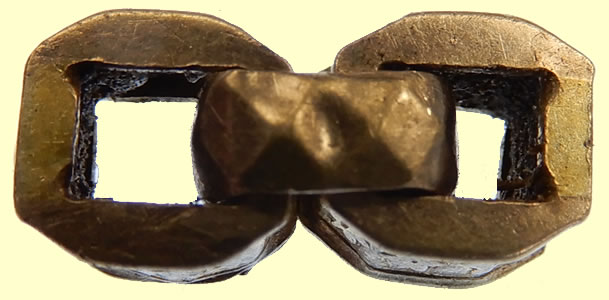
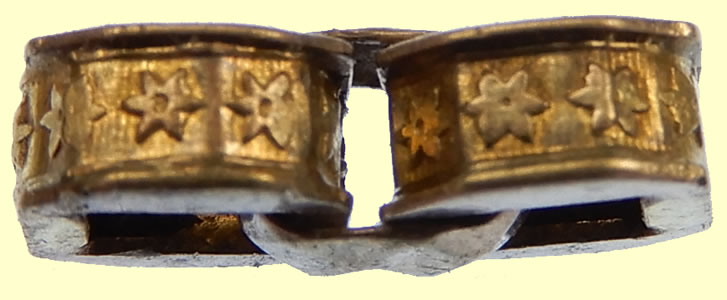
Scottish medieval hammered coin star design gold chain - reported as treasure to museum
Total weight of 3 links 1.58g |
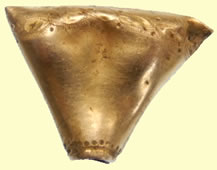 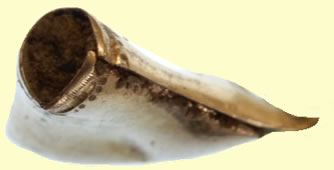 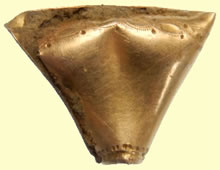
Victorian decorated gold item
14mm W, 0.75g |

Gold Georgian watch winder |
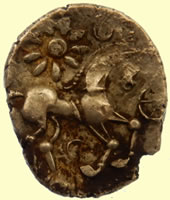 
Early 70BC Maldon Wheel quarter - 'Remi 'Type Celtic gold qtr stater - sent to PAS for recording
13.45mm,1.34g
The Remi were a Belgic people of north-eastern Gaul (Gallia Belgica). The Romans regarded them as a civitas, a major and influential polity of Gaul,The Remi occupied the northern Champagne plain, on the southern fringes of the Forest of Ardennes, between the rivers Mosa (Meuse) and Matrona (Marne), and along the river valleys of the Aisne and its tributaries the Aire and the Vesle.
Their capital was at Durocortum (Reims, France) the second largest oppidum of Gaul on the Vesle. Allied with the Germanic tribes of the east, they repeatedly engaged in warfare against the Parisii and the Senones.They were renowned for their horses and cavalry.
The coin you sent, incidentally, is a Maldon Wheel quarter, ABC 2234, rather than the standard South Thames British Qc type. Both are included in my forthcoming book - being published by Chris Rudd any day now - "Divided Kingdoms: the Iron Age Gold Coinage of Southern England". Every type and variety is illustrated and the 10,300 or so known up to around 2015 are all catalogued with full pedigrees; the many coins recorded through your good self are referred to as 'Inf. C.M.'
All the best
John |
 
150BC Celtic gold qtr stater - Gallo- Belgic A type
1.74g,15mm
I think this is one of those 150BC examples - not checked my ref books yet
Iron Age, mid-2nd century BC
Probably made in northern France or Belgium
One of the earliest coins in Britain
This is a superb example of the Iron Age die-engraver's art. It also represents what is thought to be the first type of coin ever to circulate in Britain. They were probably made on the Continent in northern France or Belgium. Gold coins like this crossed over the English Channel, perhaps in trade or as gifts between high-ranking individuals. Some of them were eventually buried in coin hoards and not recovered by their owners. The owner may have died, or simply forgotten where they had put them. Alternatively, the coins may have been intended as permanent, sacred offerings to the gods. They are mostly found today by metal-detectorists, in locations throughout south-east England. Another one was found at Fenny Stratford near Milton Keynes.
The design of the coin is, at several stages removed, descended from the Greek gold staters of King Philip II of Macedon (reigned 359-336 BC). The hair on the left-facing head has grown considerably, while the original two-horsed chariot on the reverse of the coin has been transformed here into a lively, abstract depiction of a horse surrounded by a large array of symbols.
I.M. Stead and S. Youngs, Celts, British Museum Pocket Treasury (London, The British Museum Press, 1996)
D. Nash, Coinage in the Celtic world (London, Seaby, 1987) |
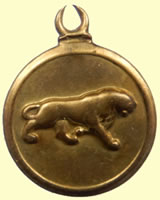 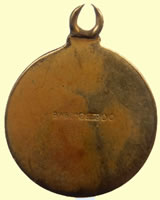
London 1963 - 9 carat gold pendant |
 
Ancient gold ingot - undiagnostic
0.91g, 6.67g |
 
Henry V Annulet and mullet by shield type Spink Ref 1756 North 1382 Class C, these were also stuck in Henry VI period.The is a Henry VI legend with a Henry V shield.
1422- 61 Henry VI hammered gold quarter noble
Obv +hENRICxREXxANGLxZx FRANC - double satires stop in reverse legend -Initial cross II
Rev +EXALITA BITVR x IN x GLORIA
Lis at centre of rev, Lis above shield
Annulet and mullet by shield - single satire stops to legend in Obv
1.78g, 19.36mm
|
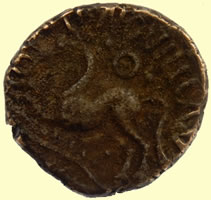 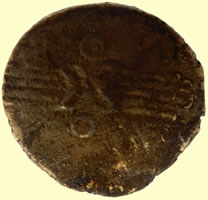
Eastern uninscribed Celtic gold full stater of Dubnovellaunus, c 20 BC - sent to PAS for recording
5.42g,18.27mm |
 
c20 AD Cunobelin gold qtr stater - linear series - sent to PAS for recording
11.37mm,1.36g |
 
1842 Victoria milled gold half sovereign
20.15g, 19.32mm |
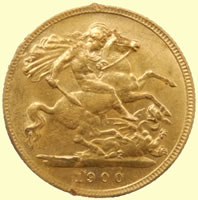 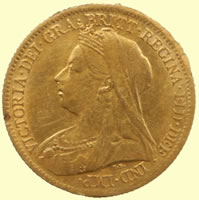
1900 Victoria milled silver half sovereign
19mm, 20.15g |
 
Facinating Celtic gold qtr find that appears to be a 70BC Morini boat tree type but it is not.It is underweight by 0.5g and debased gold.
Morini's are typically pure gold and 1.44g,10.5mm
It is possibly the earliest British Celtic gold coin example - sent off to musuem for confirmation
0.89g,11.86mm |
 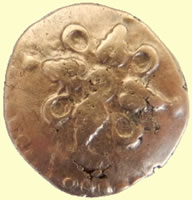
45 BC to 25BC Addedomarus - Trinovantian tribe Celtic gold qtr stater - sent to PAS for recording
1.32g,13.23mm |
 
50 - 20 BC Essex Wheels quarter, VA 260, BMC 485 and 496, ABC 2231 - sent to museum for recording
1.41g,15.1mm |
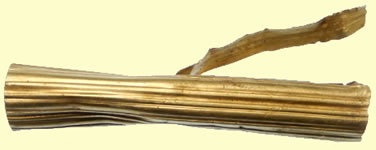
Victorian gold propelling pencil shaft |
  |
10-40 AD Cunobelin Cetic gold stater - 'linear' series, VA 1925-1. The earliest of the rule, perhaps from c. 20 AD
5.45g,16mm |
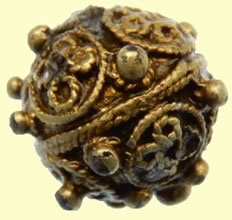  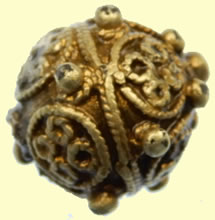
16thC Tudor gold and silver pin head - reported as treasure to museum
3.05g,10mm dia |

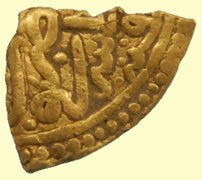 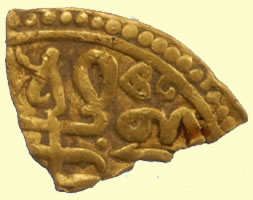
Ottoman hammered gold coin - Suleyman I The Magnificent 1520-1566 |
 

1979 London hall mark 9 carat gold ring - 25mm,3.92g |
2016/17 season total so far is 37 |
 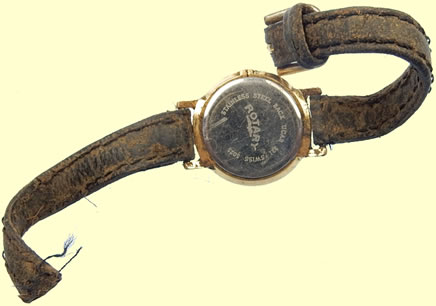
1930's 9 carat gold Rotary watch |
 
70 BC Morini Celtic gold qtr stater
1.38g, 10mm |
 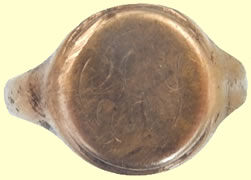
Victorian 9 carat gold signet ring |
 
Victorian gold locket back |
 
Addedomarus 45BC Celtic gold qtr stater - sent to PAS for recording
13.35mm,1.29g |
 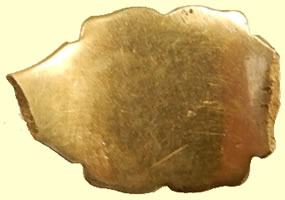
Victorian gold signet ring |
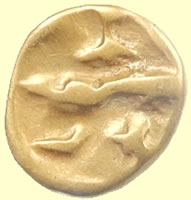 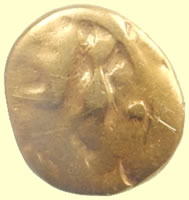
70 BC Morini Celtic gold qtr stater
1.46g,10.27mm
Reported to museum as hoard |


Early medieval gold ring - reported as treasure to museum
24mm,1.32g |

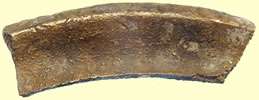
Ancient gold bar |
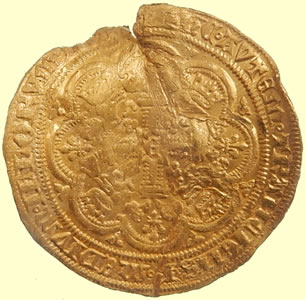 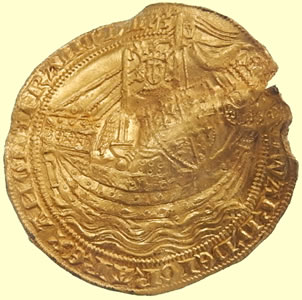
Monster gold coin find
1351-1352 Edward III gold noble -series C- E in centre of reverse cross - Closed E & C's - Lombardic M - reverse Roman N -annulet stops to reverse
Obv EDWARD DEI GRA REX ANGL Z FRANC D hYB
Ref Spink 1483 -JJ North 1144
33.46mm, 7.67g |
 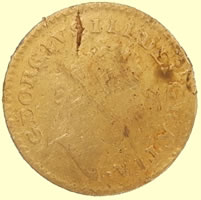
1800 George III milled gold third guinea
2.76g,17mm |
 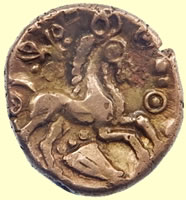
Addedomaros 45BC Celtic gold stater - reported to museum as hoard addendum
5.48g, 17.73mm |
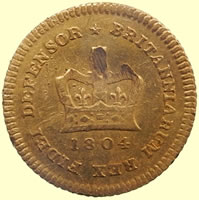 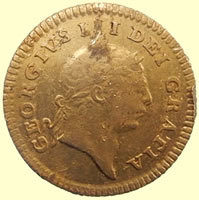
1804 George III milled gold third guinea
2.76g,17mm |
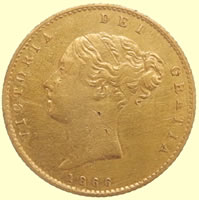 
1866 Victoria milled gold half sovereign
19.4mm,3.98g |
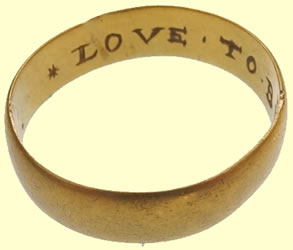 

17th/18thC gold posy ring - Great mis spelling
'*LOVE . TO. BE. LOVEED'
3.52g,19.35mm
Reported as treasure to museum |
 

1864 - 18 carat gold ring - 'Fidelity'
Maker HG&S - Henry Griffith & Sons Birmingham
20.22mm, 2.04g |
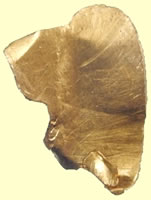 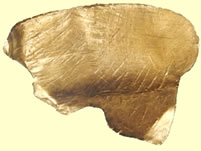
Ancient gold sheet - hatch decoration - possible cup fragment
21.34mm,0.95g
Reported as potential treasure |
| |
 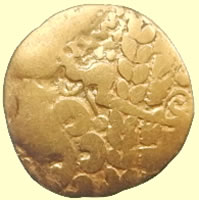
1.75g,14.57mm |
 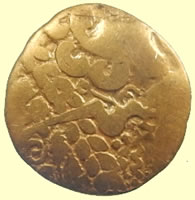
1.80g,14.30mm |
Iron Age, mid-2nd century BC
Probably made in northern France or Belgium another one found at Fenny Stratford near Milton Keynes, England
One of the earliest coins in Britain
Iron Age, mid-2nd century BC
Probably made in northern France or Belgium; found at Fenny Stratford near Milton Keynes, England
One of the earliest coins in Britain
This is a superb example of the Iron Age die-engraver's art. It also represents what is thought to be the first type of coin ever to circulate in Britain. They were probably made on the Continent in northern France or Belgium. Gold coins like this crossed over the English Channel, perhaps in trade or as gifts between high-ranking individuals. Some of them were eventually buried in coin hoards and not recovered by their owners. The owner may have died, or simply forgotten where they had put them. Alternatively, the coins may have been intended as permanent, sacred offerings to the gods. They are mostly found today by metal-detectorists, in locations throughout south-east England. Another one was found at Fenny Stratford near Milton Keynes.
The design of the coin is, at several stages removed, descended from the Greek gold staters of King Philip II of Macedon (reigned 359-336 BC). The hair on the left-facing head has grown considerably, while the original two-horsed chariot on the reverse of the coin has been transformed here into a lively, abstract depiction of a horse surrounded by a large array of symbols.
I.M. Stead and S. Youngs, Celts, British Museum Pocket Treasury (London, The British Museum Press, 1996)
D. Nash, Coinage in the Celtic world (London, Seaby, 1987)
Reported as potential hoard to museum |
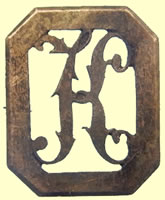 
19thC Rose gold letter mount |
 

1897 Victorian gold finger ring - 15 carat,0.625 Date e, Sheffield hallmark
Maker CJ
4.51g, 21.22mm |

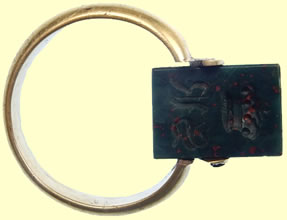 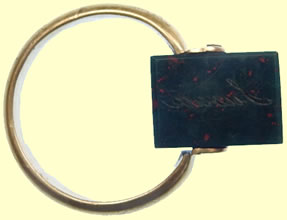
Georgian Double sided seal ring - Continental
Obv Crown SR
Rev Susan
20.12mm dia,4.27g
|
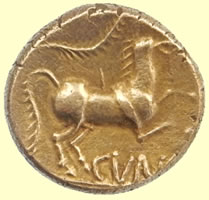 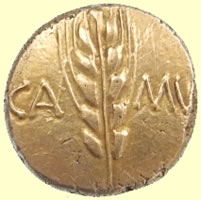
Celtic gold Cunobelin stater - 'linear' series, VA 1925-1. The earliest of the rule, perhaps from c. 20 AD, and a little rarer, with about 60 recorded here
15.95, 5.48g
Sent to museum for recording |
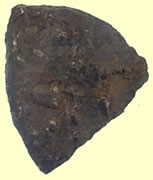 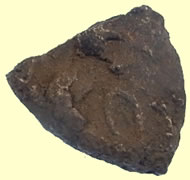
50 BC Trinovantes British British G 'Early Clacton' gold stater
Debased gold
0.89g, 9.91mm
Sent to museum for recording and addendum to existing hoard |
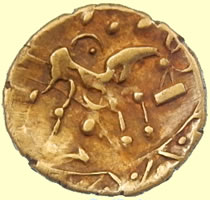 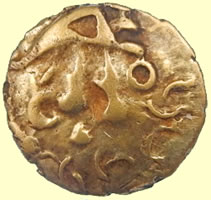
Trinovantes British G “Clacton” quarter, Hobbs 192 Celtic gold 1/4 stater 50BC
Chris Rudd 23.41 Clacton de Jersey - Classed as scarce
Reported to museum for recording
1.50g,13.39mm |
 
Victorian gold brooch |
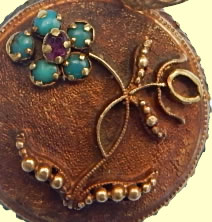 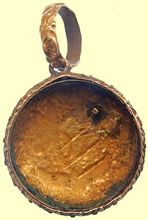 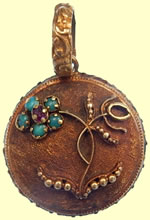
Stunning Victorian gold pendant with stones and pearls |
 
1806 George III milled gold 1/3rd guinea
2.80g, 17.11mm |
 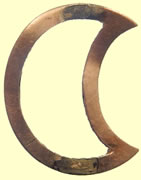
20thC gold brooch |
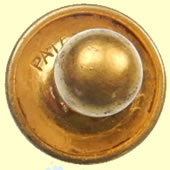 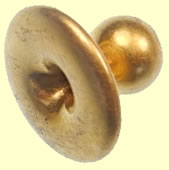
Victorian solid gold collar stud |
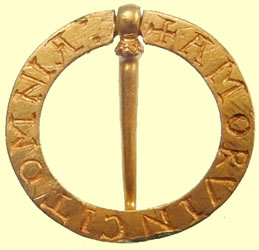 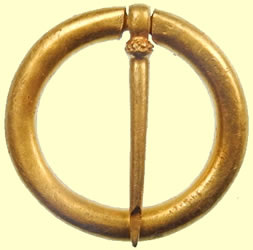
Spectacular c13thC medieval gold annular brooch
+AMOR VINCIT OMNIA -(Love Conquers All)
2.55g, 18mm dia |
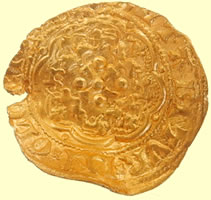 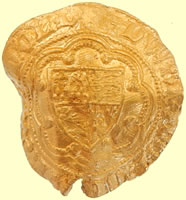
1361- 69 Edward III hammered gold qtr nobel - Treaty period, Large pellet at centre of reverse cross
Obv EDWAR DEI GRAC ANGL D
19mm,1.83g |
 


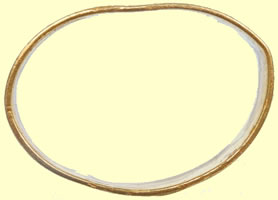
Medieval inscribed gold ring - no hall marks
'IIIy GOD is al '“My God is al[l]”.
22mm dia,2.80g
|
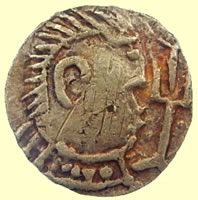 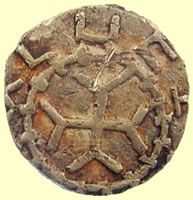
Saxon gold shilling
This new find (EMC 2016.0248) is indeed a Witmen type gold shilling. It is similar to some coins in the Crondall hoard but from dies not represented in the hoard.
The coin should be about 50-55% gold.
An excellent start to the season.
Best wishes,
Dr Martin Allen
1.14g, 10mm dia |
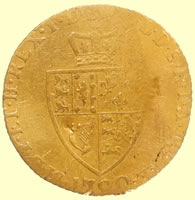 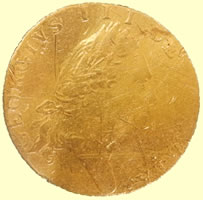
1790 George III milled gold half guinea
4.08g,20mm dia |
 
1762 George III milled gold 1/4 guinea
2.13g,15.72mm |
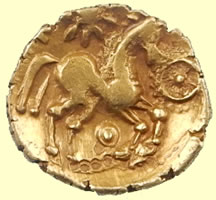 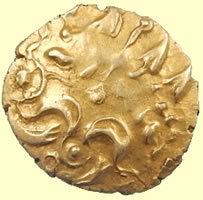
Early 70BC uninscribed 'Q' Gold - 'Remi 'Type Celtic gold qtr stater - sent to PAS for recording
1.35g,13.74mm
The Remi were a Belgic people of north-eastern Gaul (Gallia Belgica). The Romans regarded them as a civitas, a major and influential polity of Gaul,The Remi occupied the northern Champagne plain, on the southern fringes of the Forest of Ardennes, between the rivers Mosa (Meuse) and Matrona (Marne), and along the river valleys of the Aisne and its tributaries the Aire and the Vesle.
Their capital was at Durocortum (Reims, France) the second largest oppidum of Gaul on the Vesle. Allied with the Germanic tribes of the east, they repeatedly engaged in warfare against the Parisii and the Senones.They were renowned for their horses and cavalry.
|
| 2015/16 season final total is 59 |
 
1842 Victoria milled gold half sovereign
4.03g, 19.4mm |
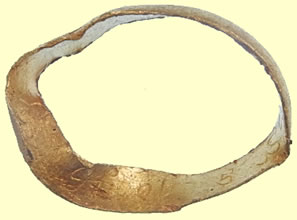 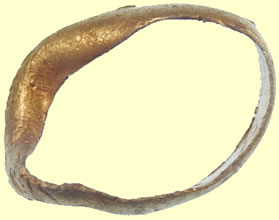
17th/18thC gold memorial ring - reported as treasure to museum
2.20g, 21.98mm
Inscription 'H obt 5th Sept 81'
Maker RM |
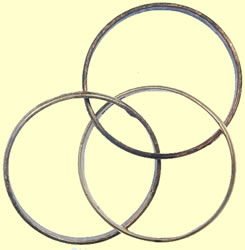
1922 - 9 carat - triple banded gold ring - London 0.375
Maker CG Probably Charles Gibson
2.22g |
 
Georgian gold watch winder with stone inay |
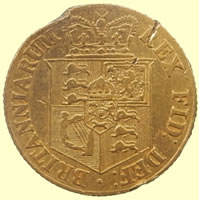 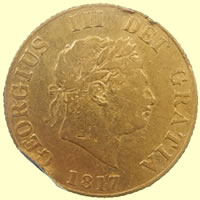
1817 George III milled gold half sovereign
3.96g,19.26mm |
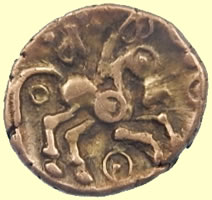 
Addedomarus 45BC Celtic gold qtr stater - sent to PAS for recording
1.30g,13.07mm |
  
Interesting Georgian gold ring with black enamelled inlaid sections- possible mourning ring - no hall marks
18.8mm. 1.57g |
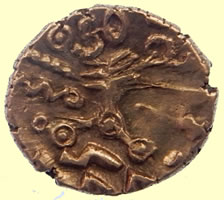 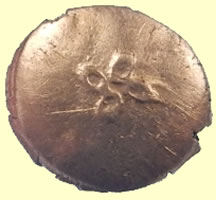
50BC Cantii Celtic gold qtr stater
It is a Floret Trophy type VA 146,BMC 436 attributed to the Cantii tribe - sent to PAS for recording
1.28g, 12.08mm |
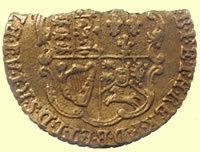 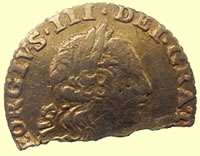
18thC George III gold third quinea |
 
1978 Gold ruby ring - Birmingham 0.375 - 9 carat - D date letter
Maker KR - not listed
20.80mm, 3.25g |
 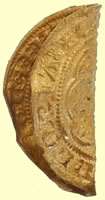 
Taco'd Circa 1350 Edward III hammered gold 1/4 noble - Cross 3 -Needs straightening to ID exact type from rev shield.
Obv + EDWARD DEI GRA REX ANGL
21.41mm 1.93g |
 
Ancient gold finger ring - no hall marks - reported as treasure to museum
0.40g, 17.25 mm |
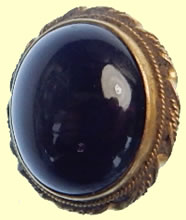 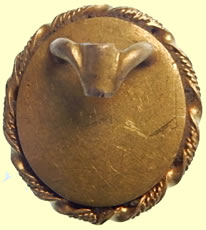
17th/18thC jewellery item with blue stone - possible brooch - no hall marks - reported as treasure to museum
2.65g, 14.87mm L |
 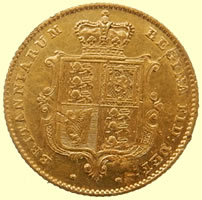
1846 Victoria milled gold half sovereign
19.38mm, 4.02g |
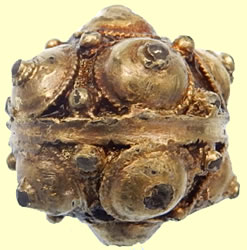 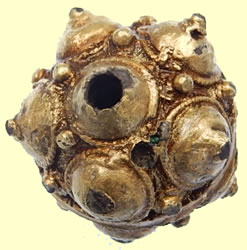 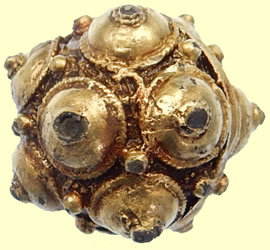
Late medieval or early Tudor decorated gold ball - reported a streasure to museum
Huge gold treasure - Each decoratred 'tit' has a black emerald encapsualted in the tip. There is an opening for a needle or mounting point in one place on the item. This is too large to be a pin head - appears to be solid gold but there must be an inner core, possibly silver.
It is 18.55 mm in dia and 6.3g in weight |
 
Medieval high carat small gold band - possible child's ring - reported as treasure to museum
12.56mm, 0.16g |
 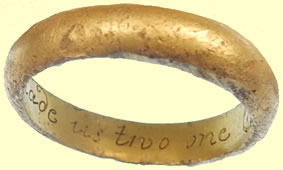
Heavy thick 17th/18thC gold posy ring with inscription - reported as treasure to meusum
'God alone made us tivo one' ( God made us to two be one ?)
Maker RD
7.51g, 22.68mm |


Staggeringly beautiful 16thC Tudor gold key brooch - reported as treasure to museum
1.80g, 36mm L |
  
Victorian gold signet ring |
 
10- 40 AD Cunobelin Celtic gold qtr stater - sent to PAS for recording
1.31g, 11.16 mm
|
  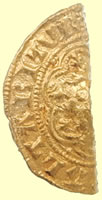
1361 Edward III hammered gold 1/4 noble
Edward III (1361), Quarter-Noble, Transitional Treaty Period, quartered shield of arms - need to be straightne for difinitive ID
lions in angles, lis above lion in fourth quarter, within beaded and linear tressures of eight arcs, trefoils in spandrels, beaded circle surrounding, saltire stops in legend, +exaltabitvr: in: gloria
19.91mm,1.96g |
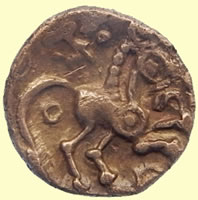 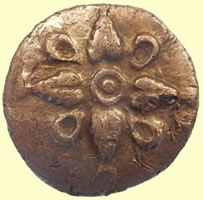
45 BC to 25BC Addedomarus - Trinovantian tribe Celtic gold qtr stater - sent to PAS for recording
1.34g, 12.34mm
 
10- 40 AD Cunobelin Celtic gold qtr stater - sent to PAS for recording
1.33g, 11.57mm |
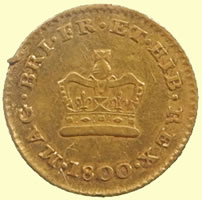 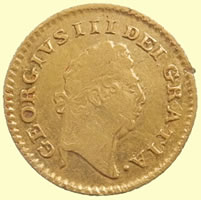
1800 George III gold third guinea |
 
1823 George IV London hall mark date letter lower h - duty paid bust
24.46mm,0.96g
Maker SG
Sebastian Henry Garrard- Garrard & Co Ltd ,
A business founded by John Wickes in 1722 and still active in present days
|
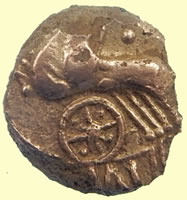 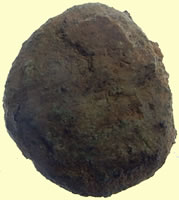 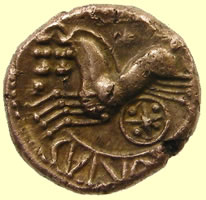 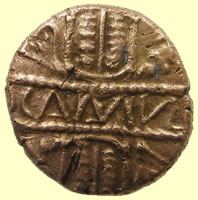
10-40 AD Cunobelin biga qtr stater, VA 1910, BMC 1769-1771, ABC 2771 Very rare.
11.48mm, 1.26g
|
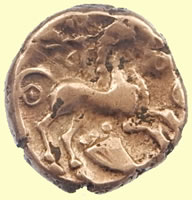 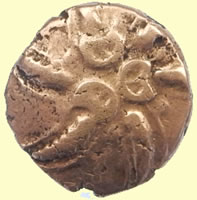
45 BC Addedomarus (sometimes written Aθθedomarus on coins) Celtic gold full stater
Reported as hoard to museum
5.48g, 16.54mm |
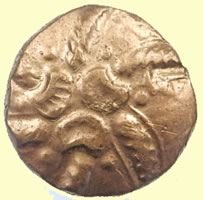 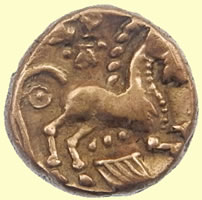
45 BC Addedomarus (sometimes written Aθθedomarus on coins) Celtic gold full stater
Reported as hoard to museum
5.42g, 15.79mm |
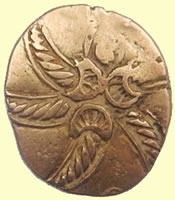 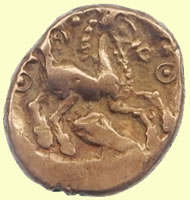 |
45 BC Addedomarus (sometimes written Aθθedomarus on coins) Celtic gold full stater
Reported as hoard to museum
5.59g, 18.58mm |
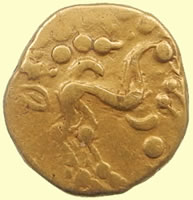 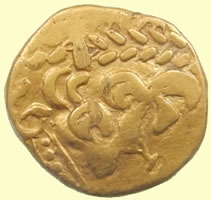
50 BC Gallo Belgic type stater
Reported as hoard to museum
18.43mm,6.45g |
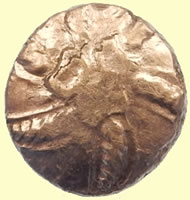 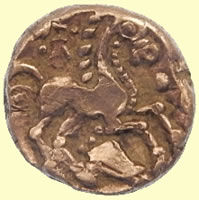
45 BC Addedomarus (sometimes written Aθθedomarus on coins) Celtic gold full stater
Reported as hoard to museum
5.58g, 16.43mm |
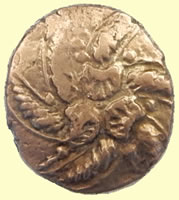 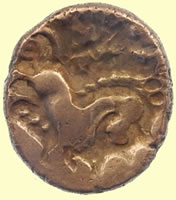
45 BC Addedomarus (sometimes written Aθθedomarus on coins) Celtic gold full stater
Reported as hoard to museum
5.58g, 18.27mm |
 
1804 George III milled gold third guinea
2.82g, 17.07mm |
 
1804 George III milled gold third guinea
2.82g, 17.07mm |
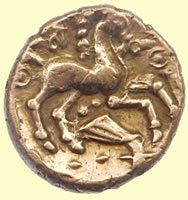 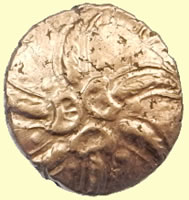
45 BC Addedomarus (sometimes written Aθθedomarus on coins) Celtic gold full stater
Reported as hoard to museum
5.49g, 18.40mm |
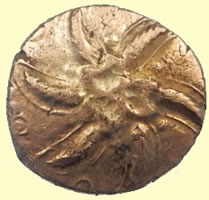 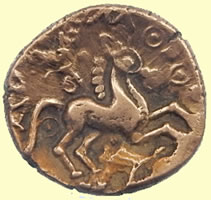
45 BC Addedomarus (sometimes written Aθθedomarus on coins) Celtic gold full stater
Reported as hoard to museum
18.54mm,5.49g |
  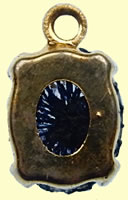
20thC gold pendant with glass stone |
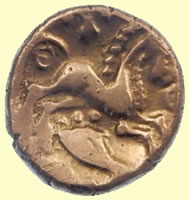 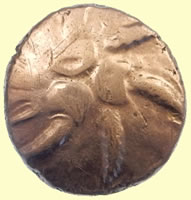
45 BC Addedomarus (sometimes written Aθθedomarus on coins) Celtic gold full stater
Reported as hoard to museum
17.35mm,5.49g |
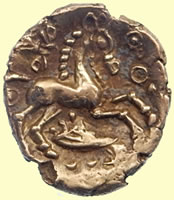 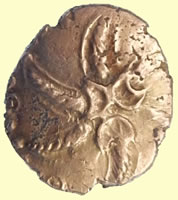
45 BC Addedomarus (sometimes written Aθθedomarus on coins) Celtic gold full stater
Reported as hoard to museum
5.54g,20.37mm |
 
Victorian gold brooch fragment |
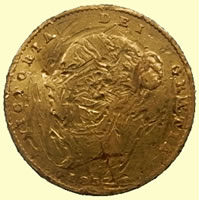 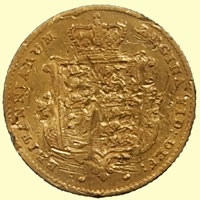
1857 Victoria milled gold sovereign |
 
Pure ancient gold nugget - reported as potential treasure to museum - 1.09g |
 
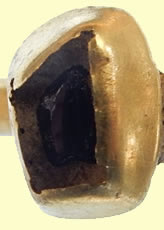 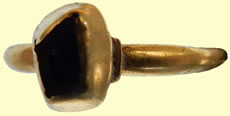
Medieval gold ring with black sapphire pushed inside - reported as treasure to museum
22mm, 2.98g |
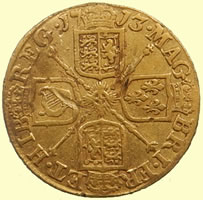 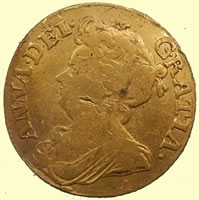
1713 Queen Anne milled gold full guinea
24.2 mm,7.67g |
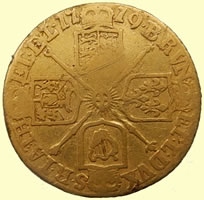 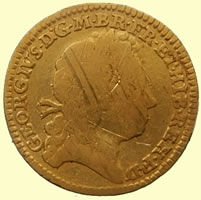
1719 George 1st milled gold half guinea
3.97g, 21mm |
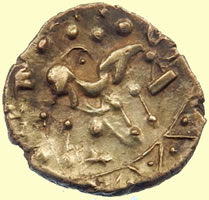 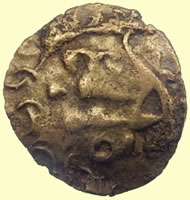
Trinovantes British G “Clacton” quarter, Hobbs 192 Celtic gold 1/4 stater 50BC
Chris Rudd 23.41 Clacton de Jersey - Classed as scarce
1.47g,14.2mm
Reported as hoard addendum to museum
|
 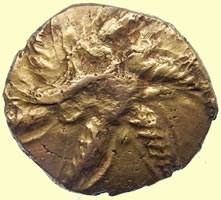
45 BC Addedomarus Celtic gold stater - reported as hoard to museum
5.57g, 18.2mm |
 
Medieval green stone gold ring - reported to museum as treasure
0.61g,12.5mm
Cannot clean off the black tar substance sticking to it as it has to be handed in uncleaned as a treasure item. |
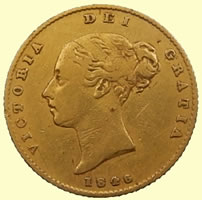 
1846 Victoria milled gold half sovereign
19.2mm,3.97g |
 
DecoratedVictorian 9 carat gold button with missing gem stone |
 
10-40 AD Cunobelin full gold stater - sent to PAS for recording
5.43g,19.8mm |
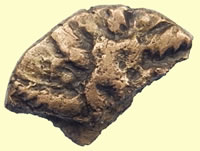 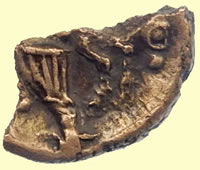
Addedomarus 45BC Celtic gold full stater fragement - sent to museum as hoard addendum
16.5mm,2.31g |
 
1777 George III milled gold full guinea (21 shillings)
8.37g, 24.8mm |
 
9 carat gold Birmingham hall marked 0.375 - still researching another unknown mark for date
20.5mm,1.59g |
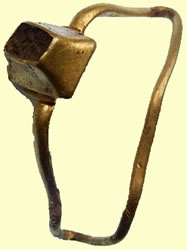 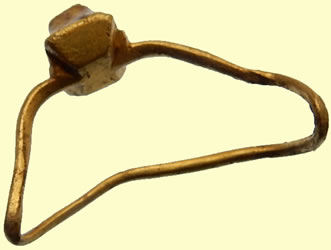
Medieval gold ring - reported as treasure to museum
1.89g, 24mm |
 
20thC gold ring - Continental marks- Q1 CTF 750
0.96g,21mm |
 
Trinovantes British G “Clacton” quarter, Hobbs 192 Celtic gold 1/4 stater 50BC - sent to PAS for recording
Chris Rudd 23.41 Clacton de Jersey - Classed as scarce
1.41g, 11.93mm |
  |
Medieval gold finger ring - no marks - reported as treasure to museum
1.99g, 28mm |
 
 
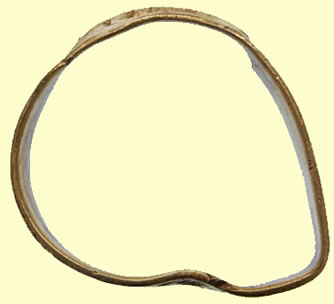
|
Stunning 14thC medieval gold ring - reported as treasure to museum
1.26g, 20mm
Lombardic script possibly Latin
2014/15 season total 79 pieces |
 
70 BC Morini Celtic qtr stater - reported to PAS for recording
1.41g, 9.9mm |
 
1842 Victorian milled gold full sovereign
22mm,8.03g |
 
High carat jewellery fragment - not sure what it was used for
28.5mm L, 1.81g |
 
Stunning little 20thC gold, shell and possibly diamond ear stud |
 
1954 - 9 carat gold signet ring - Birmingham
W.H.J maker
1.07g, 16.5mm |
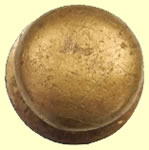 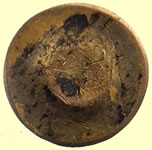
22 carat Victorian gold collar stud
0.62g |
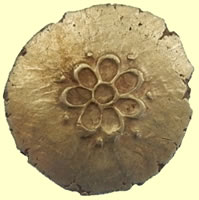 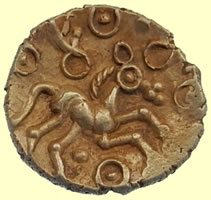
Stunning strike of 45 BC to 25BC Addedomarus - Trinovantian tribe Celtic gold qtr stater - flower type - sent to PAS for recording
VA1608 Very rare
13mm,1.36g |
 
Victorian Rose gold cane band |


22 carat 1815 George III Gold finger ring - date letter U
London mint , duty paid mark- bust of George III
1.10g,20mm |
 
What looked like a modern gold plated ring is actually a lot earlier and gold sheet on an inner core.The punched decoration on the outside is actually writing in Lombardic type script which suggest medieval. I can read the word 'Little' but it is very difficult to make out the rest. I am not sure what the inner core is so I have reported it as potential treasure to the museum in case it is 10% gold or silver by weight
Medieval rolled gold ring ?? - reported as potential treasure to museum
1.69g,19mm |
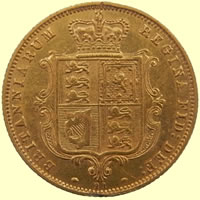 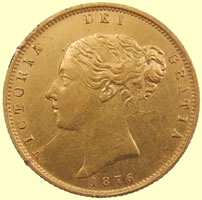
1876 Victoria milled gold half sovereign
3.99g, 19.30mm |
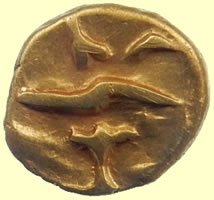 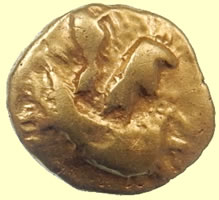
70BC Celtic gold qtr stater - sent to PAS for recording
1.44g, 10.8mm |
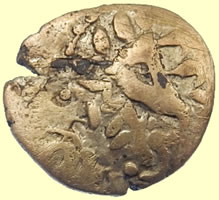 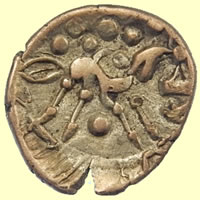
Trinovantes British G “Clacton” quarter, Hobbs 192 Celtic gold 1/4 stater 50BC - sent to PAS for recording
Chris Rudd 23.41 Clacton de Jersey - Classed as scarce
1.25g, 13.5mm |
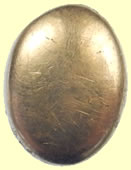 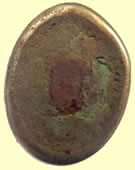
Gold cufflink |
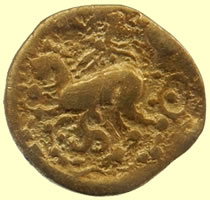 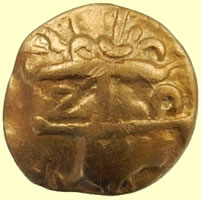
BC Celtic gold qtr stater - not a tribe I know so researching it. Thanks to John Sills at the CI for the ID
12mm,1.96g
ABC 34 Defaced Die quarter with a left-facing obverse bust obscured by lines and a left-facing horse and rider on the reverse with triskeles below. This type was struck somewhere in the French/Belgian border region in the 2nd century BC by an unknown tribe and possibly dates to around 175 BC plus or minus a couple of decades either way. Used to be very rare, I listed 17 examples in my 2003 book but there are perhaps 30 or so known now
Hope this is of some use
All the best
John>> |
 
1897 Gold cufflink - Sheffield Rose mark - 9 carat
Marks 375, rose,lion date letter O
Marker CW S
2.04g, 18mm
Charles Westwood & Sons (registered Jun 1896)
Hall Street, Birmingham |
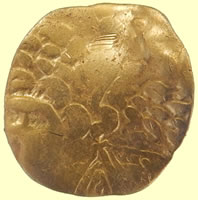 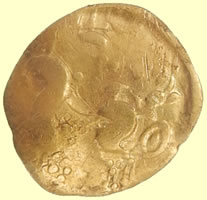
Mitch Chris ID'd our oldest ever Celtic gold coin - Mid 2nd C BC
Gallo- Belgic A type
Very interesting, very thin (1mm) like a medieval hammered gold- Celtic gold qtr gold stater - sent to PAS ID and recording
1.75g, 15mm
Iron Age, mid-2nd century BC
Probably made in northern France or Belgium another one found at Fenny Stratford near Milton Keynes, England
One of the earliest coins in Britain
Iron Age, mid-2nd century BC
Probably made in northern France or Belgium; found at Fenny Stratford near Milton Keynes, England
One of the earliest coins in Britain
This is a superb example of the Iron Age die-engraver's art. It also represents what is thought to be the first type of coin ever to circulate in Britain. They were probably made on the Continent in northern France or Belgium. Gold coins like this crossed over the English Channel, perhaps in trade or as gifts between high-ranking individuals. Some of them were eventually buried in coin hoards and not recovered by their owners. The owner may have died, or simply forgotten where they had put them. Alternatively, the coins may have been intended as permanent, sacred offerings to the gods. They are mostly found today by metal-detectorists, in locations throughout south-east England. Another one was found at Fenny Stratford near Milton Keynes.
The design of the coin is, at several stages removed, descended from the Greek gold staters of King Philip II of Macedon (reigned 359-336 BC). The hair on the left-facing head has grown considerably, while the original two-horsed chariot on the reverse of the coin has been transformed here into a lively, abstract depiction of a horse surrounded by a large array of symbols.
I.M. Stead and S. Youngs, Celts, British Museum Pocket Treasury (London, The British Museum Press, 1996)
D. Nash, Coinage in the Celtic world (London, Seaby, 1987) |

Interesting gold loop item - rolled gold over a copper inner - not plated
sent to musuem for their views
60mm Long |
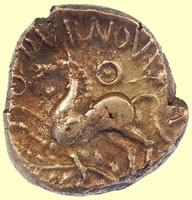 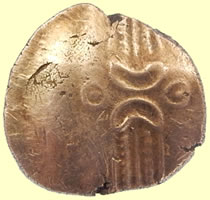
Stunning strike with full Kings inscription showing
Eastern uninscribed Celtic gold full stater of Dubnovellaunus, c 20 BC- sent to PAS ID and recording
5.39g,19.1mm |

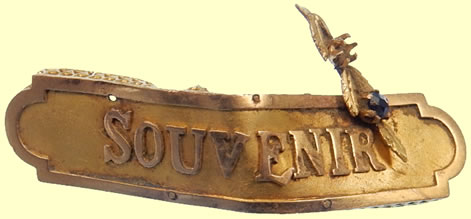
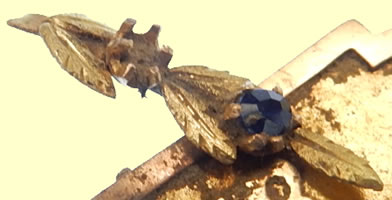
Huge Victorian gold name badge - possibly French name - fretwork sides and blue stone in mount
Continental - no hall marks
[French, from Old French, to recall, memory, from Latin subvenīre, to come to mind
42mm L , 3.51g |
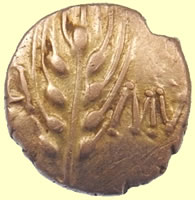 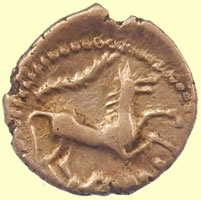
10 - 40 AD Cunobelin gold qtr stater - sent to PAS for recording
1.32g, 12mm
|
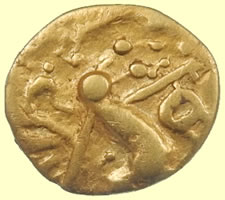 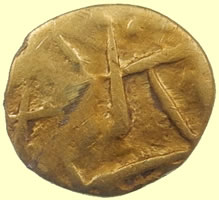
50 BC Celtic gold Gallic import qtr stater - sent to PAS for recording
Crossed lines with rider ABC 37, VA 37
Classed as scare
Caletes tribe, Normandy coast |
 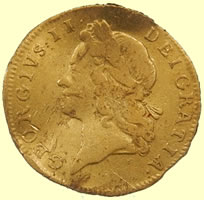
1750 George II milled gold half guinea
22mm, 4.08g |
 
10-40 AD Cunoblein Celtic gold qtr stater - sent to PAS for recording
1.34g, 10.1mm |
 
Victorian Gold ring bezel or cuff link with coloured stone |
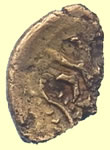 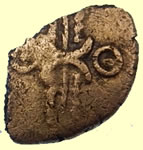
25BC Eastern uninscribed Celtic gold qtr stater of Dubnovellaunos
11mm,0.67g
|
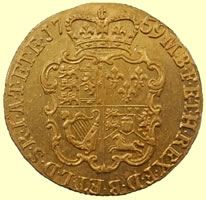 
1759 George II milled gold guinea
25mm dia, 8.44g |
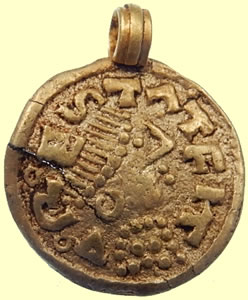 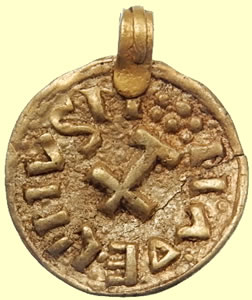 
Stunning Saxon gold coin pendant - reported to museum as treasure
1.35g, 15mm dia
|
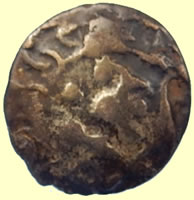 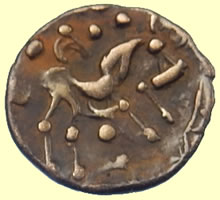
50BC Clacton type Celtic gold qtr stater - sent to PAS for recording
13.1mm, 1.43g |
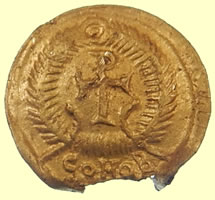 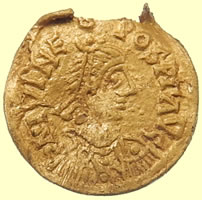
Saxon gold solidus ? sent to Fitzwilliam museum for recording and ID
1.32g,14.1mm
This is very interesting find, but unfortunately it is notAnglo-Saxon and neither is it a solidus. This is a semissis (half solidus) ofJulius Nepos (474-5), from the Rome mint (RIC X, 3207). The damage mayhave been caused by removal of a mount.
I have recorded this as EMC 2015.0080 from 'near Colchester'.
Best wishes,
Martin> |
 
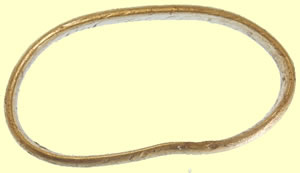
17th/18thC gold posy ring - reported to museum as potential treasure
'GOD FOR EVER BLESS US FOREVER
26mm, 3.16g |
 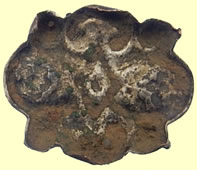
Victorian gold mount
0.55g, 14.55mm L |
 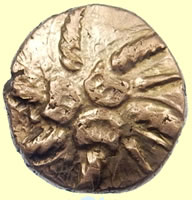
45 BC Addedomarus Celtic gold stater - reported to PAS for recording
16.5mm, 5.48g |
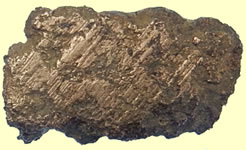 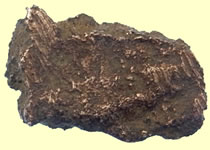
Ancient gold nugget reported to museum as potential treasure
1.88g, 15.2mm long |
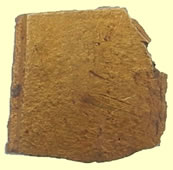 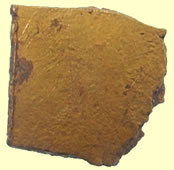
Ancient gold sheet reported to museum as potential treasure
9.1mm, o.96g sq |
 
45 BC Addedomarus Celtic gold qtr stater - reported to PAS for recording
13.1mm, 1.33g |
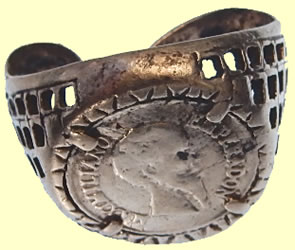 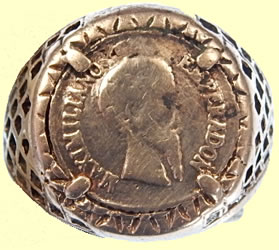
1869 Maximiliano Mexican gold coin in ring
2.57g, 17mm |
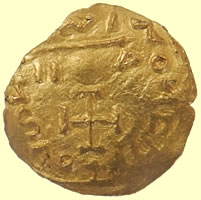 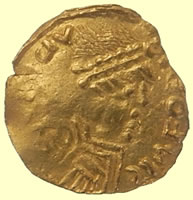
Merovingian Saxon gold tremissis of the 7th century - reported to museum as hoard
1.19g, 13.5mm |
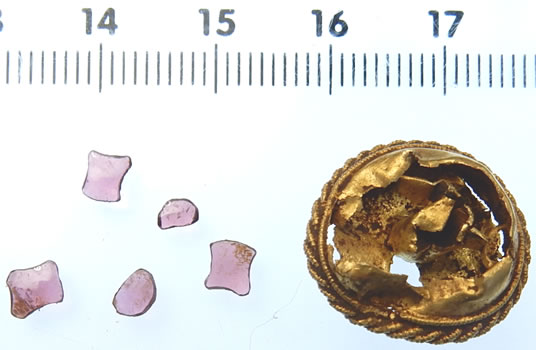
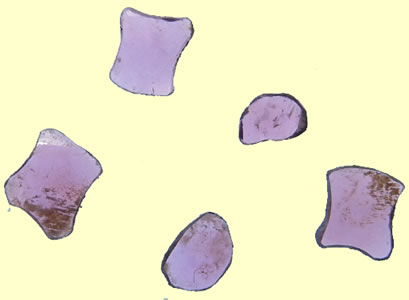 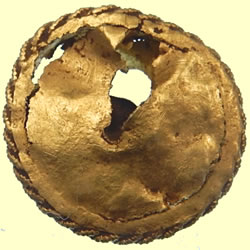
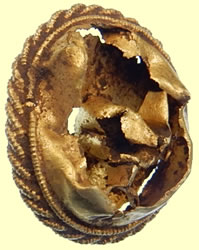 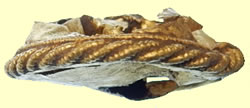
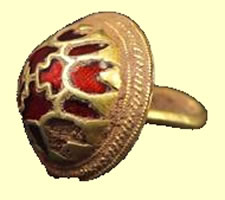 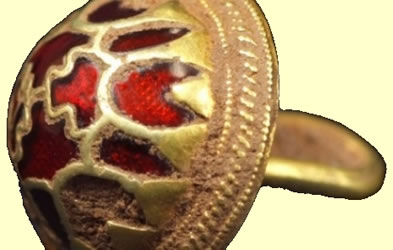
Staffordshire hoard example of complete button
Anglo Saxon gold button with tiny stone inlays - reported to museum as treasure
2.31g, 18.5mm dia |
 
Victorian 9 carat gold cane ring |
 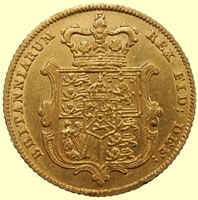
1828 George IV milled gold half sovereign
19.1mm,3.98g |
 

Victorian gold signet ring - Continental mark |
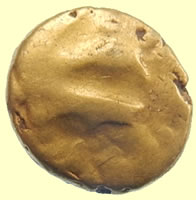 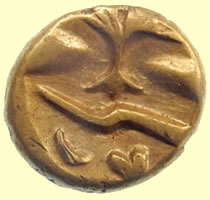
70BC Morini Celtic gold qtr - sent to PAS for recording
1.51g, 10.5mm |
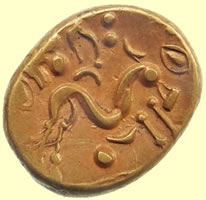 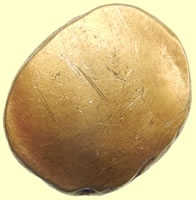
50 BC Gallo Belgic Celtic gold full stater- sent to PAS for recording
6.18g, 17.2mm |
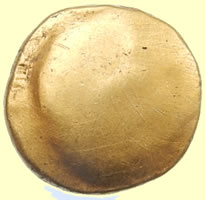 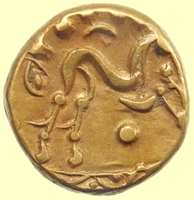
50 BC Gallo Belgic Celtic gold full stater- sent to PAS for recording
6.30g,17.7g |
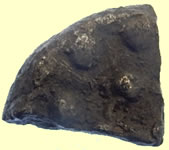 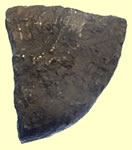
50 BC late British G 'Early Clacton' debased gold stater fragment - sent to PAS for recording
0.55g, 9.9mm |
 
50 BC late British G 'Early Clacton' gold stater - sent to PAS for recording
20mm, 5.73g |
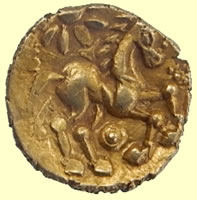  |
Probably a 40 BC Southern style QC type or even a Regini - it is inbetween the two, classed as rare
Sent to PAS for recording
12.1mm,1.36g |
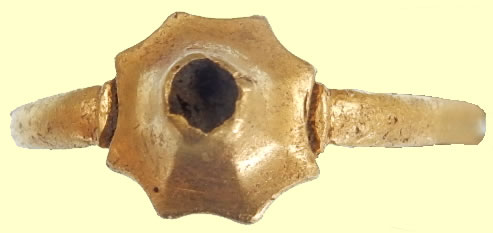 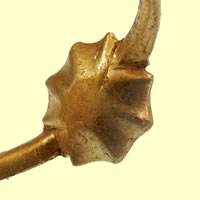
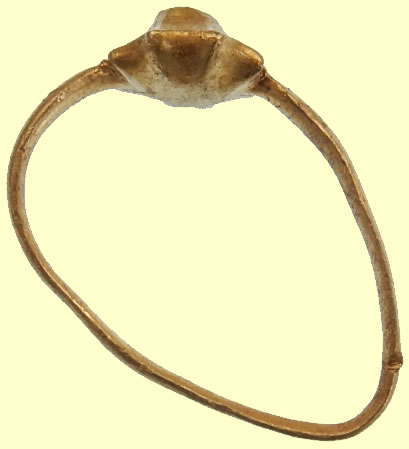
13thC Medieval gold ring - reported as treasure to museum
24mm, 2.0g |
 
20thC Continental triple carat gold ring - no hall marks
1.99g, 19mm |
 
Victorian gold brooch |
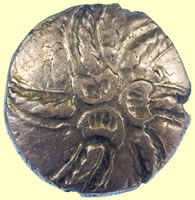 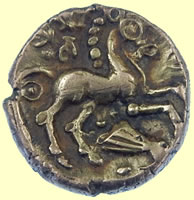
45 BC to 25BC Addedomarus - Trinovantian tribe Celtic gold stater - sent to PAS for recording
5.58g, 18mm |
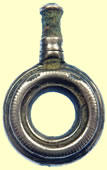 
Georgian rose gold watch winder |
 
Georgeian solid rose gold bezel over copper inner |
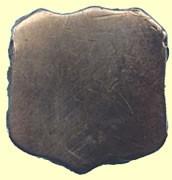 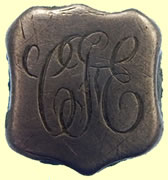
Victorian rose gold signet ring top
0.92g, 10mm H |
 
c 50 BC Celtic gold qtr stater - Similar to a Clacton Cross type but not a match in the Ref books, Hobbs and Rudd - sent to PAS for recording and ID
1.44g, 13.5mm
Van Arsdell VA 1460-1
http://www.celticcoins.ca/record.php?coin_id=010056
|
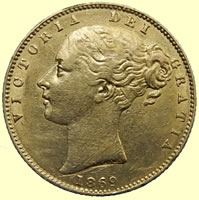 
Mint condition 1869 Victoria full gold sovereign
8.04g, 22mm |
 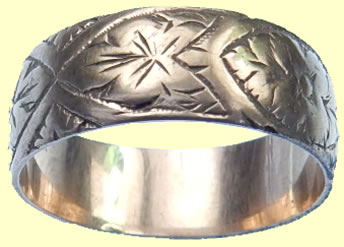
1900 - 9 carat - Birmingham hall mark -Maker TSS
3.90g ,20mm |
  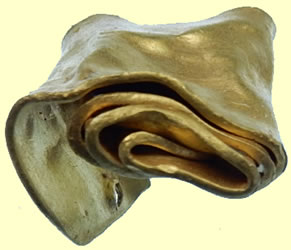
Ancient gold sheet - reported as potential treasure to museum
5.23g, 14mm L |
 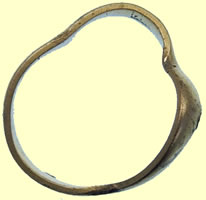
1878 - 22 carat gold ring - London hall mark
2.16g,19.2mm |
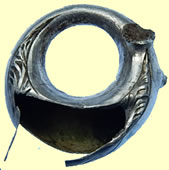 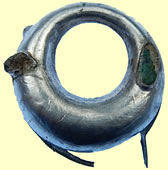
20thC hollow gold ear ring |
 
1953 - 18 carat - London hall mark gold ring - date letter S
23mm, 4.95g |
 
Interesting looking 9 carat art deco style gold ring
2.21g, 19.5mm |
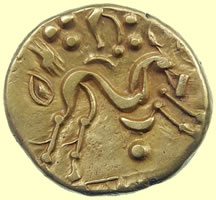 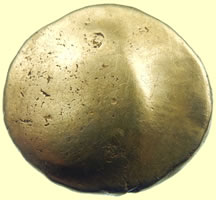
Beautiful strike of a 56 BC Gallo Belgic full Celtic gold stater - sent to PAS for recording
6.26g, 20 mm |
 
Sweet 1989 - 9 carat gold diamon ring - Sheffield hall mark
Maker A.T. L d
1.70g, 20mm dia |
 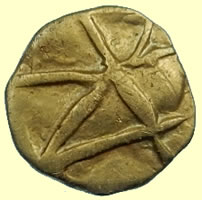
Mint condition - 50 BC Celtic gold Gallic import qtr stater - sent to PAS for recording
Crossed lines with rider ABC 37, VA 37
Classed as scare
1.94g, 12 mm
Caletes tribe, Normandy coast |
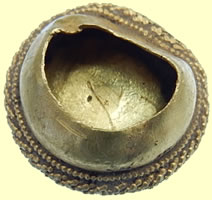 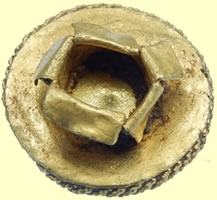 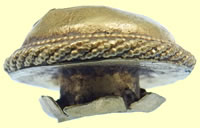
Decorated gold stud reported to museum as potential treasure |
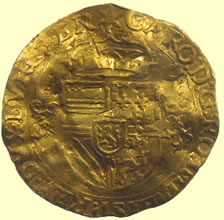 
1544 Netherlands - Holland solar crown - Gold Dutch solar crown of Charles V, Emperor of the Holy Roman Empire, Count of Holland (1506-1555), etc., 0929 Au, 3.41 g, ø 26 mm, value 42 pence, R1, mint mark Canopy (Dordrecht)
42 stuivers
Obv *CARO:D:G:RO.IMP.HISP.REX.DVX.BVR.BR
Rev 1554*DA:MIHI:VIRTVTE:COTRA:HOS TES:TVOS:
Guelders cross
3.41g,25.5mm |
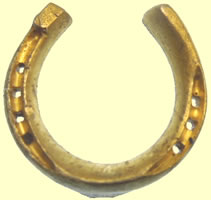 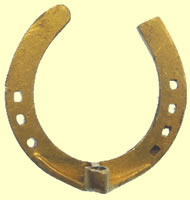
Chucky Victorian 18 carat Gold horse shoe brooch - no hall mark so probably continental
4.95g, 20mm dia |
 
20thC 18 carat gold ring - 4.04g
Marked 18 carat - Continental |
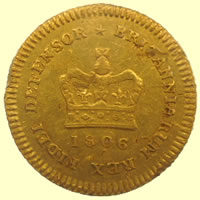 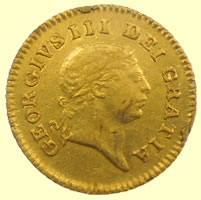
1806 George III milled gold third guinea
|
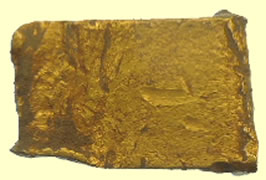 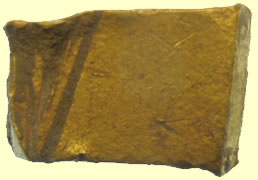
Ancient gold ingot - reported to museum as treasure
3.37g, 12.5mm L |
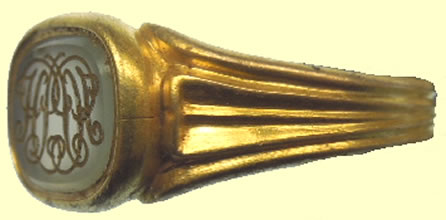 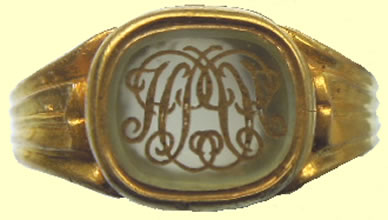
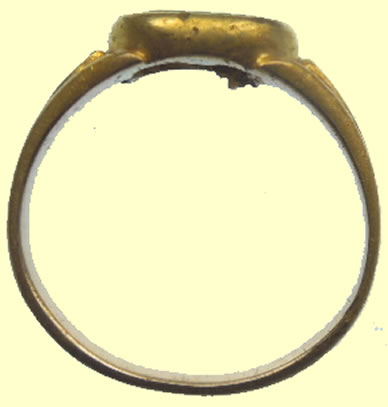
Stunning Georgian gold signet ring - no hall marks - reported to museum as potential treasure if pre 1714
HK ?
|
 
Solid gold Georgian button |
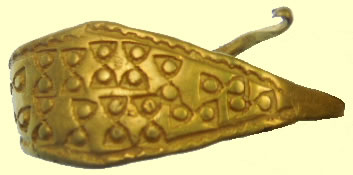 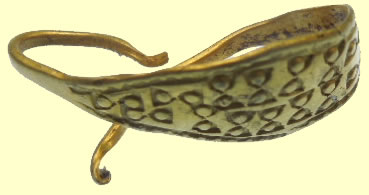
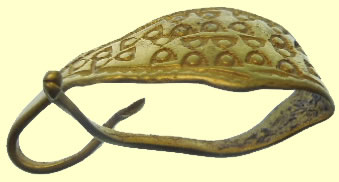
9th-10thC gold finger ring - reported as treasure to meseum
2.05g, 10.33mm W |
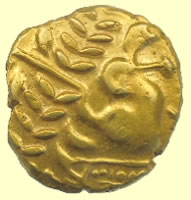 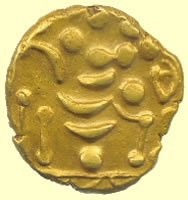
50BC Gallo belgic gold stater - sent to PAS for recording
6.46g, 20mm
Probably British A1 or E stater. |
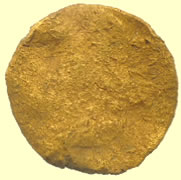 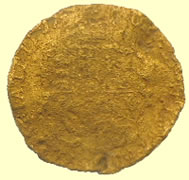
Having difficulty ID'ing this gold coin same weight and size as a
1559 -78 Elizabeth 1st hammered gold half crown ?? but has harp in bottom qtr
2.09g, 16mm |
 
50 BC Celtic gold Gallic import qtr stater - new one for me - sent to PAS for recording
Crossed lines with rider ABC 37, VA 37
Classed as scare
1.86g, 10.15mm
Caletes tribe, Normandy coast |
| 2013/14 Season gold total so far is 71 |
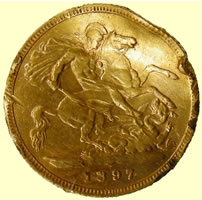 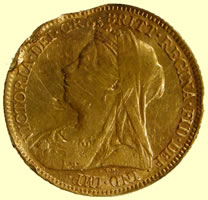
1897 Victorian milled gold half sovereign |
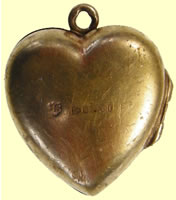 
1891 Gold locket - Chester hall mark, maker JS - Possibly John Sutter of Liverpool
2.52g |
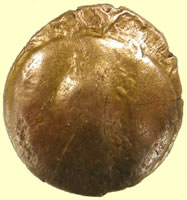 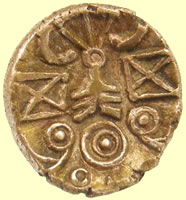
50 BC Uninscribed 'P' gold - 'Trophy' Type - 1/4 Celtic gold coin - 1.38g, 11.99mm
Beaded trophy quater, ABC 2243, BMC 435, not in VA. Extremely rare, 10 others known. An interesting Essex type because of its Kentish associations (derived from the Kentish trophy issue but a separate type), it may have been struck by an otherwise unknown offshoot of the Cantii. |
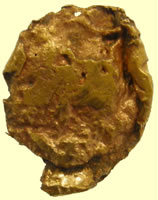 
Ancient gold ingot - 1.36g, 14.74mm Gold coin blank ? reported to museum as potential treasure |
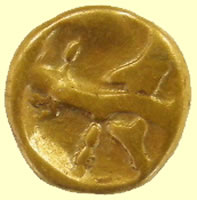 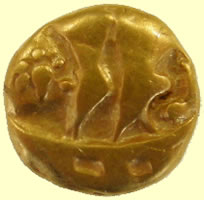
70BC Morini Celtic gold 'boat tree' qtr stater - reported to museum as hoard
1.49g, 9.97mm (E) |
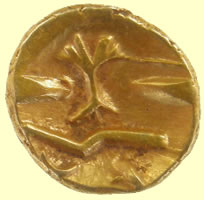 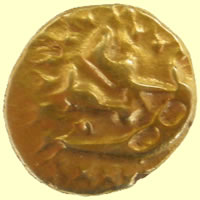
70BC Morini Celtic gold 'boat tree' qtr stater - reported to museum as hoard
1.46g, 11.06mm (J) |
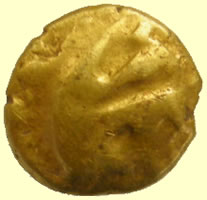 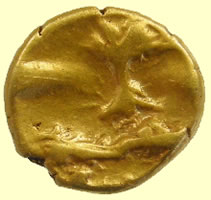
70BC Morni Celtic gold qtr stater reported to museum as haord
1.45g, 10.38mm |
 
Hollow gold ring - interesting decoration - sent to museum for their views in case it is treasure |
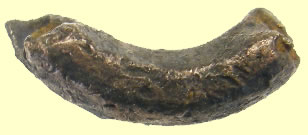 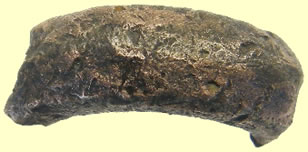
Celtic gold ingot - probably Clacton type by by the impurities - reported as potential treasure to museum |
 
50 BC Trinovantes British G “Clacton” Celtic gold qtr stater - sent to CCI for recording and reported as hoard to museum
1.29g,14.45mm |
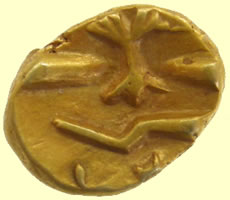 
70BC Morini Celtic gold qtr stater - sent to CCI for recording and reported as hoard to museum
1.46g, 11.55mm |
 
70BC Morini Celtic gold qtr stater - sent to CCI for recording and reported as hoard to museum
1.45g, 10.75mm
|
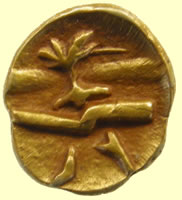 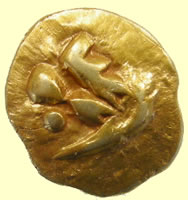
70BC Morini Celtic gold qtr stater - sent to CCI for recording and reported as hoard to museum
1.14g, 11.52mm |
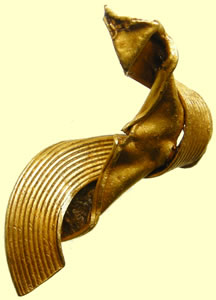 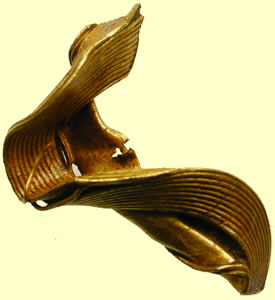

Bronze Age Tress Ring C1000BC
Lock-Rings
Ornaments, whose function is unknown, made from gold plates in triangular cross-section and secured by a binding strip, resulting in a hollow ring. The face plates can be decorated with repoussé decoration or with fine concentric incised lines imitating fine wire works. More rarely, lock-rings are made from face plates obtained from individual gold wires soldered together.
References
-
Eogan, G. 1969. 'Lock-rings' of the Late Bronze Age. Proceedings of the Royal Irish Academy, 67C, 93-148
3.12g,27.07mm long |
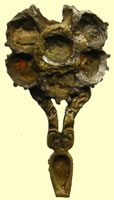 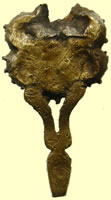
16thC enamelled sectioned gilded silver top and solid gold decorated pendant- reported as treasure to museum
0.84g, 19.36mm L |
|
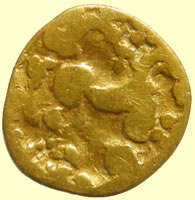 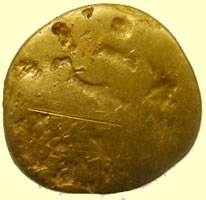
Very interesting Celtic gold qtr gold stater - sent to CCI for ID and recording
Reminds me of a 50BC North Thames type
1.54g, 13.51mm dia
|
 
10-40 AD Cunobelin qtr gold stater - sent to CCI for recording
1.31g, 11.16mm |
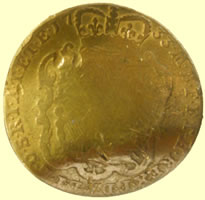 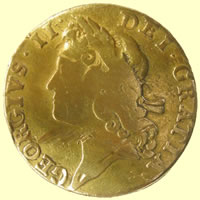
1733 George II milled gold full guinea love token |
 
1892 Victoria old bust milled gold half sovereign (120 pence) |
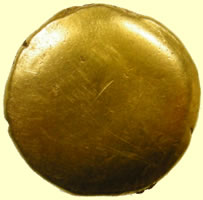 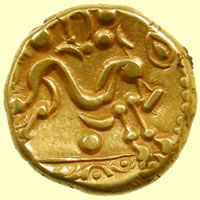
Beautiful strike of a 56 BC Gallo Belgic full Celtic gold stater sent to CCI for recording
16mm,6.28g
'the Gallo-Belgic E 'Gallic War uniface' stater is CCI 14.0530'
John Sills |
|
|
Fascinating gold ring - no hall marks so could be early - 26 diamond/stones and 25 remain - one is loose as in the picture. They look like rough cut diamonds and all are different shapes. 16thC Tudor ??
Under my microscope the settings look very early and I cannot clean it as the stones could dislodge - reported to the museum as treasure |
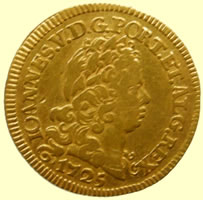 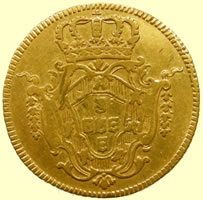
1725 Portuguese milled gold coin - 1600 reis
20mm,3,49g |

Complete unit at the British museum
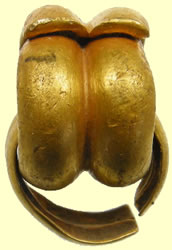  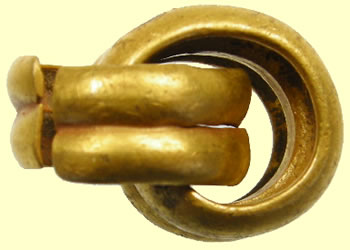
Stunning pair of solid gold 1300 BC armlet rings - reported to museum as treasure
7.06g, 9.25mm W x 11..45mm dia
|
|
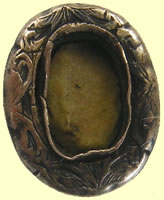 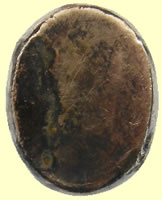
18thC rose gold ring top bezel - missing stone
0.62g, 11.65mm H |
 
70BC Celtic gold Morini qtr gold stater- sent to CCI for recording and reported as hoard addendum to museum
1.47g,11.27mm dia
The Gallo-Belgic D 'boat type' quarter you sent through in February is CCI 14.0529
John Sills |
 
Georgian rose gold button with stone
13mm dia, 1.54g |
|
|
|
 
70 BC Morini boat tree Celtic gold qtr stater sent to CCI for recording
1.45g, 10.51mm |
 
Edwardian rose gold stud |
 
70BC Morini Boat Tree type Celtic gold qtr stater - sent to CCI for recording
1.45g,12.54mm
Reported as hoard to museum |
 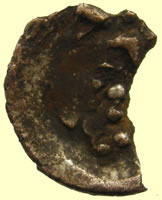
Trinovantes Celtic gold 1/4 stater 50BC - sent to CCI for recording - reported as potential hoard
0.70g, 13.65mm |
 
70BC Morini Boat Tree type Celtic gold qtr stater - sent to CCI for recording
1.46g, 11.41mm
Reported as hoard to museum |
  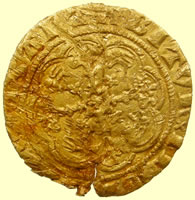 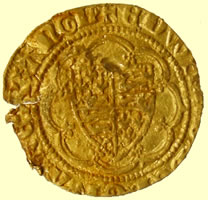
1361- 69 Edward III hammered gold qtr noble - Treaty period - Lis in centre of reverse cross - Curule shaped X - Cross potent - now fixed
Obv + EDWARD DEI GRA REX ANGL
London mint
1.59g, 18.43 mm |
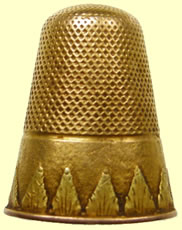 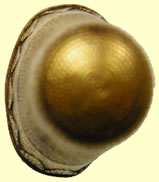 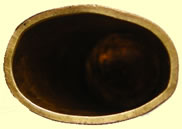
Georgian solid gold thimble
4.67g, 22.75mm H |




Ancient gold ingot 11.7g, 34.99mm L - reported as treasure to museum
Perfect weight to make 2 full Celtic gold staters |
 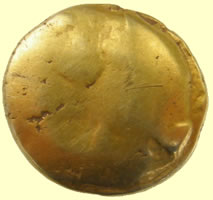
50BC Gallo Belgic Celtic gold full stater - sent to CCI for recording
17.28mm - 6.00g |
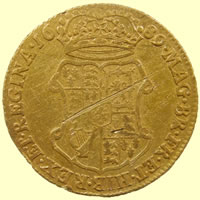 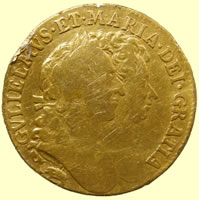
Our rarest ever milled gold coin find - 1689 William and Mary milled gold full guinea - Lion in shield type, elephant under bust
11g, 25.2mm |
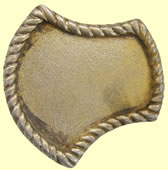 
Victorian gold mount |
|
|
|
|
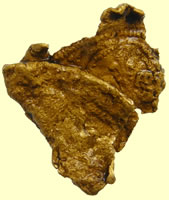 
1346-1361 Edward III gold half noble 2.52g (full weight 4.12g), 25.10mm |
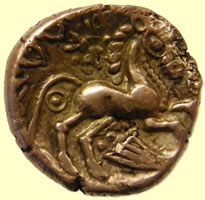 
Addedomaros 45BC Celtic gold stater - sent to CCI for recording 18.32mm, 5.48g
The nice new Addedomaros is 13.0618, good to see a bit of the legend on the reverse.
All the best
John |
   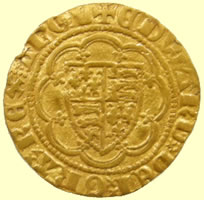
1363 -69 Edward III hammered gold 1/4 noble - Treaty series - now fixed
Curule shaped X - Lis in centre of reverse
Obv EDWARDxDEIxGRAxREXxANGL
18.58mm,1.84g |
 
Addedomarus 45BC Celtic gold qtr stater - sent to CCI for recording
13.22mm, 1.33g
|
 
Addedomarus 45BC Celtic gold full stater - sent to CCI for recording
18.42mm, 5.53g
|
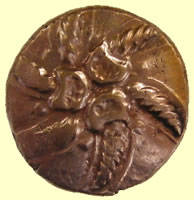 
Addedomarus 45BC Celtic gold full stater - sent to CCI for recording
17.13mm, 5.54g
|
   
4th/5thC Roman gold coin |
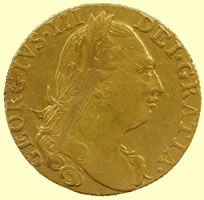 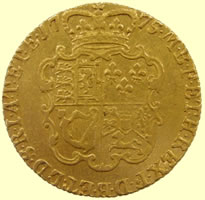
1775 George III milled gold full guinea (21 shllings, 156 pence)
24.64mm,8.41g |
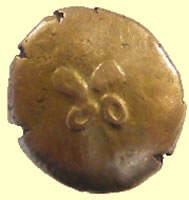 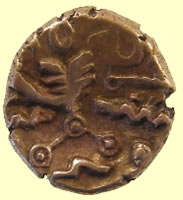
This could be a 50BC Cantii Celtic gold qtr stater - sent to CCI for recording and confirmed ID
11.19mm, 1.40g
Just found Jim's Celtic in my new Chris Rudd book and it is classed as Extremely rare - only 6 to 15 exist
It is a Floret Trophy type VA 146,BMC 436 and as I ID'd correctly attributed to the Cantii tribe |
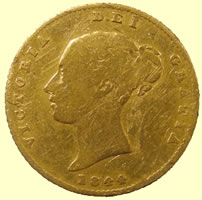 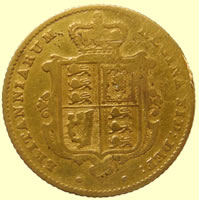
1844 Victoria milled gold half sovereign
|
 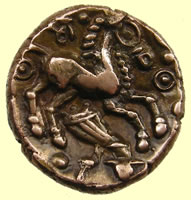
Addedomarus 45BC Celtic gold full stater - sent to CCI for recording
17.70mm, 5.56g |
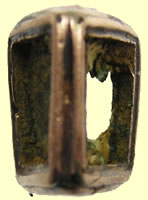 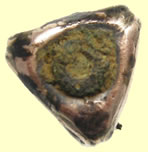
Georgian gold triple sided fob chain hanging decoration - 3 missing stones |
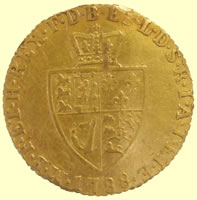 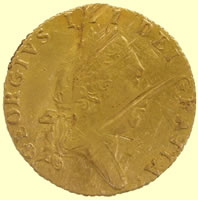
1788 George III gold half guinea |
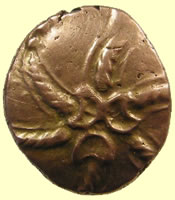 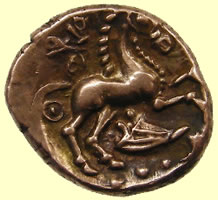
Addedomarus 45BC Celtic gold full stater - sent to CCI for recording & reported as potential addition hoard to museum
18.68mm, 5.61g |
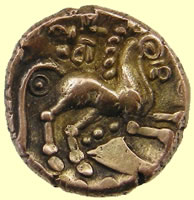 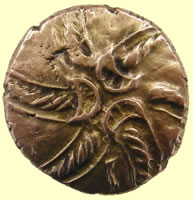
Addedomarus 45BC Celtic gold full stater - sent to CCI for recording & reported as potential addition hoard to museum
17.98mm, 5.57g |
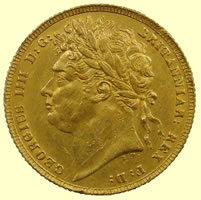 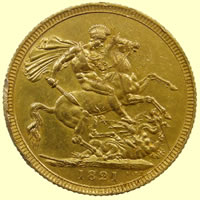
1821 George IV milled gold full sovereign |
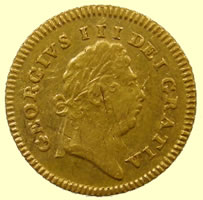 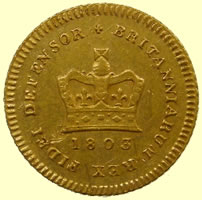
1803 George III milled gold third guinea
2.83g, 17.27mm |
 
10-40 AD Cunobelin gold qtr stater - sent to CCI for recording
1.33g, 12.82mm |
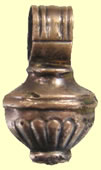 
Georgian gold fob chain decoration |
|
|
|
 
1762 George III 1/4 gold guinea - 15.63mm,2.08g
Love token |
|
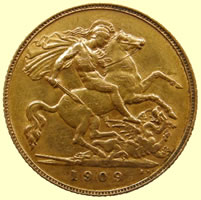 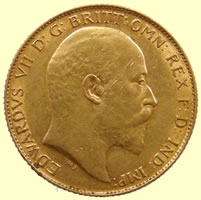
1909 Edward VII milled silver half sovereign |
|
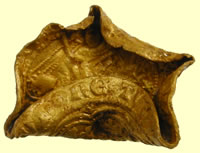 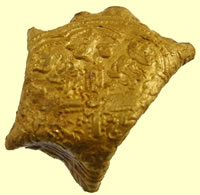
1346-1361 Edward III gold half noble - Closed E at centre of cross - satire stops
Needs straightening for a confirmed ID
4.12g |
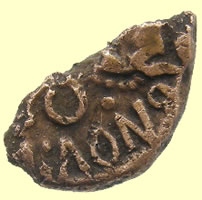 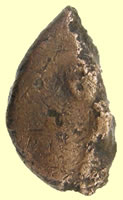
Broken Celtic gold full stater - Dubnovellaunos 5 BC to 10 AD
1.68g, 13.74mm
The broken stater can be 13.0083. By coincidence I was looking at these yesterday, it's a Dubnovellaunos in Essex stater, ABC 2392, BMC 2425-2440, Van Arsdell 1650; there should be just enough of the legend showing to be able to die link the reverse. It's not a particularly rare type, over 100 in the Index at present. Hope the rest turns up, it's not unknown for different fragments of the same coin to turn up years apart!
John |
 
Saxon gold ingot
3.21g, 8.43mm dia |
 
50 BC Clacton type Celtic gold qtr stater - sent to CCI for recording and reported as potential hoard to museum
This example clearly shows the gold, copper, silver mix of these coins
13.62,1.33g
I've recorded the latest Clacton quarter (1.33g) as 13.0083
John
|
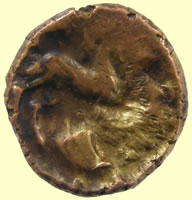 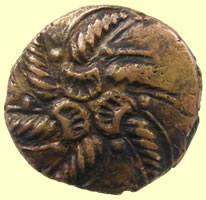
Addedomarus 45BC Celtic gold full stater - sent to CCI for recording & reported as potential new hoard to museum
17.54mm,5.50g |
 
This is a facinating example of a worn die 70BC Morini Celtic gold qtr stater or is it another very rare North Thames type based on Gallo-Belgic D Boat Tree quarters
Reported as potential hoard to museum and sent to CCI for recording
1.45g 10.83mm |
 
This looks like a 70BC Morini boat tree Celtic gold qtr stater but it could be another very rare North Thames type based on Gallo-Belgic D Boat Tree quarters
1.51g,10.18mm |
 
Trinovantes British G “Clacton” quarter, Hobbs 192 Celtic gold 1/4 stater 50BC - - sent to CCI for recording & reported as potential hoard to museum
Chris Rudd 23.41 Clacton de Jersey - Classed as scarce
1.28g,14.25mm |
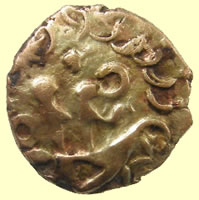 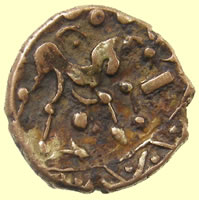
Trinovantes British G “Clacton” quarter, Hobbs 192 Celtic gold 1/4 stater 50BC - - sent to CCI for recording & reported as potential hoard to museum
Chris Rudd 23.41 Clacton de Jersey - Classed as scarce
1.41g, 11.93mm
|
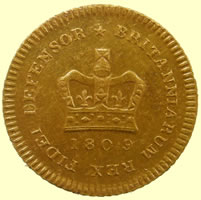 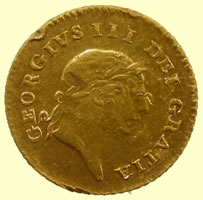
1809 George III third gold guinea - 7th laur.head. |
 
Addedomarus 45BC Celtic gold full stater - sent to CCI for recording
18.27mm, 5.47g |
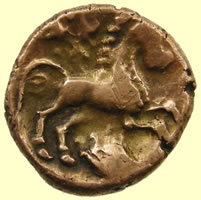 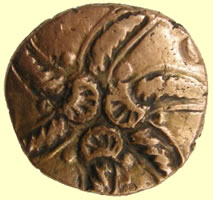
Addedomarus 45BC Celtic gold full stater - sent to CCI for recording & reported as potential hoard to museum
17.63mm,5.48g |
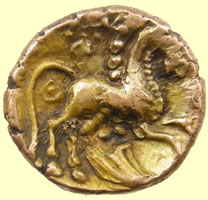 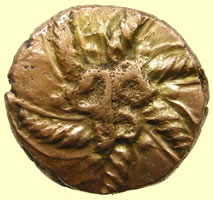
Addedomarus 45BC Celtic gold full stater - sent to CCI for recording & reported as potential hoard to museum
17.43mm,5.51g |
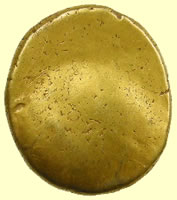 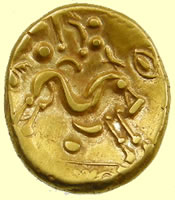
50 BC Gallo Belgic full Celtic gold stater - sent to CCI for recording and potential hoard coin
6.24g, 18.72mm
A nice uniface stater, this is Scheers class 2, probably struck around 57-56 BC and one of the few Celtic coins that can be dated with some accuracy. I've recorded it as 13.0004.
All the best
John |
|
 
Not a 70 BC Celtic Morini boat tree qtr gold stater as I first thought - rare North Thames type
1.48g, 10.58mm
This coin is an important find because although it's a type based on Gallo-Belgic D Boat Tree quarters it's an early British copy, ABC 2454, from the same dies as the one illustrated in the book. Although ABC says it's excessively rare there are actually around 20 known, but there are very few reliable findspots and this one helps to confirm it's a North Thames type. I've recorded it as 13.0002 (got some new numbers through at last).
All the best
John |
 
Georgian gold cufflink - this is an interesting construction as it a thin gold sheet over a copper inner and not plated |
 
10.35mm, 1.46g
70BC Morini boat tree Celtic gold qtr stater - reported to museum as hoard and sent to CCI for recording
The latest Gallo-Belgic D quarter 12.0857; it looks like there should be quite a few more given that half a dozen have come up in fairly rapid succession. This type of hoard is extremely useful because the Gallo-Belgic gold can be dated quite closely so it helps to date the start of British coinage.
All the best
John |
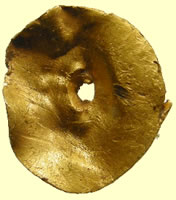 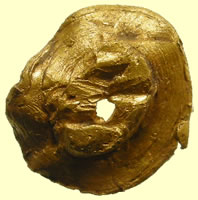
Saxion gold flat pin head base - reported as treasure to museum
0.94g, 10.35mm |
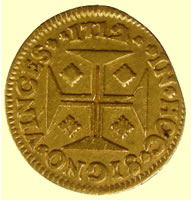 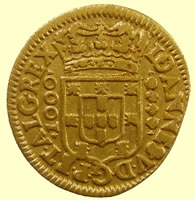
1712 Portugal 100 Reis gold coin
Obverse: Crowned arms with vertical value at left side, titles of John V at right
Obverse Legend: IOANNES V D G ...
Reverse: Jerusalem cross, quatrefoil in angles, date above
Reverse Legend: IN HOC SIGNO VINCES |
|
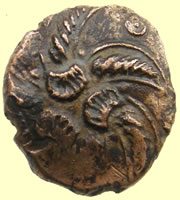 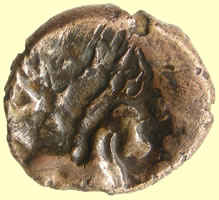
45 BC Celtic stater of Addedomaros - sent for recording to CCI and reported as hoard to museum
5.26g,18.65mm |
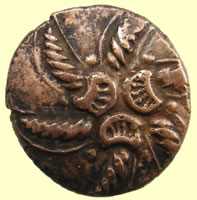 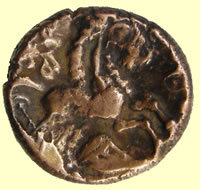
45 BC Celtic stater of Addedomaros - sent for recording to CCI and reported as hoard to museum
5.54g,17.39mm |
|
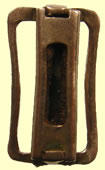 
Victorian gold fitting |
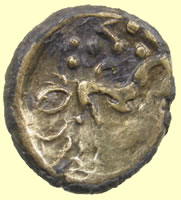 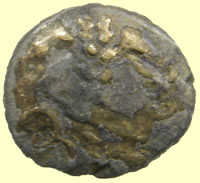 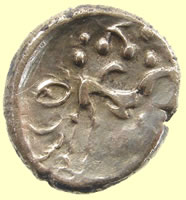 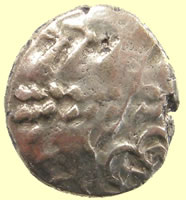
50 BC late British G 'Early Clacton' gold stater - cleaning up and sending to CCI
5.25g, 19.54mm - reported as potential hoard to the museum
CCI 12.0853
|
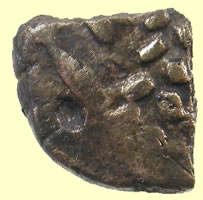 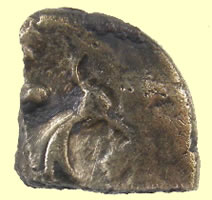
50 BC late British G 'Early Clacton' , reported as potential hoard to the museum
CCI 12.0840
|
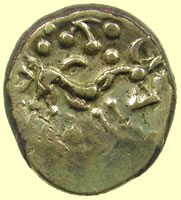 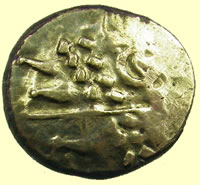
50 BC late British G 'Early Clacton' , reported as potential hoard to the museum
CCI 12.0843
5.07g, 19.7mm |
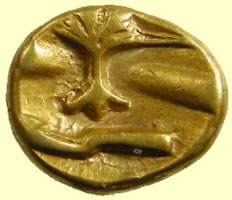 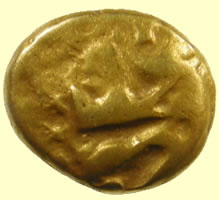
70BC Morini Boat Tree type Celtic gold qtr stater - sent to CCI for recording
1.49g, 10.40mm
Reported as hoard to museum |
 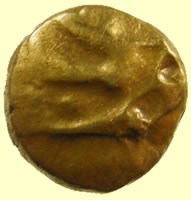
70BC Morini Boat Tree type Celtic gold qtr stater - sent to CCI for recording
1.45g, 9.63mm
Reported as hoard to museum |
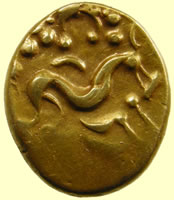 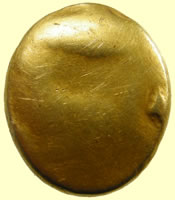
Gallo Belgic 50 BC Celtic gold full stater
6.35g, 17.74mm
Hi Chris
It's a nice early one, from a known reverse die, from near the start of Gallo-Belgic E class 1 so should date to c.57 BC as the series probably began soon after the start of the Gallic Wars in 58/7; CCI 12.0837.
John |
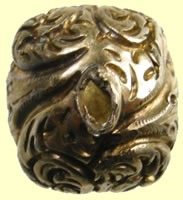 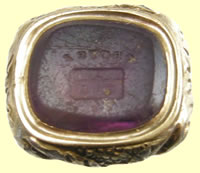
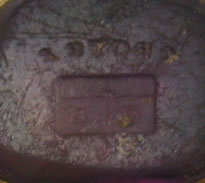
Georgian solid gold fob seal - 'C Royal' |
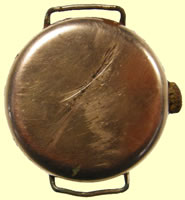 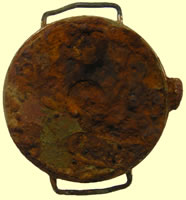
Gold pocket watch |
|
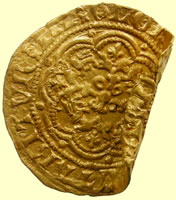 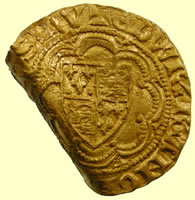
1361 Edward III hammered gold 1/4 nobel
Obv + EDWR + R ++ ANGLIE DVNS HY
Edward III (1361), Quarter-Noble, Transitional Treaty Period, quartered shield of arms, two pellets in upper left quarter, within beaded and linear tressures of eight arcs, pellets on cusps, fleur trefoils in spandrels, all within beaded circle, comma and saltire stops in legend, +edwr;r; anglie: dnvs; hv rev ornamental cross potent with annulets in angles and at centre, lis terminals, lions in angles, lis above lion in fourth quarter, within beaded and linear tressures of eight arcs, trefoils in spandrels, beaded circle surrounding, saltire stops in legend, +exaltabitvr: in: gloria
18.99mm, 1.93g |
 
10 to 40 AD Northern Celtic gold 1/4 stater of Cunobelin - sent to CCI for recording and confirmed ID
Cunobelin wild type quarter,
CCI 12.0752
1.34g,10.8mm |
 
Circa 70 BC Celtic gold qtr stater - first off this type I have seen - sent to CCI for recording and confirmed ID
12.0751) is a Clacton Cross type, ABC 2356, the companion quarter to British F, the Late Clacton stater, ABC 2332. In ABC it's illustrated as a 'three men in a boat' design but the obverse is probably a degraded boar and it should be the other way up; at the moment there are around 30 known, mostly from Essex and Suffolk so it's a definite Trinovantian type.
John
1.42g, 13.55 mm |
 
50 - 20 BC Essex Wheels quarter, VA 260, BMC 485 and 496, ABC 2231. Quite a rare Trinovantian type
1.4g, 14.42mm - sent to CCI for recording and ID confirmation. |

Gold chain link |
 
1422-30 Henry VI, hammered gold noble , first reign (1422-61), Annulet issue (1422-30), London Mint,
Obv **** Z FRANC DNS HYB
2.31g, 35.6gn, 28.1mm |
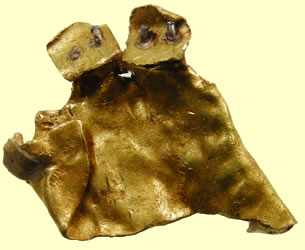 
An incomplete and misshapen gold dental plate of Modern date (c. 1825-c. 1950).
A similar gold dental plate has been recorded from Newport Parish, Isle of Wight. See, Portable Antiquities Scheme find: IOW-D164D2
5.46g, 32.8mm W |
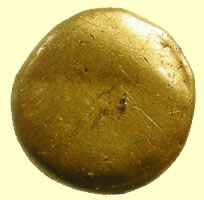 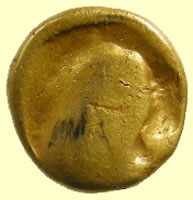
Continental Iron Age Gallo-Belgic DC uninscribed gold quarter state
This is a scarce variant of Gallo-Belgic D, the Face type, Scheers seies 14, my Gallo-Belgic Cd. On one side there's a very worn 'boat' design and on the other a large, kidney shaped blob, also very worn, that looks like an outline face on other coins. In 2003 I suggested they were struck by eastern neighbours of the Ambiani, perhaps by the Viromandui; there were 13 known at the time, perhaps 20-25 now including several from Britain, although I don't have the cards here. I'll give it a number later with the next batch if that's OK with you,
All the best
John
1.60g, 9.43mm
|
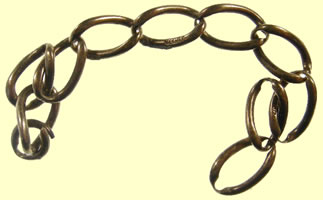
9 carat gold chain - links are marked 0.375 |
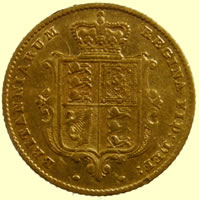 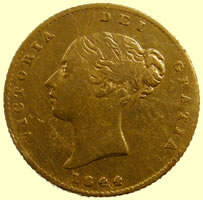
1844 Victoria gold half sovereign |
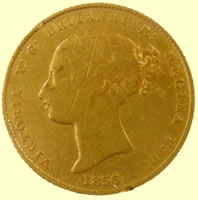 
1856 Australian half sovereign - Sydney Mint |
 
1362 - 1369 Edward III hammered gold half noble - Treaty Period cross potent- annulet before Edw
Obv + EDWARD DEI G REX ANGL
19.16mm, 1.98g |
 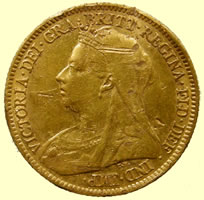
1901 Victoria milled gold half sovereign
|
 
1894 Victoria milled gold half sovereign |
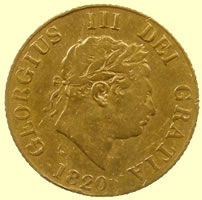 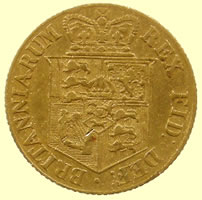
1820 George III milled sold half sovereign |
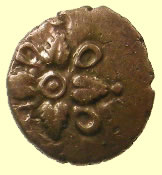 
45 BC Addedomaros Celtic gold qtr stater
1.26g, 11.98mm |
 
1799 George III gold 1/3rd guinea
|
| Season 2011 - 2012 Another record gold year for the club with 51 pieces |

Victorian gold pencil fragment |
 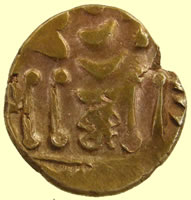
50 BC Celtic gold full stater - Clacton type
6.43g, 20.30mm Ref Hobbs 142
British A1 or E stater. This coin is from the same obverse die that was later used to strike the Waldingfield type, VA 1462, ABC 2335. It’s from an unrecorded reverse die with an uncertain symbol below the horse and is midway between the Westerham and Waldingfield types, if anything closer to the latter, which is extremely rare (not the Clacton type though this particular coin is very similar)
CCI 12.0367 |
 
10 to 40 AD Northern Celtic gold 1/4 stater of Cunobelin Inscribed CAM CV AGR Ref Hobbs 1854
12.3mm.1.26g
Cuno AGR quarter, BMC 1854, ABC 3002, not in VA. Extremely rare, good to see the full AGR and the bottom of the flan on the reverse despite the chip.
CCI 12.0375 |
|
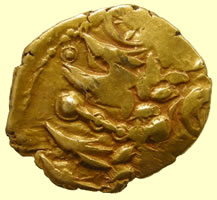 
Eastern uninscribed gold quarter stater, type attributed to the Trinovantes, struck c 50-20 BC.
VA 260 = BMC (Hobbs) 482 and 489.
14.65mm,1.39g
Essex Wheels quarter, VA 260, BMC 485 and 496, ABC 2231. Quite a rare Trinovantian type, two others from this pair of dies.
CCI 12.0371 |
 
70 BC Morini 'boat tree' Celtic qtr stater
1.42g,10.14mm
Gallo-Belgic D ‘boat type’ quarter, Scheers class 3
CCI 12.0366 |
 
A Continental Iron Age Gallo-Belgic DC uninscribed gold quarter stater, Gallo-Belgic DC , dating circa 70-50 BC. VA 69-1.
1.60g, 9.23mm
Gallo-Belgic D quarter (my G-B Ca). Probably my class 3, obverse worn flat
CCI 12.0365 |
 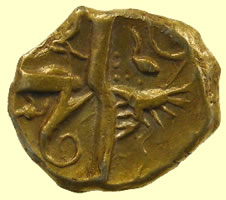
Stunning Celtic gold 1/4 stater- Unique animal design
1.45g,11.83mm
A gold Iron Age quarter stater, Early Uninscribed British series O 'Geometric' type, c.100-50 BC. Obverse close to Hobbs no. 416; VA1225
CCI 12.0369
Ingoldisthorpe quarter, ABC 2448, not in VA or BMC. Another extremely rare type, good to have a reliable findspot, this one is from the same dies as ABC 2448 itself.
|
|
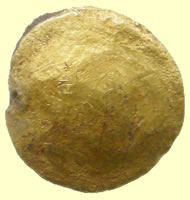 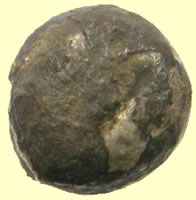
Saxon Gold ingot - sent to Fitzwilliam museum for recording
1.63g, 9.93mm |
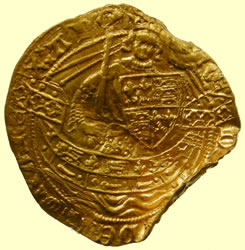 
1327 Edward III hammered gold half noble - Cross 3 - E in centre of reverse cross
Obv EDWARD DEI GRA REX ANGL
24.79mm, 3.89g
|
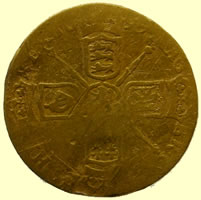 
1695 William III gold half guinea - rarer than hens teeth |
 
50BC Celtic gold 1/4 stater - probably Snettisham type
1.57g, 14.22mm
Gallo-Belgic Aa quarter, probably my class 3 but too worn to be certain
CCI 12.0364 |
 
Plain medieval gold ring - reported as treasure to museum
2.37g, 22.16mm |
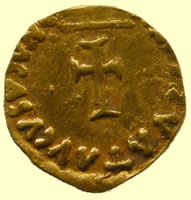 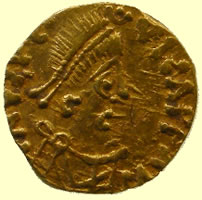
Merovingian tremissis of the 7th century
Saxon gold coin - this is part of an existing hoard and reported as hoard to the museum
Sent to Fitzwilliam museum for ID and recording
1.18g, 11.73mm |
 
Merovingian tremissis of the 7th century
Saxon gold coin - this is part of an existing hoard and reported as hoard to the museum
Sent to Fitzwilliam museum for ID and recording
This sucker is tiny and mint 1.30g, 10.21mm, totally different from the others |
 
Gold ring with full set of hall marks- London 1942 - Maker *B
2.91g,19.33mm |
|
 
10-40 AD Cunobelin Celtic gold full stater - very rare bigga type
5.51g, 16.86
Cunobelin biga stater, VA 1910, BMC 1769-1771, ABC 2771. Still very rare.
CCI 12.0372 |
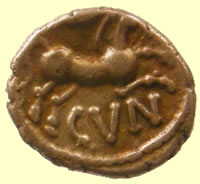 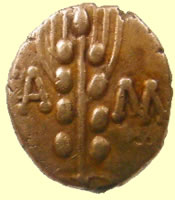
10-40 AD Cunobelin Celtic gold qtr stater - 11.55mm, 1.33g
Cunobelin linear type quarter, VA 1927, ABC 2810
CCI 12.0373 |
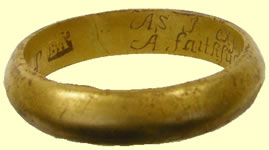  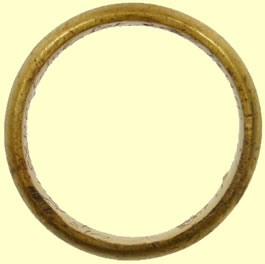
Stunning 17th/18thC gold posy ring - reported as treasure to museum
21.85mm,6.73g
Brilliant misspelled inscription
'AS I EXPECT SOE LET ME FIND
'A FAITHFUL FREIND AND A CONSTANT MIND'
|
 
10-40 AD Cunobelin Celtic gold qtr stater - 11.89mm,1.22g
Cunobelin wild type quarter, VA 1935, ABC 2813
CCI 12.0374 |
 
1803 George III 1/3 gold guinea |
|
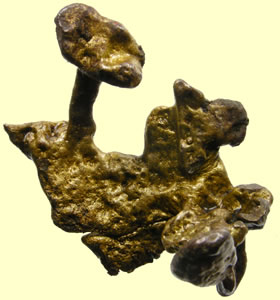 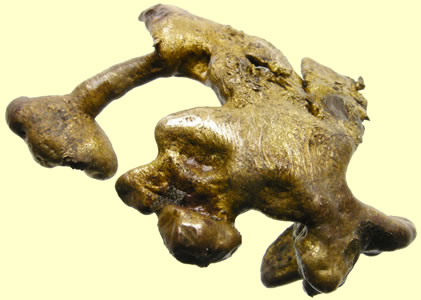
Saxon gold casting waste 59.49 g, 60.61mm wide |
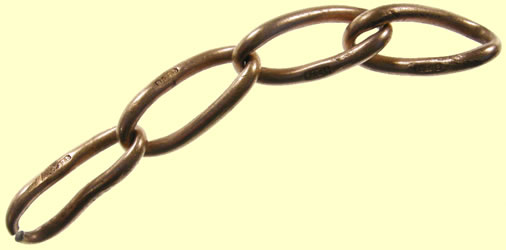
Large Victorian gold fob chain - each linked is indivdually marked 0.375, 9carat gold |
 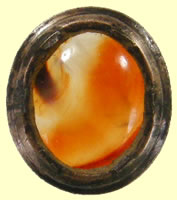
Georgian intaglio with gold bezel - bust facing right |
 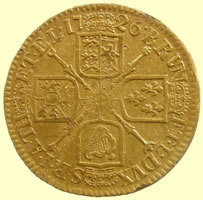
1726 George 1st milled gold full guinea |

Stunning 17th/18thC enamelled solid gold button - reported as potential treasure to museum
2.78g,15.26mm
|
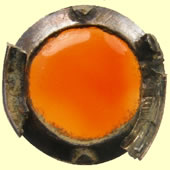 
Georgian gold brooch fragment |
 
50 BC Celtic gold full stater - Gallo Belgic
16.49mm, 6.05g
Gallo-Belgic E stater, Scheers class 4. Standard example of the type, several hundred known
CCI 12.0363 |
 
 
17th/18th gold posey ring reported as treasure to the museum
3.29g, 20.16mm dia
'LOVE AS' YOU ELSE I DIE' - maker mark - old English FC |
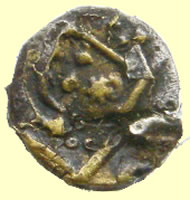 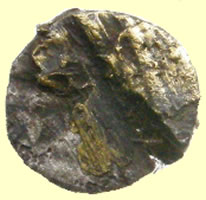
The smallest ancient gold coin I have ever seen dug - Size of a Saxon sceat with Celtic gold type markings - checking the ref books as I have never seen a gold like this before. 0.42g, 7.85mm |
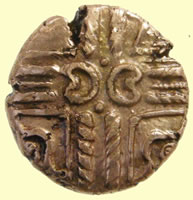 
50 BC Middle Whaddon Chase stater Celtic gold full stater 5.45g, 17.21mm
Obv cross of 3 plain & 2 pellet lines with 2 opposed crescents b in centre
Rev horse r ., above pellet in ring, pellet in wheel below
Middle Whaddon Chase stater, VA 1491, BMC 343, ABC 2240. An extremely rare type, only 7 others known, very nice to see another one. This one seems to be from the same obverse die as 95.2630, same rev as CR 116, 2011, no. 32. Reverse similar to early staters of Addedomaros but an uninscribed type, much rarer.
CCI 12.0368
|
 
50 BC Uninscribed 'P' gold - 'Trophy' Type - 1/4 Celtic gold coin -1.33g, 10.43mm
Beaded trophy quater, ABC 2243, BMC 435, not in VA. Extremely rare, 9 others known. An interesting Essex type because of its Kentish associations (derived from the Kentish trophy issue but a separate type), it may have been struck by an otherwise unknown offshoot of the Cantii.
CCI 12.0370 |
 
9 carat gold - .25 carat diamond ring - 1.51g
Continental and English hall marks - HG Ltd |
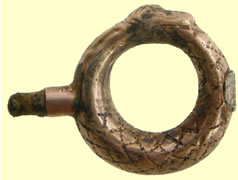 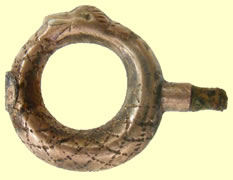
Really neat gold Georgian watch winder - snake biting its own tail |

Iron Age pure gold wrist or ankle Torc fragment - 1.63g, 30.18mm L x 2,5 mm dia - reported as treasure to museum |



12thC Early medieval gold ring - reported as treasure to museum
Interesting hand punched lettering which has a barred A with additional top bar like on short cross coins of Class7 and an unbarred A also on the ring.
4.22g, 4.49mm H x 22.59mm W
|
 
Georgian gold collar studd |
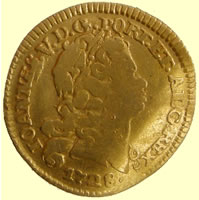 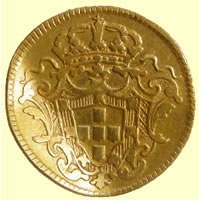
1728 Portuguese Joao V milled gold - 1/2 Escudo (800 Reis) 0.9170 Gold
John V of Portugal |
 

15th/16thC gold ring -reported to museum as treasure - no hallmarks
18.71mm, 1.05g |
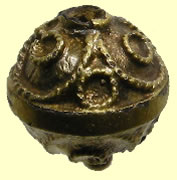 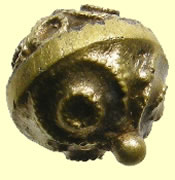 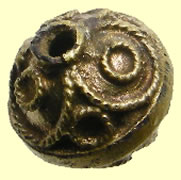
Stunning gold 16thC Tudor pin head - reported to museum as treasure |
 
22 carat 1852 Victorian bust mark London hallmarked gold ring |

Georgian gold watch winder |
 
1915 - 9 Carat gold ring - Birmingham date letter q - Maker RF
Robert Pringle & Sons
Clerkenwell Road
London EC1 |
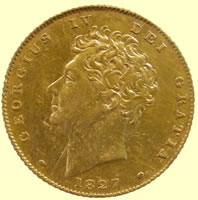 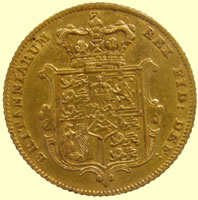
Very crisp 1826 George IV milled gold half sovereign |
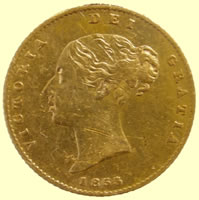 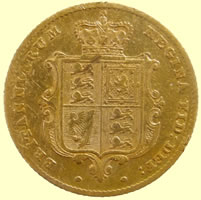
1855 Victoria milled gold half sovereign |
 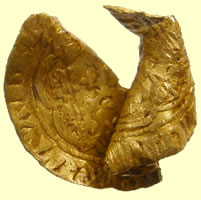
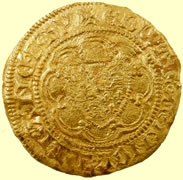 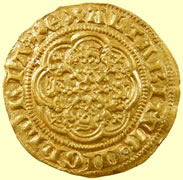
C1351 Edward III hammered gold qtr noble - needs straightneing to D exact type
1.79g
|
 
1853 Victoria milled gold half sovereign |
  
1834 gold ring - London with duty paid bust Maker is probably James Young
1.43g, 19.55mm |
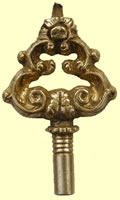
Solid gold Georgian watch winder
3.59g,28.28mm |
Season 2010/11 Total gold finds 50 |
|
 
Eastern uninscribed Celtic gold qtr stater of Dubnovellaunos, c 20 BC
12.25mm,1.3g
Dubnovellaunos in Essex quarter, VA 1660, BMC 2442, ABC 2395 CCI 12.0379 |
|
|
|
 
Beat to death mid 4thC House of Constantine Roman gold coin
3.74g,21.23mm |
 
16th/17th gold ring - reported as treasure to museum - no hallmarks
22.55mm,0.80g |
Roman gold ring -decorated with hanging fruit and vine
1.46g, 24.49mm
|
|
 
Early 70BC uninscribed 'Q' Gold - 'Remi 'Type Celtic gold qtr stater
1.35g, 12.24mm
Maldon Wheel quarter, not in VA or BMC, ABC 2234. Extremely rare, 12 others known, struck from known dies but from a new die combination so a very useful coin to have, especially with a reliable provenance.
CCI 12.0378
|
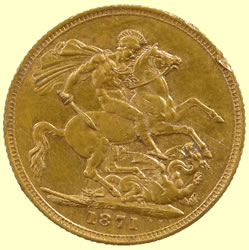 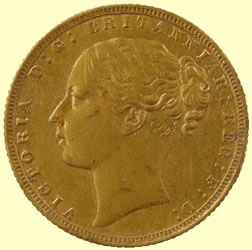
Stunning 1871 Victorian gold full sovereign - George and the dragon reverse
8.04g,22.06mm
|
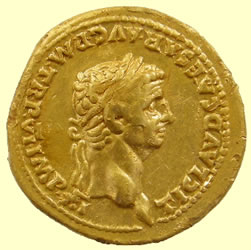 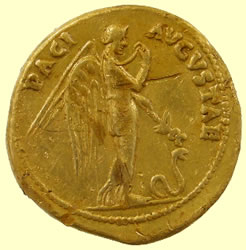
Roman gold coin - sent for ID 19.6mm, 7.81g
Oh man, is that ever beautiful!
That is, of course, an Aureus of the emperor Claudius (41-54 AD) the presumed-to-be "simple-minded", somewhat disabled uncle of Caligula. He was seized upon by the Praetrorian guard as a tractible replacement after they had murdered Caligula, his wife and child. It turned out that Claudius was smarter than most of the Julio-Claudians and had merely allowed everyone to think he was simple-minded. This allowed him to hide in the background, out of the way of the endless palace intrigues. The successful ruse evidently kept him from suffering the sort of "mysterious" death which seemed to stalk all the other Julio-Claudians who might be in-line for or have some claim to being emperor. Once in power, he showed that far from being "simple", he was a shrewd and canny politician and proved to be a benificent ruler as well, righting a lot of the wrongs perpetrated by his evil nephew. Eventually, however, his love of women was his downfall. Marrying his neice, Agrippina Jr., the last of his succession of unfortunate marriages, he had inadvertantly adopted and brought into his home one of the true vipers in the Imperial nest, her son, the future emperor Nero. It is assumed that Agrippina, on her son's behalf, (or possibly even Nero himself) was responsible for feeding him a dish of deadly poisonous mushrooms. This removed the last impediment and cleared the way for Nero to become emperor.
This is one of the more common reverse types for Claudius' aureii, the PACI AVGVSTAE or "The Emperor's Peace". It has an interesting reverse type, too. Rather than Victory, whom you might assume was the winged character on the reverse, this is "Pax-Nemesis" performing a gesture associated with a uniquely Roman bit of superstition. She is drawing out a fold of her gown in what is called in some delicate circles an "Apotropaic gesture" - in other words, she's spitting on her own breast, which, like throwing a pinch of spilled salt over one's shoulder or touching wood, was a common superstitous custom among Romans and meant to deflect bad fortune.
This piece was struck in 41-42 AD at the imperial mint for precious metal coins, which happened at the time to be in the provincial capital at Lugdunum (modern Lyons) and coincidentally was also where the future emperor Claudius had been born.
This is actually one of the more common types of early Roman Imperial Aureii, but "common" here is all relative - particuarly in recent months, Roman Aureii have been bringing astonishing amounts of money - I wouldn't even venture a guess as to what the current market value of this piece might be - most likely at least in the 5-figures range of GBP's, Euros or Dollars.
Mark
|
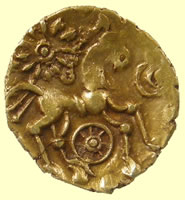 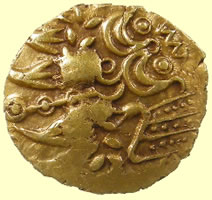
Early 70BC uninscribed 'Q' Gold - 'Remi 'Type Celtic gold qtr stater
Rev .horse r.,from nrck pellet ring var.d above pellet in ring,flower j & pellet-in-ring,before 4 pellet-in-rings,below wheel f & pellet, below & above tail pellet-in-ring triangle
1.34g,14.86mm Hobbs 482 |
 
Monster sized fragment of a Circa 1327 AD Medieval hammered full gold Noble- ship reverse
23.63mm ,1.47g
|
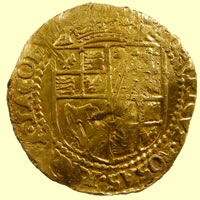 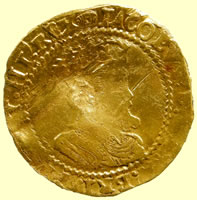
1615-16 James 1st hammered silver Britain crown - Tun mintmark
2.46g, 20.03mm |
 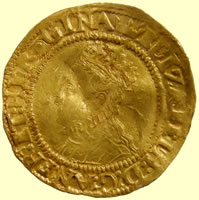
1567-70 Elizabeth 1st hammered gold crown (60 pence) - Coronet mintmark
2.80g, 22.12 |

Ancient gold ingot - reported as treasure to museum
|
 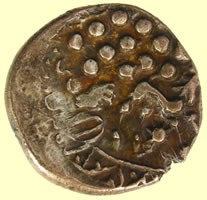
Excellent heavy full stater - 70 BC Early uninscribed British Gold stater
Disjointed horse, pellet below
19.76mm, 6.13g
Late Clacton stater, VA 1455, ABC 2329. There are two main varieties of this type, one with a simple pellet below the horse and the other with a winged pellet or star; this is the latter type which is rarer than the simple pellet type, with only 10 others known.
CCI 12.0377
|
 
1799 George III half golf guinea |
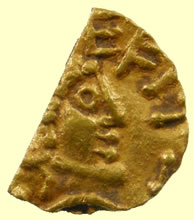 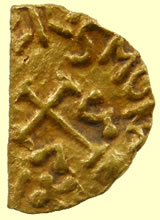
Monster find C600 AD English Saxon gold - probably crondel type - reported as hoard to museum and sent off to Dr Martin Allen for ID
0.87g, 12.39mm |
 
Treaty series 1361- 1369 Edward III hammered gold 1/4 noble - Std C type, Double Satire stops - Voided quatrefoil in centre of reverse
Obv EDWARD DEI GRA REX ANGL
1.93g, 19.16mm |
|
 
1855 Victorian gold Sovereign |
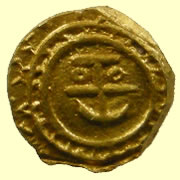 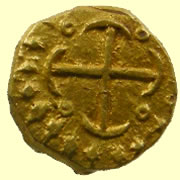
c 8thC Saxon gold coin - sent to Fitzwilliam museum for recording and ID
Unusually thick coin for a Saxon
1.31g,9.51mm x 1.61mm thick
|
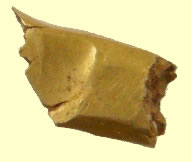 
Ancient gold bar 3.80g, 12.71mm long reported as treasure to museum |
|
Tenn Brad is decipering the latin inscription
|
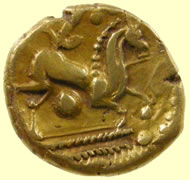 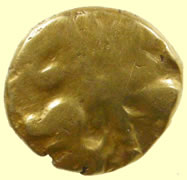
1stC BC Uninscribed 'L' 'Waddon Chase type' Celtic gold full stater - sent to CCI for recording
5,86g, 1.6mm
'These coins are probably not very much earlier than the Addedomaros staters - it all depends really on when one dates the Addedomaros issue. It seems fairly certain that the Whaddon Chase staters could be from the later stages of the Gallic War, say about 54 BC at the earliest; they could be a little bit later, but are unlikely to be after say 40 BC at the very latest.'
Dr Philip de Jersey
|
|
 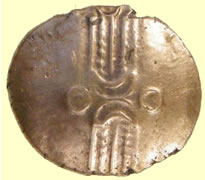
Eastern uninscribed Celtic gold full stater of Dubnovellaunos, c 20 BC
Sent to CCI for recording
5.41g, 18.45mm
|
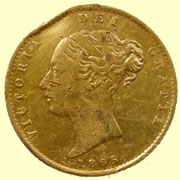 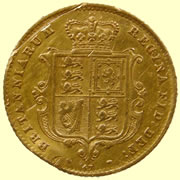
1865 Victorian milled gold 1/2 sovereign
|
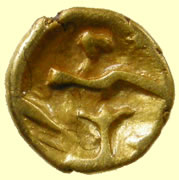 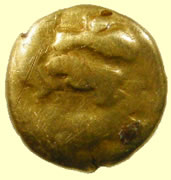
70BC Morini Celtic 'boat tree' gold qtr stater - Sent to CCI for recording 1.41g, 10.81mm |
 
1762 George III milled gold 1/4 guinea - 5 shillings 3 pence
|
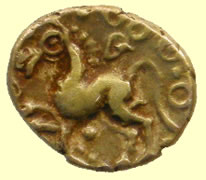 
c20 BC Dubnovellaunus tribe Celtic gold qtr stater-11.73mm,1.32g - Sent to Ian at the CCI for recording
Recorded as CCI 10.1046.
Gold quarter stater of Dubnovellaunos, c. 20 BC-AD 10
Linear wreath, with opposed crescents; Horse left with branch below and trefoil design above
VA 1660, BMC 2442
Around 25 provenanced examples of this type are known.... mainly from Essex or the Essex or Herts borders.
Ian
Ps. Note the figures for the British G quarter stater were also PROVENANCED examples only!
CCI 10.1045 |



Gold ring - 1980 Birmingham hall mark - 22 carat 3.17g, 22.98mm dia |
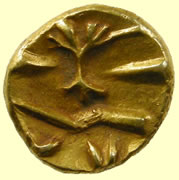 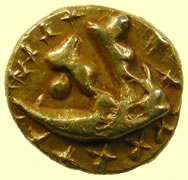
70BC Morini Celtic 'boat tree' gold qtr stater - Sent to CCI for recording
Very interesting example being the lightest we have ever found and the smallest diameter. Normal weight range of a Morini is 1.41-1.45g
Also a very different die type so it will be interesting to see the comments from the CCI experts
1.23g, 9.22mm |
 
70BC Morini Celtic 'boat tree' gold qtr stater - Sent to CCI for recording
1.45g, 10.80mm |
 
70BC Morini Celtic gold qtr stater - Sent to CCI for recording
1.48g, 10.86mm
Gallo-Belgic Dc gold quarter stater. “Morini”, c. 60-50 BC.
“Boat” and “tree” like designs
Delestree & Tache 249, VA 69-1, Scheers 13, pl. 5.115-117.
These are obviously pretty common finds all along the Thames/SE.
Ian
|
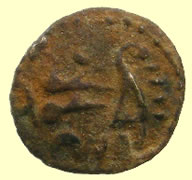   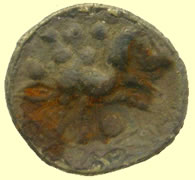
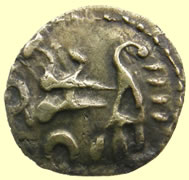 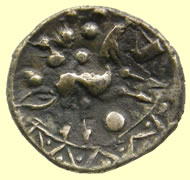
1stC BC Celtic gold 1/4 stater- sent to CCI for recording and ID
Pictures as dug and after partial 'cooking'
14.46mm, 1.40g
This one has been allocated the CCI number 10.1044.
It is a British G “Clacton” quarter, Hobbs 192 (he mis-identified it as an H quarter for some reason). At least 44 known before this – from right across the area most people would label as territory of the Trinovantes...
Ian
|
|


Georgian gold watch winder
|
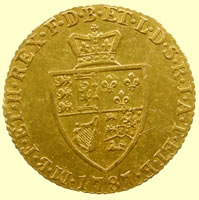 
1787 George III milled gold half guinea
|
|
found by Org Eric |


1917 Chester hallmarked 18 carat gold ring with diamond maker W&H Ld
William Hutchinson
Belgrave Terrace
Birmingham
Assay Office Chester |
 
Celtic gold qtr stater Cunobelin biga type 10 to 40 AD
Sent to CCI for recording 1.36g, 10.93mm
Cunobelin biga stater, VA 1910, BMC 1769-1771, ABC 2771. Still very rare.
CCI 12.0372
|
 
1361 -9 Edward III hammered gold 1/4 noble - Treaty period
|
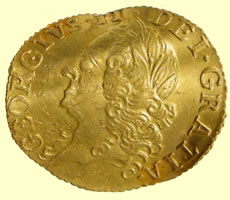 
1755 George II gold half guinea
|
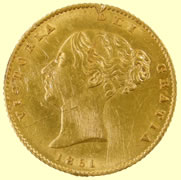 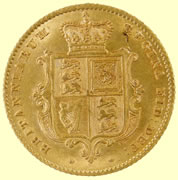
1851 Victoria milled gold half sovereign |
 
HH makers mark -Business founded in 1847 by James William Harrison, Henry Harrison and Willian Howson as successors of Thomas Sanson & Sons. |
|
Total
Gold finds 45 for season 2009/10 |
|
Ancient gold fragment - reported as treasure to museum - could be a Celtic qtr stater broken blank |
| |
 
1361-69 Edward III hammered gold qtr noble - treaty period - quatrefoil in centre:cross over shield
1.94g, 19.10 mm
|
 
1777 George III gold half guinea
|
  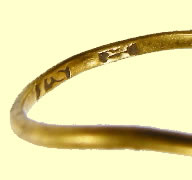
Medieval gold ring - inscribed LUV - reported as treasure to museum
0.74g, 16.74mm |
 
Man's gold signet ring - inscribed LW
Maker P&G 9 carat Date letter W - still working on the date
4.70g, 23.32mm
|
 
1890 9 carat gold ring - Birmingham hall mark - Marker JM
3.36g, 18.95mm |
 
Celtic qtr stater sent to CCI for recording and ID
13.36mm, 1.34g
The first, as you know, is a Gallo-Belgic DC gold quarter stater, c 70-50 BC.
VA 69-1
I cant check the dies at the moment because I am at home. Note though die links do not need to suggest the movement of people between the two villages, as the coins can move at the point of their production and supply rather than during their subsequent 'use' or circulation.
I have given this the CCI number 10.0887
The second is an Eastern uninscribed gold quarter stater, type attributed to the Trinovantes, struck c 50-20 BC.
VA 260 = BMC (Hobbs) 485 and 496.
These are interesting as they are clearly of Southern style (Atrebates etc), but are an Eastern or North Thames (Trinovantes etc) type as the distribution of findspots seems to show.
I have records of 20 provenanced examples of these (including 12 Essex and 4 suffolk)
I have given this the number 10.0888
Ian
|
 
70BC Morini Celtic gold qtr stater - Sent to CCI for recording
1.44g,10.27mm
CCI number 10.0887
|
 
18.74mm, 5.62g
Outer Band - In memory of
Inner inscription - Anna C Round Ob 5th Ap 1822
Maker TM -18 carat Sheffield hallmark 1829 |
 
Medeival twisted wire gold ring - no hall marks
22.34mm, 2.73g |
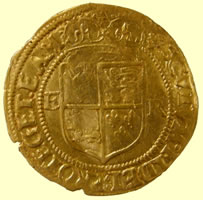 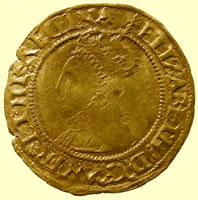
1560-61 Elizabeth 1st gold half crown - mintmark cross crosslet - 0.994 fine gold
1.40g, 18.63mm |
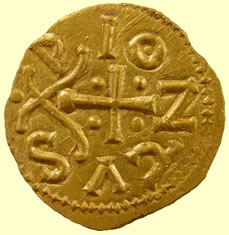 
Merovingian tremissis of the 7th century
1.26g,15.08mm
This coin (EMC 2010.0131) is a Merovingian tremissis of Coutances (dep.
Manche), moneyer Piontus, from the same dies as Belfort 1681, Prou 299.
The obverse names the mint *CVSTANCIA [S reversed] and the reverse names the moneyer PIONtVS. Priou reads the moneyer's name as tVSPION but Belfort's reading PIONtVS is now accepted as the correct one.
Keep looking.
Martin
|
 
c 600/800 AD English Saxon gold coin send to Fizwilliam museum for ID and recording
Not shown in any book I have ???
1.35g, 13.87mm
'Saxon' gold coins not in the reference books are usually Merovingian tremisses, and this coin (EMC 2010.0130) is no exception to this rule.
The coin seems to be unworn and from relatively undamaged dies, but the inscriptions are garbled. I have not found any similar coins in the reference books on Merovingian coins (which is not unusual), but if I receive any clarification from one of the continental experts on Merovingian coins I shall let you know.
Merovingian gold coins greatly outnumber Anglo-Saxon gold coins as finds in England.
With thanks,
Martin
|
 
Georgian gold brooch - no hall marks but note the number 2 inscribed where the stone would have been
|
 
1stC BC Celtic gold qtr stater - Eastern gold attributed to Dvbnovellaunos tribe
Sent to CCI for recording 1.34g,11.67mm
Hobbs 2442 Page 146 Colchester find
'Eastern uninscribed gold quarter stater of Dubnovellaunos, c 20 BC-AD 10. Van Arsdell VA1660 =BMC 2442.
CCI number: 10.0874'
Ian
|
|
Ancient gold ring bezel ? -cloisonné enamel-work - probably Roman - reported to museum as treasure
1.25g, 9.84mm dia
|
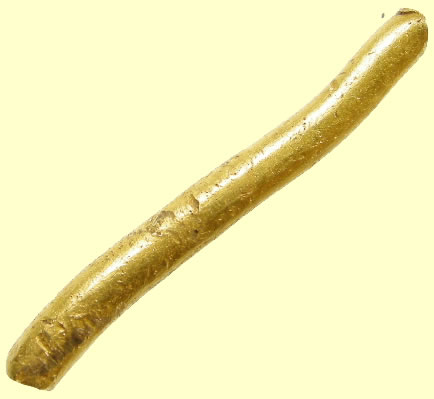
Ancient gold ingot - possible wrist or ankle torc fragmetn3.48g, 3.45mm dia , 29.86mm L- reported as treasure to museum |
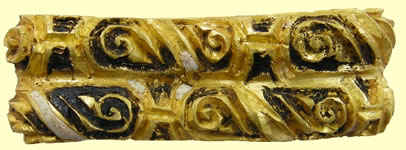
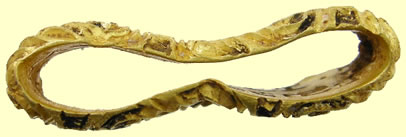
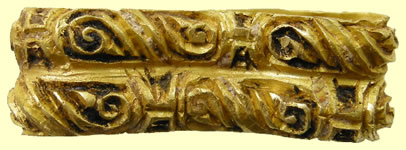
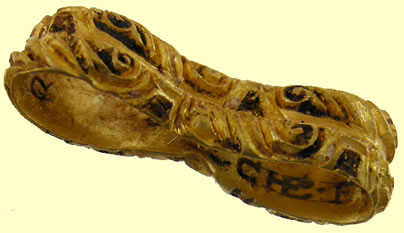 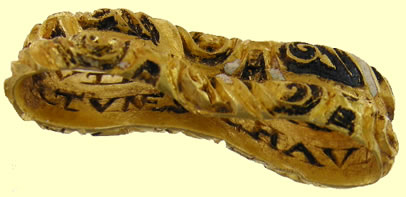
My intitial thoughts were Roman but the legend has me baffled - reported as treasure to the museum
Stunning Black and white enameled gold ring - double banded with inscription on both upper and lower bands.5.83g, 25.91mm L x 8.40mm W
Top legend -LEI TRVTE ADVANCE
Bottom legend - ECHE . FORTVNES CHAVNG
|
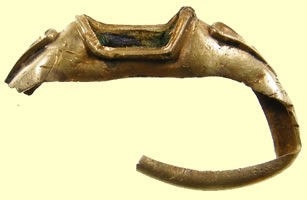 
Romano/British Ancient gold ring - reported as treasure to the museum
1.53g, 26.17g
|
 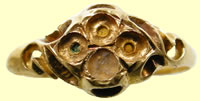 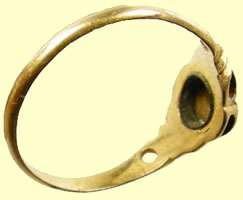
16th/17thC gold ring - no hall marks 1.75g, 18.51mm dia - reported to Colchester museum as treasure
|


Ancient gold ingot - 0.76g, 10.76mm long
Chunk of ancient gold - reported to Colchester museum as treasure |
  
Medieval gold finger ring - reported as treasure to Colchester museum
1.71g,15.40g
|
 
 
1726 gold mourning ring - Legend with black enamel reads
TIM COOKE 1726 AGE 73
2.07g, 20.34mm dia
|
|
Celtic gold qtr stater 13.56,1.29mm - not sure of tribe yet, sent to Celtic coin index for recording and ID |
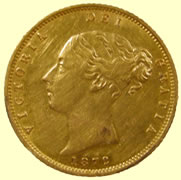 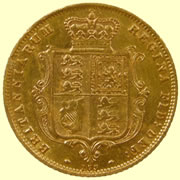
1872 Victorian milled gold half sovereign |
 
19thC gold cufflink - 9 carat |
 
Possible 50BC Remi tribe Celtic gold 1/4 stater - sent to CCI for recording and ID
1.14g,12.55mm
|
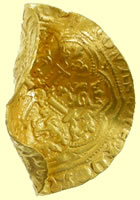  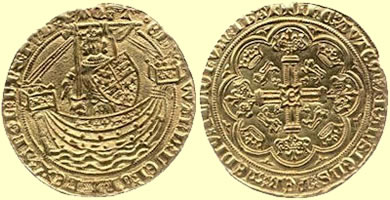
1346-1361 Edward III gold half noble - Closed E at centre of cross - Cross 3 - Pre treaty
Obv EDWAR D GRA (DEI G) REX ANGL AZ FRANC
25.10mm, 3.80g |
  
Early medieval gold ring 15.26mm dia, 2.08g- folded gold construction - reported to Colchester museum as treasure |
 
10 to 40 AD Cunobelin Celtic gold qtr stater - sent to CCI for recording
12.41mm, 1.26g
Thanks for the Cunobelin quarter from *****, CCI 09.3504.
It can be tricky to tell the various types apart because with some of them there's no clear dividing line and the Wild and Plastic types in particular are very similar, but this looks like the Plastic type, Van Arsdell 2015-1.
All the best
John
|
 
Taco'd Circa 1350 Edward hammered gold 1/4 noble - Cross 3 -Needs straightening to ID exact type from rev shield.
Obv + EDWARD DEI GRA REX ANGL
Rev
18.92mm. 1.9g |
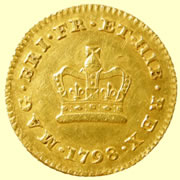 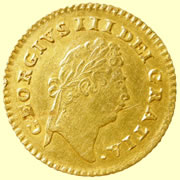
1798 George III milled gold 1/3 guinea |
 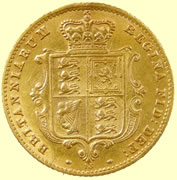
1869 Victorian gold half sovereign |
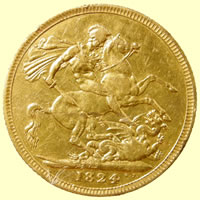 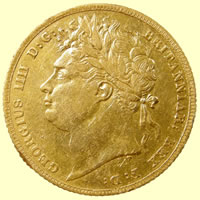
1824 George IV milled gold full sovereign |
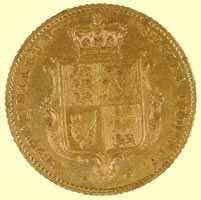 
1844 Victorian gold half sovereign |
 
1855 - 9 carat gold ring - 2.58g, Mintmark Birmingham (anchor G) |
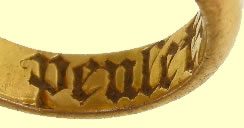 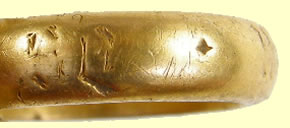


Medieval gold ring - full inscription inside and out - reported to Colchester museum as treasure
inner - PEULET Z (FRENCH NAME )
Outer - SF UNY
17.18mm, 4.17g
|
|
20thC man's gold signet ring |
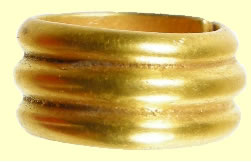 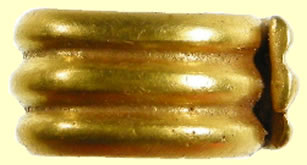 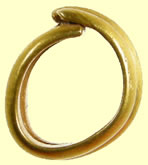
Monster find -Circa 1300 BC Bronze age gold open backed triple banded gold ring
3.48g, 13.73mm dia x 6.74mm H
Reported to Colchester museum as treasure

On display at British museum
|
 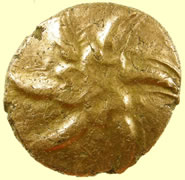
45 BC Addedomaros Celtic gold coin 18.64mm, 5.61g sent to CCI for recording
Very unusual die strike - gold appears to be in an almost non moldern state during the strike
|
 
70BC Morini 'boat tree' type Celtic gold 1/4 stater 1.48g, 10.28 mm
|
 
70BC Morini 'boat tree' type Celtic gold 1/4 stater 1.46g, 11.33 mm
2.87g, 26.93mm |
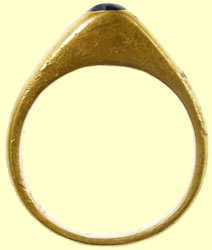 
Medieval gold ring with sapphire - 24.12mm dia, 11.42g - report to Colchester museum as treasure |


C14thC Medieval gold ring 1.31g,20.40mm dia |
 
Georgain gold brooch
|
Total
Gold finds 23 for season 2008/9 |
 
19thC solid gold cufflink
|

19th/20thC gold ring with diamond
|
 
50 BC 1/4 Celtic gold stater 14.32mm, 1.36g Similar to a Southern Commios tribe - Sent to the CCI for recording and ID
|
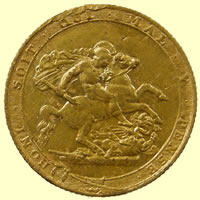 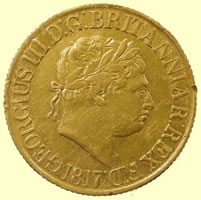
1817 George III full gold sovereign - 8.04g, 22.16mm
|
 
Very interesting die type of a 10 to 40 AD Cunobelin 1/4 gold stater - note the blocked horse. Sent to Celtic Coin index for recording and more information on type 0.83g, 11.84mm
|
 
1844 Victorian gold half sovereign
|
 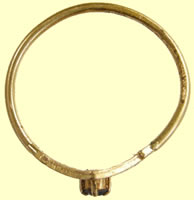 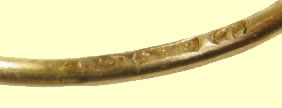
Pretty 18 carat gold ring - Continental hallmarks I have not seen before - no idea of date so reported to Colchester museum as potential treasure
.750 *18 AA CP
20.44mm,1.27g |
 
Medieval gold ring - missing stone 1.01g, 18.99mm dia - reported as treasure to Colchester museum |
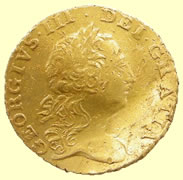 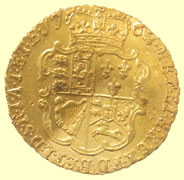
1762 George III gold qtr guinea 2.10g, 15.55mm |
 
 
Medieval gold posey ring with full Lombardic inscription and with the flower possibly representing the wound of Christ- working on the legend to dechiper it - Reported as treasure to Colchester museum 22.38mm O/dia x 1.64mm T , 2.77g
Legend reads : * CN IIS LK VUI CK LOOIJ |
 
Celtic gold stater 16.76mm,5.89g - sent to CCI for recording
'This is quite a rare type, as you no doubt appreciate. The best parallel is provided by three coins in the British Museum, listed in their catalogue as nos. 3353-55. It's one of a group of coins loosely described as the Snettisham staters, because several of the types were first recognized in one of the Snettisham (Norfolk) hoards of the early 1990s. The exact type is not in Van Arsdell although it's closely related to the North Thames types listed as VA 1500, 1502 and thereabouts. It is presumably an East Anglian type, although because of the stylistic similarities there must have been some very strong link between the producers of the Snettisham types and the North Thames types. Date c. 50 - 40 BC, I think.
|
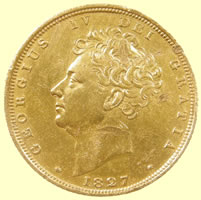 
1827 George IV gold guinea 22.o4mm, 8.03g |
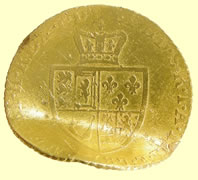 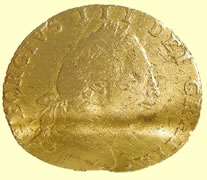
1787 George III milled gold half guinea |
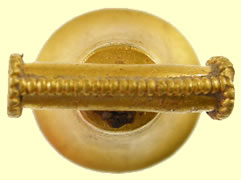  

Roman solid gold hanging pendant ? - 2.65g, 11.95mm H x 10.68mm dia x 11.68mm W |
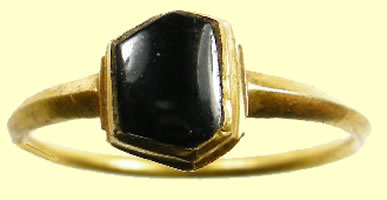  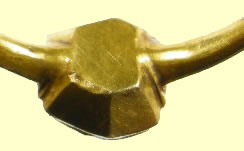
Black Sapphire Medieval gold ring 21.93mmdia,2.51g |
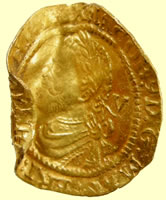 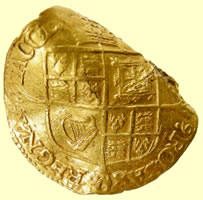
1619 -25 James 1st hammed gold Quarter-laurel - 2.24g, 19.46mm 2nd coinage |
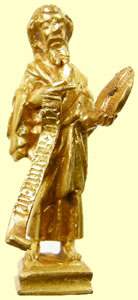 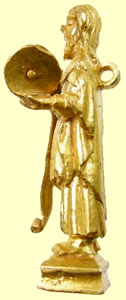 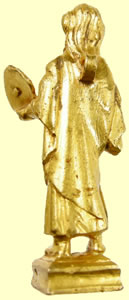
Stunning medieval gold statue pendant - C15th judging by the Lombardic script on the scroll . This is probably to do with the Catholic church (DEI) and one of the members suggested FRCO is St Francis

Script reads ECCE +ANGUS+DEI - reported to Colchester museum as treasure
32.80mm H ,11.46g
Treasure Report: 2008 T581
Parish/County: Tendring District, Essex
A medieval figure of John the Baptist. The saint is shown not in his usual attribute of a camel skin, but in the robes of a prophet. He gestures with his right hand to a salver, which he holds in his left. This was originally designed to carry a lamb, signifying the Lamb of God. A scroll issues from the Saint’s left hand and is inscribed with the words
: ECCE +ANGUS+DEI
(Behold, the Lamb of God)
The figure stands on a small plinth with a finished base. It is designed to be seen in the round and on its back there is a loop for attachment to an object. It would probably have been entirely enamelled, but no traces of enamel survive on the figure.
The figure is gold and dates from the late fifteenth or early sixteenth century.
Dimensions: height 33 mm, width 11 mm, depth 10 mm.
Consequently, in terms of age and as the object contains a minimum of 10% precious metal it qualifies as Treasure under the stipulations of the Treasure Act 1996.
J P Robinson
Curator of Medieval Collections
30th March 2009
|
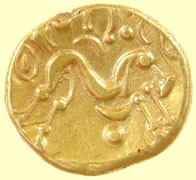 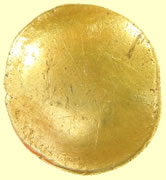
Gallo Belgic 50BC Celtic gold stater 6.38g, 16.96mm sent to CCI for recording |
 
Gallo Belic 50 BC Celtic gold full stater 6.30g, 17.59mm CCI 08.9323 |
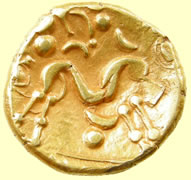 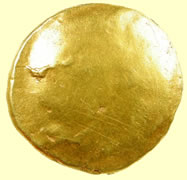
50Bc Gallo Belgic Celtic gold stater - 17.42mm, 6.19g CCI 08.9320
|
| |
 
Victorian gold ring top with glass stones
|
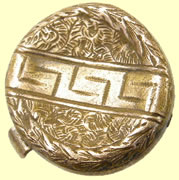
Victorian Gold jewelry clasp (Reading's patent)
|
 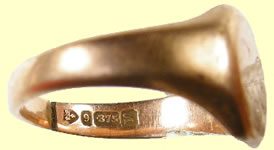
Gold signet ring - Chester hall mark 1921 -4.77g
|
Gold finds were 21 for season 2007/8 |

Solid gold Georgian cufflink |
 
 
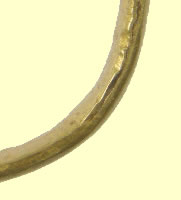
Reported as treasure to the museum and will go on to the British museum for tests and dating. 26.97mm, 4.77g |
 
Cunobelin Celtic gold stater 5.44g, 17.89mm - Northern Gold 'Linear type'
Obv corn ear,to 1 CA, to r.MV, below CA cross
Rev horse r ., pellet, leaf q & pellet, below CVN, pellet boarder va 1925 Ref Hobbs
'Thanks for this, a fine Cunobelin linear stater indeed. There are a few with the pellet over the M within the group listed as VA 1925.05 in the online CCI, at
http://www.finds.org.uk/CCI/images-lister.php?&VA_type=1925.05
Among these coins such as
http://www.finds.org.uk/CCI/details.php?coin_num=0.1532 appear to be from the same pair of dies as yours. I'll record it as CCI 08.9151.'
|
 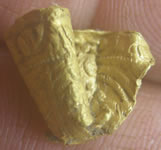 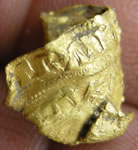
1344 Edward III gold qtr noble - 3.89g |
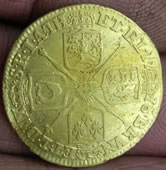 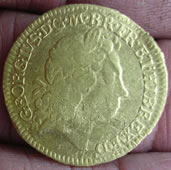
1718 George 1st gold half guinea - 4.14g, 21.35mm |
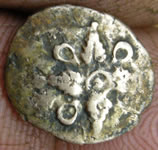 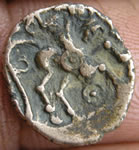
1.26g, 13.19mm
Celtic gold 1/4 stater Addedomarus Floral Trinovantes tribe, 30 BC sent to CCI for recording |
  

 
Stunning c 13thC Medieval engraved gold ring found by Idaho Travis - reported as treasure to the museum
1.23g, 19.50mm dia |
 
Fourth coinage 1356-61 Edward III hammered gold 1/4 Noble Type C Annulet stops 1.96g, 20.36mm
Obv shield quartered with the arms of England and France within a treassure of eight arches - EDWARD GRA REX :ANG. . HY Cross 3(4 )
Rev EXALTABITAR IN GLORIA
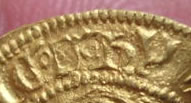
Annulet stops |

Georgian gold signet ring fragment |
 
70BC Morini 'boat tree' Celtic gold qtr stater - sent to CCI for recording
11.07mm, 1.48g
Thanks for this, what a good start to the season!
I think it's still stars - it would be nice to think that it's an
inscription but I'm afraid I'm not convinced. Sometimes the stars are a
little elongated so it can give the impression of letters, but I'll need
a bit more convincing yet. Anyway it's a very fine coin, good to see so
much detail on both sides.
This'll be CCI 08.9087.
|
 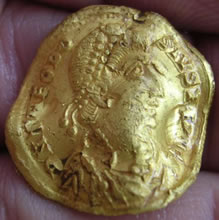
Late 4thC - Theodosius I- solidus - 388-392 AD 4.40g, 20.26mm sent off for ID
This is, as you later suspected, Theodosius I rather than Magnus Maximus. A solidus of "Mag Max" would be a great item to find - Kipling included him as a character in "Puck of Pook's Hill" with a vividly-drawn, if fairly historically inacurate portrait. He's a good bit scarcer, in general, than Theodosius I, but the coin we're looking at today carries an "R2" rating in RIC, so it's pretty scarce as well.
This is a Solidus - the denomination introduced by Constantine the great which would continue to be struck with very little variation in weight or fineness for nearly another thousand years as it became the flagship coin of the Byzantine empire.
Your specimen was minted at Trier, between 388 and 392 A.D. The "COM" in the exergue refers to it being pure gold - the mint designation is the T - R to either side of the two characters on the reverse - who are meant to be 2 co-regnal emperors - the basic design goes back to the time of Valentinian I and Valens, but continued until, at this time, it was supposed to be Valentinian II and Theodosius I as the 2 senior Augusti, there was however (throughout the era) a 3rd and even, at times, a 4th emperor.
The obverse legend is D N THEODOSIVS P F AVG - with the normal diademed draped and cuirassed bust right.
The reverse is VICTORIA AVGG (the 2 "G's" abbreviating "Augustorum" referring to multiple emperors) and shows the 2 emperors, presumably Valentinian II and Theodosius I seated facing, holding a globe between them, the top half of Victory between and spreading her wings above them.
RIC IX Trier 90b.
Congratulations to you and the digger - What a great find!
Mark
|
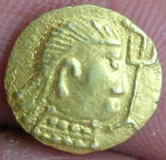 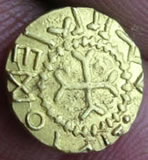
English Saxon Thrymsa gold coin - Crondall types c620 -650 AD named after the hoard found in 1828. Sent off to the Fitzmuseum Corpus database for recording 1.26g, 11.46mm
EMC 2007.0302.
'Witmen type' |
|
|
|
Solid
gold Georgian cufflink |
Interesting Celtic gold find - it appears to be the first right facing Dubnovellaunus Late 1st BC to Early 1stC AD Full Celtic gold stater found here 5.73g, 17.13mm
'This is quite a rare type, as you no doubt appreciate. The best parallel is provided by three coins in the British Museum, listed in their catalogue as nos. 3353-55. It's one of a group of coins loosely described as the Snettisham staters, because several of the types were first recognized in one of the Snettisham (Norfolk) hoards of the early 1990s. The exact type is not in Van Arsdell although it's closely related to the North Thames types listed as VA 1500, 1502 and thereabouts. It is presumably an East Anglian type, although because of the stylistic similarities there must have been some very strong link between the producers of the Snettisham types and the North Thames types. Date c. 50 - 40 BC, I think.
I'll record it as CCI 07.1164. '
Philip
|
|
|
|
Dubnovellaunus
Late 1st BC to Early 1stC AD Full Celtic gold stater
5.44g,17.57mm
- sent to Celtic coin index for recording |
|
|
|
|
1852
Victorian gold half sovereign |
Gold
nugget. It weights 2.17g,and is approx 6.73mm dia. I took it with
me to the local museum as I was dropping off a bunch of our latest
treasures.
The museum took a looked at it and said it should be reported
as treasure so it will now go off to the British museum for tests.
It could well turn out to be a Celtic gold nugget, what a great
find. |
|
|
|
|
|
|
1817
George III gold half sovereign - new coinage type |
1843
Victoria gold half sovereign |
|
|
Gold Victorian buckle |
|
|

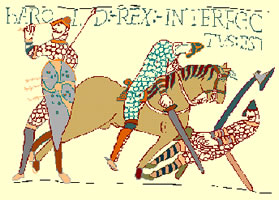


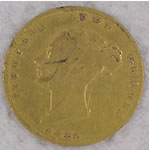
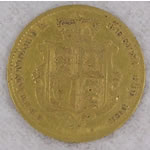
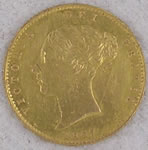
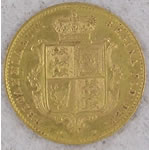


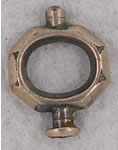

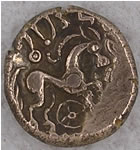
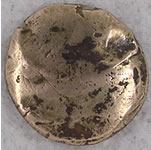
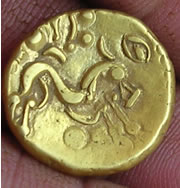





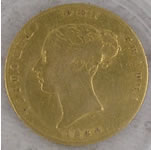

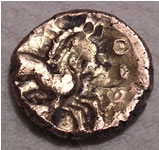



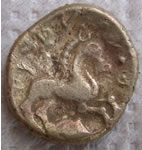
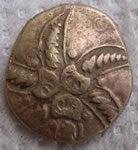




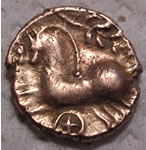

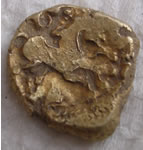
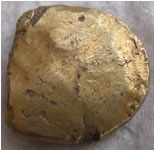


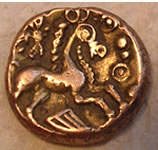
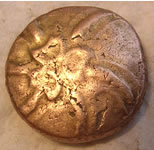
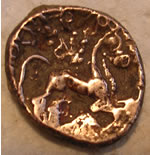
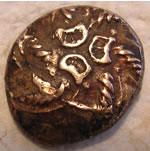
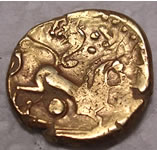
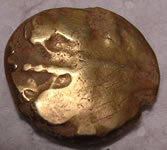
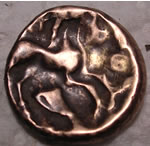
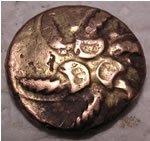
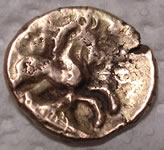
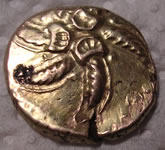
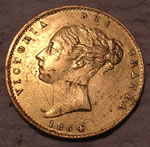
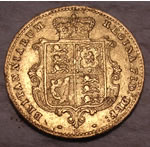

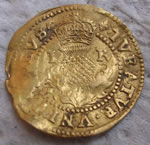
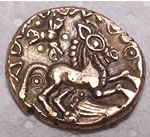
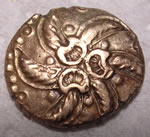

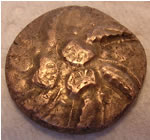


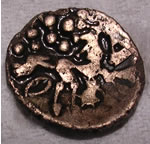
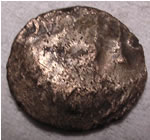

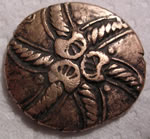


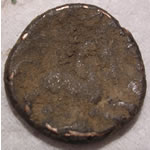


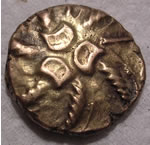
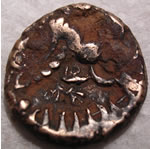
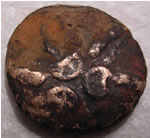
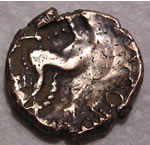
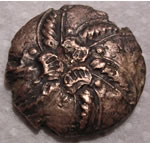
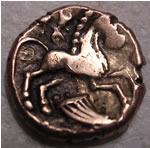
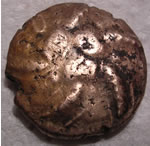
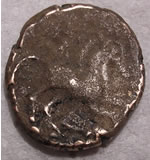
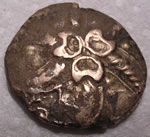
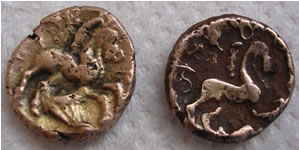
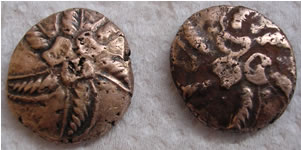
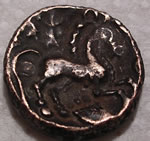
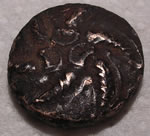
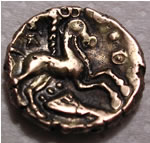
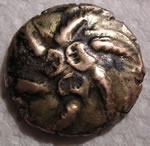


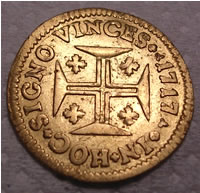
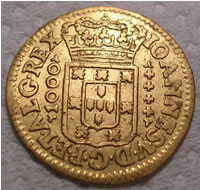
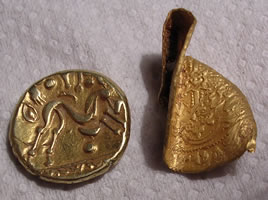


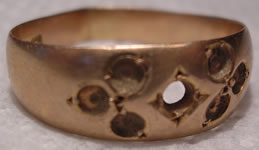
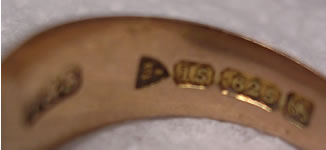
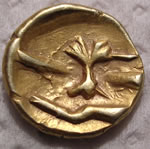
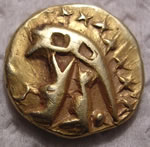

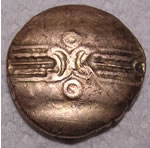
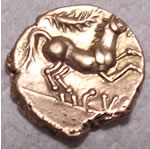
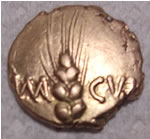
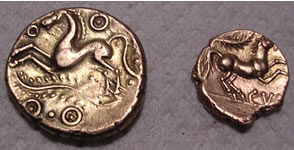
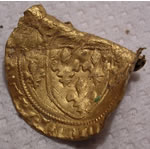
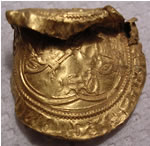

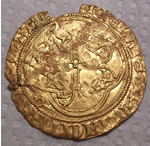

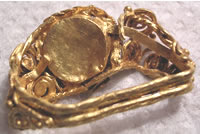
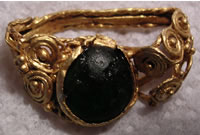

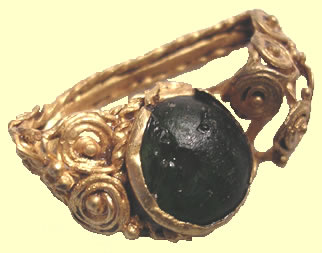
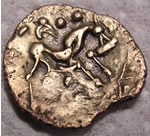
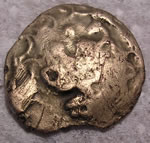
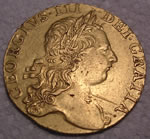
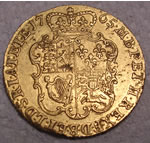
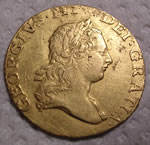




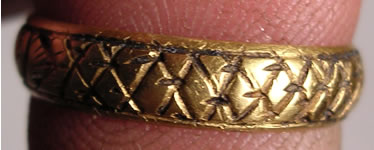 (b)
(b)
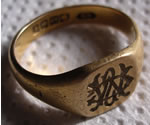
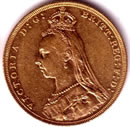
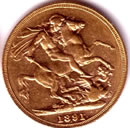
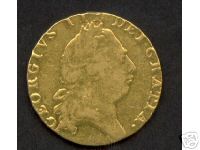
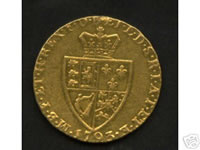
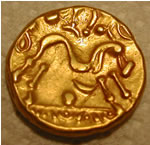
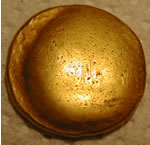
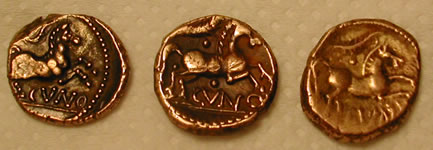


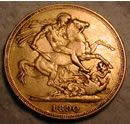
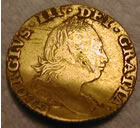
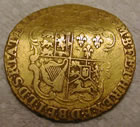

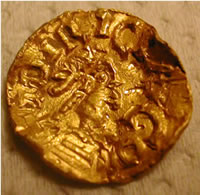
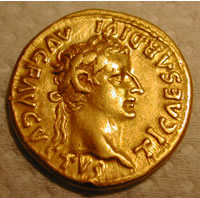
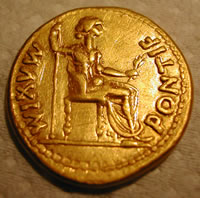

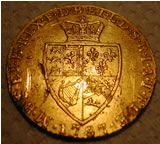
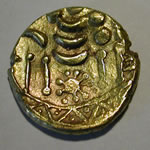
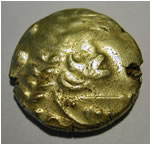
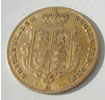
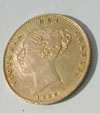
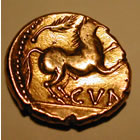
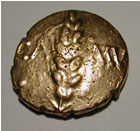

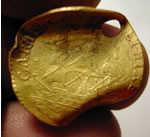
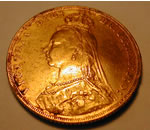
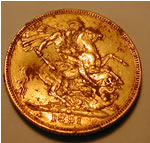

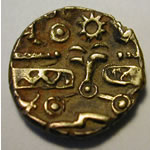
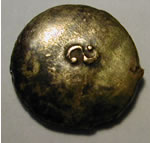

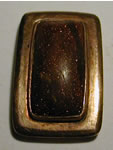

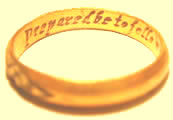
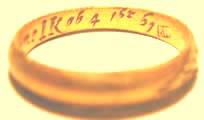
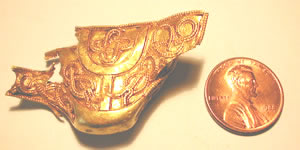
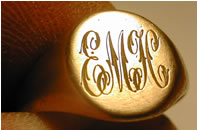 (c)
(c)